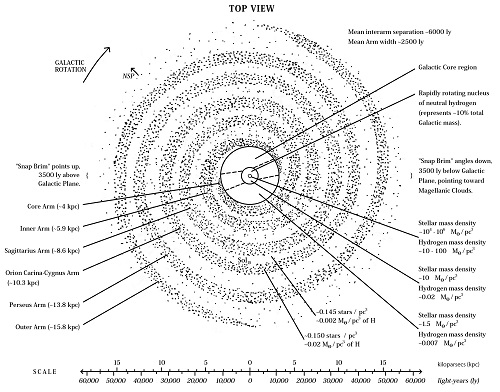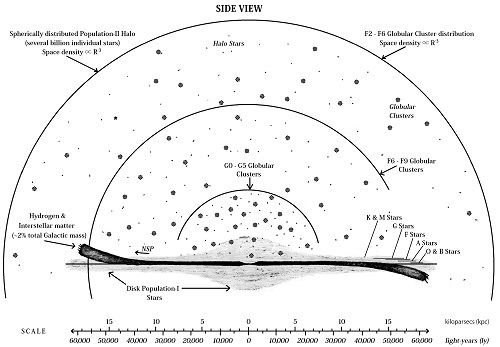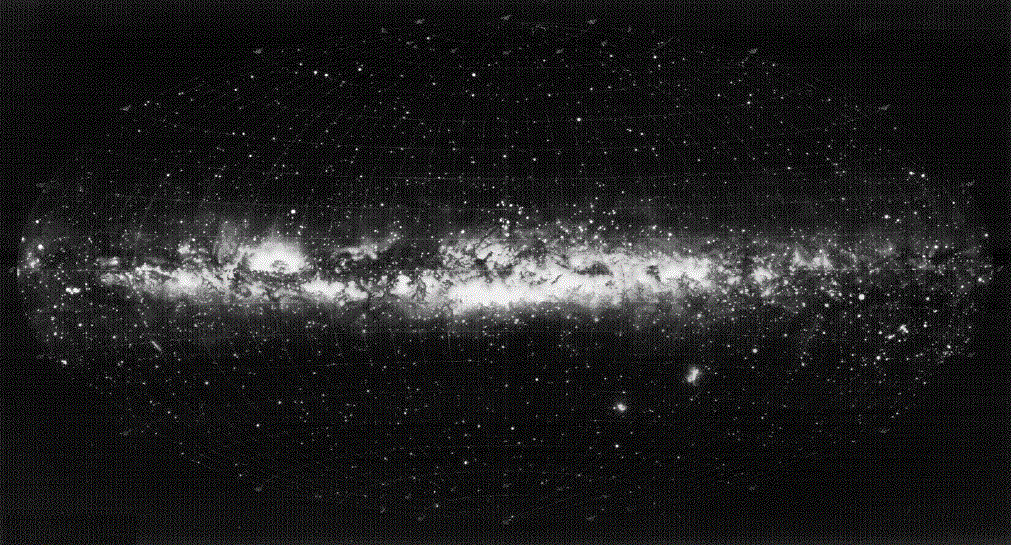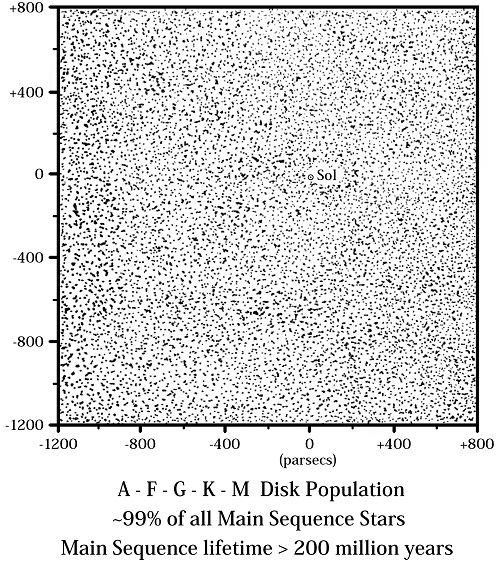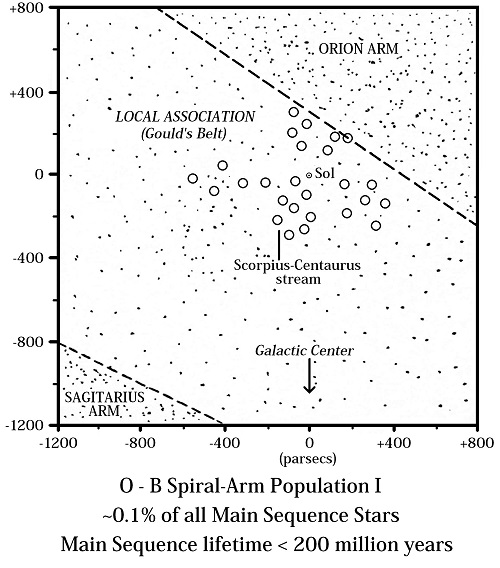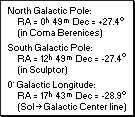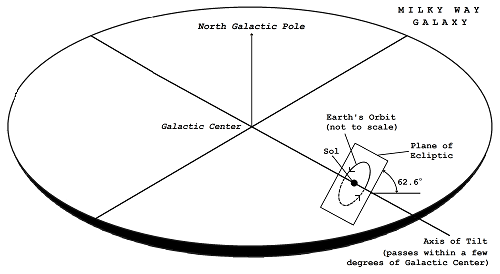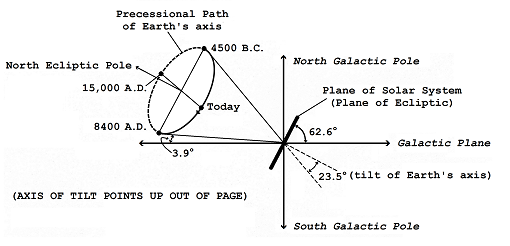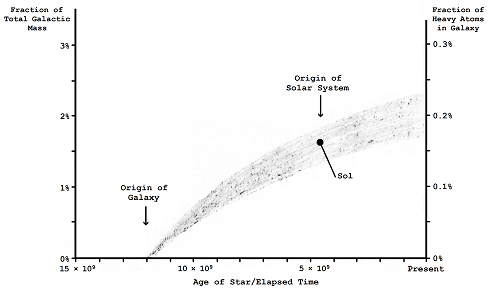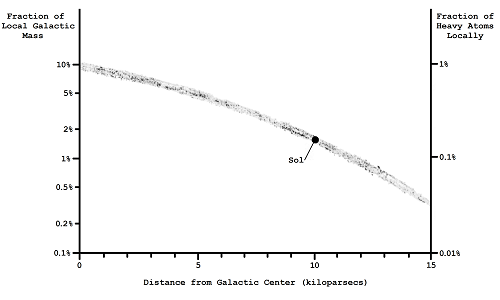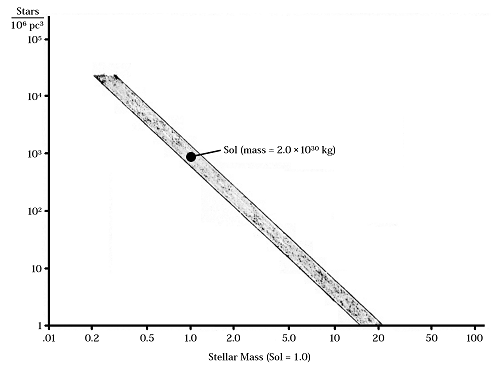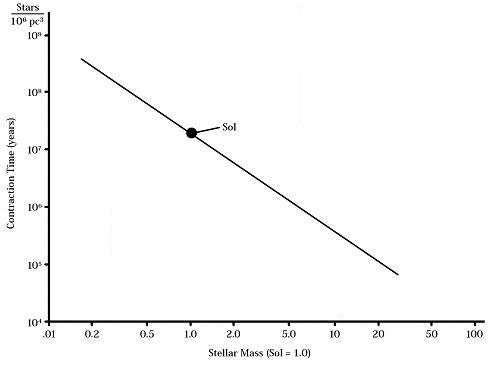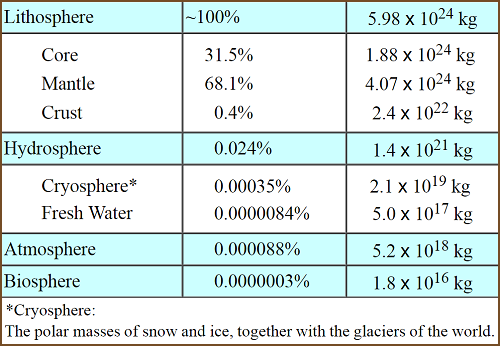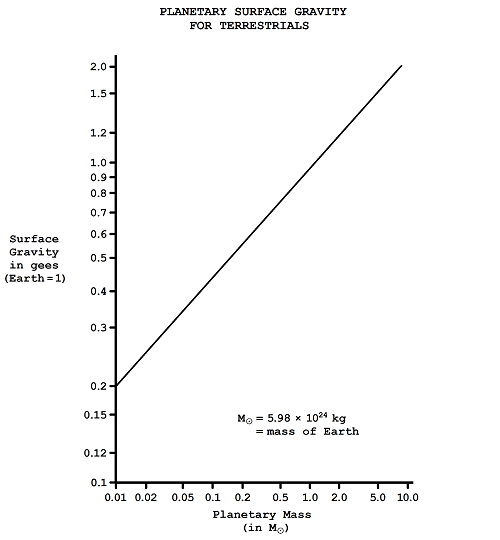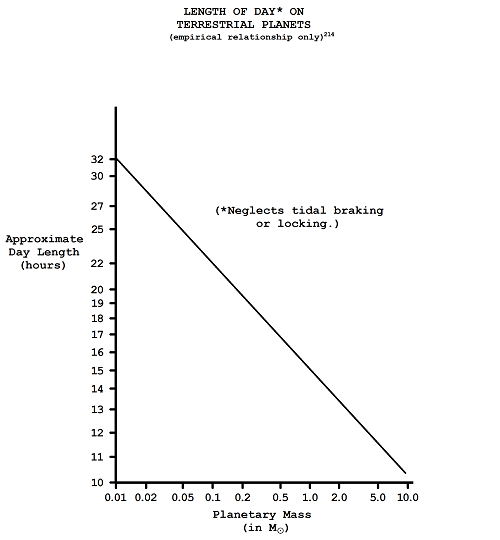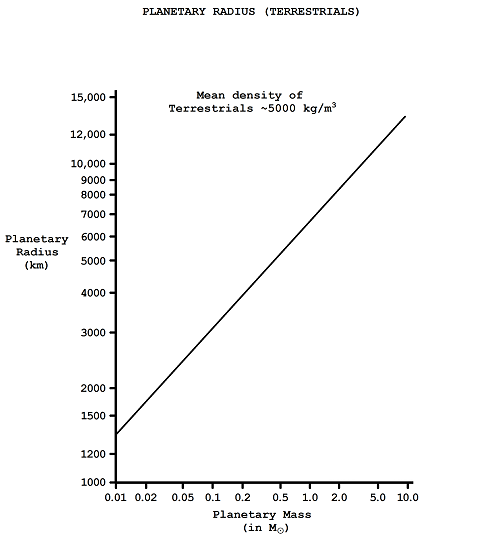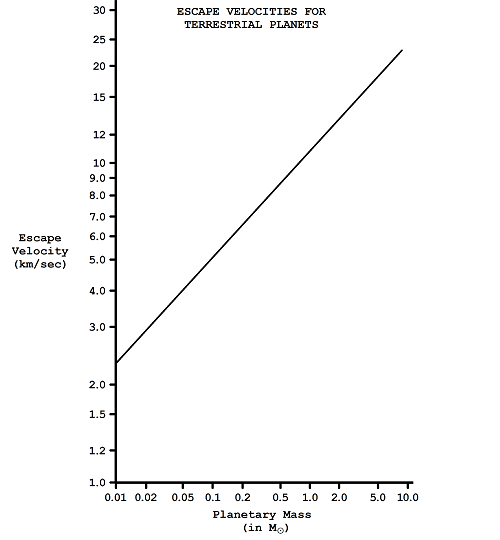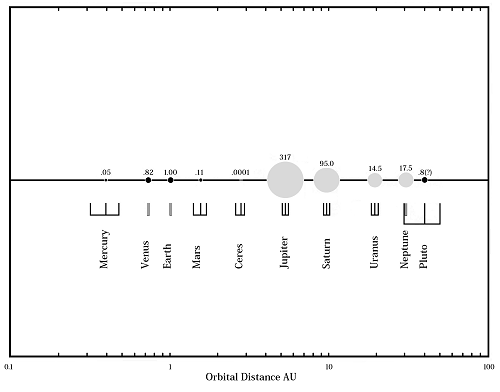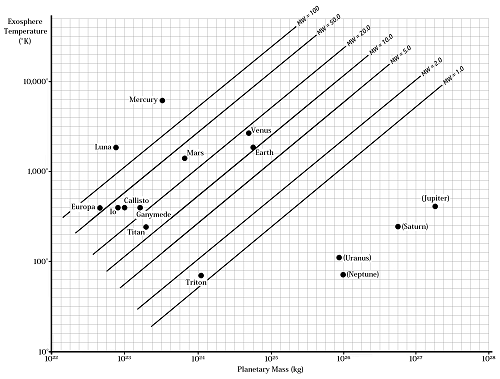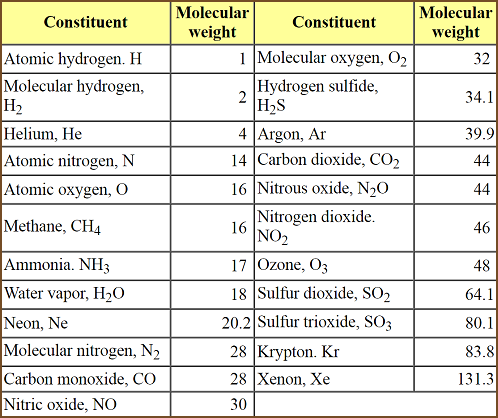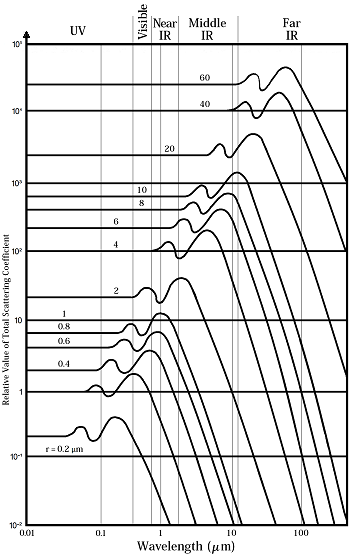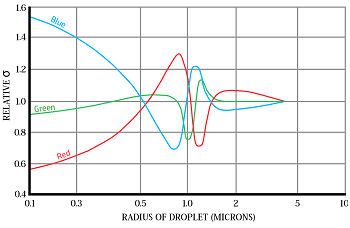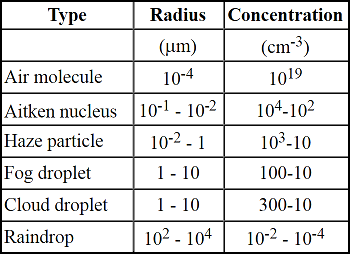© 1979 Robert A. Freitas Jr.
All Rights Reserved
 The idea that intelligent but nonhuman living beings might exist somewhere has tantalized the minds of men since the dawn of recorded history. Virtually every civilization or major culture on Earth has entertained some such speculation, whether in its mythology, its religious or scientific writings, or in its philosophy of nature.
The idea that intelligent but nonhuman living beings might exist somewhere has tantalized the minds of men since the dawn of recorded history. Virtually every civilization or major culture on Earth has entertained some such speculation, whether in its mythology, its religious or scientific writings, or in its philosophy of nature.
The sophisticated concept of aliens indigenous to planets circling faraway stars did not blossom into existence overnight, however. The theme of extraterrestrial life has slowly evolved over the course of many millennia of pensive human contemplation. Before it was accepted that Earth was a mere planet and that many others could exist, intelligent nonhuman beings were commonly viewed in a mythological context. But as man learned to appreciate the vast scale of the universe, the idea of life in the physical cosmos matured and gained wider currency.*
* There are many good historical introductions to both the scientific747, 1754, 1769, 1872 and the fictional1896, 1897, 1872 literature.
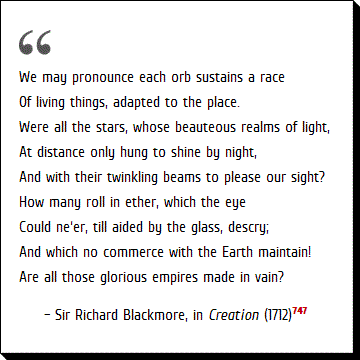
| ETs in Sumeria |
While it is often pointed out that aliens appear in the most ancient of human records, the true antiquity of the idea is rarely appreciated. An excellent example comes from the Sumerian civilization, which flourished more than five thousand years ago (and may well be the most distant ancestor of Western culture). According to Sumer legends which have survived, codes of law, science, art, architecture and the essentials of proper social behavior all were given to the humans by alien teachers — amphibian intelligent animals with fishy heads and torsos and human feet. These creatures are never described as gods; there is little doubt the Sumerians presumed them to be as mortal as their human students.20
Usually, though, ancient gods were seen as superior beings with celestial abodes. The Babylonians, successors to the Sumerian civilization, held that the moving points of light in the sky which are the planets were the homes of their gods.45 Other cultures such as the Eskimos believed that the Moon and other heavenly objects were themselves gods.1872
Supposing the world to be flat and subscribing to the nontheistic Confucian philosophy, the venerable Chinese had no conception of or need for life in the firmament — although dragons and other monsters appeared frequently in the literature. The holy books of Buddhism, on the other hand, appear to accept the plurality of worlds in countless numbers, complete with indigenous alien plant and animal lifeforms.1898
| ETs in Asia |
The ancient Vedda culture, which prospered on Ceylon prior to the Hindu invasion in the 6th century B.C., held that after death souls migrated to the Sun, Moon, and the stars before reaching Nirvana (the ultimate state of perfection). The beliefs of the Hindus are also closely associated with the idea of a plurality of worlds. The Indian philosophy, in fact, "explicitly assumes the existence of extraterrestrial intelligences."1899 In one myth, as told in the Brahmavaivartcz Purana of the god Indra, we find:
Hold! I have spoken only of those worlds within this universe. But consider the myriads of universes that coexist side by side, each with its Indra and Brahma, and each with its evolving and dissolving worlds … Can you presume to know them, count them, or fathom the reaches of all those universes with their multitude of worlds, each with its legions of transmigrating inhabitants?1901
The Old Testament is filled with strange events which some have argued may be linked with extraterrestrial visitations — such as the visions of Ezekiel.1058 And in the New Testament appear such positive statements as: "In my Father's house there are many mansions" (John 14:2), and so forth.
| ETs and the Greek and Roman cultures |
But by far the most important early contributors to the advancement of the idea of ETs were the Greek and Roman cultures. To the Homeric Greeks, the Moon was an inhabited world separate from Earth, the dwelling place of protean gods and the spirits of departed humans.1753 Traditional Grecian mythology held that the universe created the gods, a view more consistent with the concept of mortal, fallible aliens than the usual creator-deity of other religions.
The Greek culture inherited considerable astronomical knowledge from the Egyptians and Babylonians upon which much speculation could be based. Thales of Miletus (6th century B.C.) was a philosopher who had guessed that heavenly bodies might have a material composition similar to that of the Earth. Around this time Pythagoras (well-known for his contributions to geometry) and others were beginning to think of Earth as a globe in space — a sharp break from the flat-world concepts of earlier thinkers.
Since other earthlike worlds might therefore exist, Xenophanes of Colophon — a contemporary of Pythagoras — populated the Moon with inhabitants, cities and mountains.602 Another Greek philosopher named Anaximenes evidently also believed in a multitude of celestial habitats, because he had the audacity to tell Alexander the Great that the Macedonian king had conquered "only one of many worlds."702
In the 5th century B.C. Democritus taught the concepts of infinite space and numerous worlds.747 One of his pupils, Metrodorus of Chios, later wrote that "to consider the Earth the only populated world in infinite space is as absurd as to assert that in an entire field sown with millet only one grain will grow."20 Anaxagoras too embraced the plurality of worlds: "The Sun, the Moon, and all the stars are stones on fire. The Sun is a red-hot mass, or a stone, on fire. The Moon is of earthy nature … an incandescent solid, having in it plains, thountains, and ravines!" 1872
Another 5th century mathematician of the Pythagorean school stated his views on extraterrestrial most forthrightly:
The Moon has an earthy appearance because, like our Earth, it is inhabited throughout by animals and plants, only larger and more beautiful than ours: for the animals on it are fifteen times stronger than those on the Earth … and the day in the Moon is correspondingly longer... 1872
And from The Travels of the Young Anacharsis in Greece, written sometime during the 4th century B.C., we have:
As nature is even richer by the variety than by the number of the species, I spread in the various planets … peoples who have one, two, three, or four senses in supplement. I then compare their geniuses with those Greece has produced, and I must confess that Homer and Pythagoras inspire my pity." 362
About this time the first "Moon romance" was written by Antonius Diogenes. His Of the Wonderful Things beyond Thule included a visit to the Moon; unfortunately, the original text has not survived.1872
The Roman poet and philosopher Lucretius firmly believed in a host of inhabited worlds. As he wrote in De Rerum Natura:
Why then you must confess that other worlds exist in other regions of the sky, and different tribes of men, kinds of wild beasts.... Nothing in nature is produced alone, nothing is born unique, or grows unique, alone. Each thing is always specimen — of race or class, and many specimens belong to each.... That sky and Earth and Sun and all that comes to be are not unique but rather countless examples of a class." 733
Unfortunately for xenology, the Earth-centered (geocentric) cosmologies sponsored by Plato and Aristotle held sway. Both philosophers were firmly opposed to the concept of a plurality of worlds. Aristotle asserted that all matter was contained in this world, thus leaving no room for any others. The unchangeability of the heavens was cited as additional proof of this.45 These teachings were later picked up by the Christian Church and enforced as law. It was then denied that any knowledge could exist that Aristotle had not known.
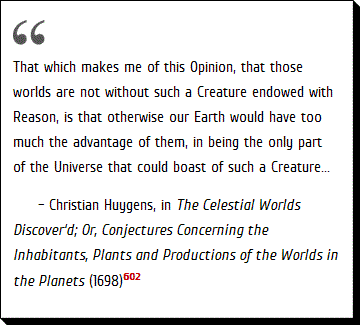 Despite the powerful forces arrayed behind the Aristotelian world view, it took time to halt the intellectual momentum in favor of habitable worlds. The famous Roman poet Cicero was interested in the possibility of living beings on the Moon, and his Somnium Scipionis may have inspired Plutarch (46 A.D. - 120 A.D.) to write his account of a visit to the Moon. In Facies in Orbe Lunare, after dealing with various problems involved in reaching the Moon, the Greek historian endorsed the Pythagoreans thus: "They affirm that the Moon is terrestrial and inhabited like the Earth, peopled with the greatest living creatures and the fairest plants..."1753 He continues:
Despite the powerful forces arrayed behind the Aristotelian world view, it took time to halt the intellectual momentum in favor of habitable worlds. The famous Roman poet Cicero was interested in the possibility of living beings on the Moon, and his Somnium Scipionis may have inspired Plutarch (46 A.D. - 120 A.D.) to write his account of a visit to the Moon. In Facies in Orbe Lunare, after dealing with various problems involved in reaching the Moon, the Greek historian endorsed the Pythagoreans thus: "They affirm that the Moon is terrestrial and inhabited like the Earth, peopled with the greatest living creatures and the fairest plants..."1753 He continues:
It is possible that some inhabitants exist on the Moon; and those who claim that these beings must need everything that is necessary to us, have never considered the variety that nature offers so that animals differ amongst themselves more than they differ from inanimate life.
Only forty years after the death of Plutarch, the Greek satirist Lucian of Samosata (125 A.D. - 190 A.D.) wrote the first interplanetary romance that has survived the ravages of time.1872 In his elaborate True History Lucian and his fellow travelers are carried by whirlwind to the Moon, found to be inhabited by a race of men who ride on the backs of three headed birds. The adventurers have arrived at a most inopportune moment, as the Lunarians are in the middle of a war with the inhabitants of the Sun to settle a dispute over the colonization of Venus.1753 The space troops include such marvelous creatures as "Horse-vultures," "Salad-wings," and "Flea-archers" (archers astride giant lunar fleas).742 The story is reminiscent of the "space opera" of the 1930's and 1940's.
But after Lucian there was no further debate of the possibility of visiting other worlds and meeting the indigenous lifeforms there — for more than a thousand years! This may probably be attributed to the pervasiveness of the Church philosophy and its rigid opposition to the idea of the plurality of worlds. The pronouncement of Franciscus Gratianus, Bishop of Chiusi, in 1145 A.D. was perhaps typical: The belief in many worlds was to be condemned as heresy.
| ETs and the Church |
Of course, there was a serious logical flaw in this stance. If God really was all-powerful, why was he only able to create one world? Conversely, if only one world existed how could God possibly be truly infinite and omnipotent? The theologian Thomas Aquinas (1225 - 1274) came up with a "solution" to the problem: God had the power to create infinite worlds, but all the matter in the universe had been used to construct Earth!372
Despite the obvious holes in this reasoning, the Church subsequently partially reversed its extreme position. In 1277, under the authority of the Pope, the Bishop of Paris decried as new heresy the belief that a plurality of worlds was impossible!45 This did not, of course, mean that the Church began to teach the plurality of worlds. According to the physics of Aristotle, still in vogue until the 16th century, if any other worlds did exist they would have to gravitate to the center of the universe (where Earth was). But it became wrong to suggest that God could not create many worlds if He wished.747
The debate was far from ended. In 1410 the Jewish philosopher Crescas wrote: "Everything said in negation of the possibility of many worlds is vanity and a striving after wind." Still, he was unwilling to stick out his neck very far:
… yet we are unable by means of mere speculation to ascertain the true nature of what is outside this world; our sages, peace be on them, have seen fit to warn against searching and inquiring into what is above and what is below, what is before and what is behind...747
The first really explicit deviation from orthodoxy occurred during the Inquisition in Europe in the mid-fifteenth century. Cardinal Nicolas of Cusa, Bishop of Brixen and Christian philosopher, wrote a book called Of Learned Ignorance (1440) in which he stated:
Rather than think so many stars and parts of the heavens are uninhabited, and that this Earth or ours alone is peopled … we will suppose that in every region there are inhabitants, differing in nature by rank and all owing their origin to God.747
Considering how little we know about other animals here on Earth, he claims, "of the inhabitants … of worlds other than our own we can know still less, having no standards by which to appraise them."747 It is said that Cusa escaped the Inquisitional wrath only by virtue of his special protection and friendship with Pope Eugene IV.1753
As astronomical observations became more accurate, the geocentric Aristotelian/Ptolemaic world view began to generate problems that were difficult to resolve. Calculated positions of the planets, for instance, were invariably in error. This necessitated the concoction of elaborate "explanations" based on a kind of astronomical fudge factor.
During this time the first tale of interplanetary travel since Lucian (thirteen centuries earlier) was published. Ludovico Athsto's (1474-1533) Orlando Furioso tells of a trip to the Moon using a chariot driven by Saint John. The vehicle is drawn by flaming horses, who leap from the summit of a high mountain. The Moon, it turns out, is littered with cities and townships. The heavy theological flavor of the story may have helped save Ariosto from persecution.
A mere eleven years later the first edition of Copernicus‘ renowned De Revolutionibus Orbium Caelestium appeared, proposing the modern Sun-centered (heliocentric) solar system. If the Holy See was enraged at this they could do nothing, for the Polish astronomer died the year his book came out — 1543.
| Giordano Bruno |
Others were not so lucky. Forty one years after the death of Copernicus a Dominican monk by the name of Giordano Bruno (1547-1600) wrote his controversial On the Infinite Universe and Worlds. Among other things, the Italian philosopher advanced the following heterodoxies: "Innumerable suns exist; innumerable earths revolve about these suns in a manner similar to the way planets revolve around our sun. Living beings inhabit these worlds."20
Although Bruno was visiting in relatively tolerant Great Britain at the time his book was published,747 as soon as he set foot on Italian soil he was promptly arrested by the Church and incarcerated without trial for seven years.45 He was then convicted of heresy by a tribunal of the Holy See and sentenced to death. Bruno was burned at the stake in the Campo de' Fiori in Rome on February 17, 1600.
With the improvement of the telescope by Galileo (1564-1642) and the subsequent observations of the mountainous terrain of the lunar surface, it became clear that the Moon was quite similar to the Earth in many ways. His discovery of the four largest Jovian satellites confirmed the existence of many worlds. For his part in advancing the heliocentric Copernican astronomy and the hypothesis of the plurality of worlds, Galileo was arrested by the Inquisition and forced to recant his heresies. Luckily, he was not executed.
Johannes Kepler (1571-1630) further refined the Sun-centered cosmology by suggesting that planets move in ellipses rather than perfect circles. He also authored an engrossing fictional account of a trip to the Moon, published four years after his death, entitled Somnium. Lunar biology is described in some detail, including several forms of vegetation and serpentlike grotesque monsters.742
The first narrative of a trip to the Moon written in English was penned by Bishop Francis Godwin in 1638. In The Man in the Moone the main character, Domingo Gonsales, uses a team of trained geese under harness to carry him to the Moon whereupon:
Suddenly I saw myself environed with a kind of people most strange, both for their feature, demeanure, and apparel. Their stature was most diverse, but for the most part twice the height of ours; their color and countenance most pleasing, and their habit such as I know not how to express....1872
By 1640 another book was out, a two-volume set by fellow English Bishop John Wilkins, entitled The Discovery of a World in the Moone. Wilkins asserted his straightforward belief "that it is possible for some of our posterity to find out a conveyance to this other world, and if there be inhabitants there, to have commerce with them."747
The roadblocks to the idea of intelligent alien life on other worlds were rapidly disintegrating.
 By the early and mid-1600's the utilization of the Moon and other planets as abodes for extraterrestrial life had become an accepted theme, certainly in fiction but also increasingly in scientific writings of the time. In the 17th century — the century of great discoveries, scientific breakthroughs and grand geographical voyages around the world — more than 200 accounts of trips to the Moon appeared in print.1896
By the early and mid-1600's the utilization of the Moon and other planets as abodes for extraterrestrial life had become an accepted theme, certainly in fiction but also increasingly in scientific writings of the time. In the 17th century — the century of great discoveries, scientific breakthroughs and grand geographical voyages around the world — more than 200 accounts of trips to the Moon appeared in print.1896
In 1656 the Jesuit Athanasius Kircher sent his hero touring the heavens with an angel as his guide. In the course of these journeys, the Moon was found to be quite habitable, including mountains, oceans, lakes, islands and rivers.1872
| Life on the Moon |
About a decade later in Milton's well-known Paradise Lost, the angel Raphael discusses the possibility of life on the Moon and other planets. Says he of the Moon:
Could not there be
Fields and inhabitants? Her spots thou seest
As clouds, and clouds may rain, and rain produce
Fruits in her softened soil, for some to eat
Allotted there; and other Suns, perhaps,
With their attendant Moons…
But Adam is cautioned that it is dangerous to cogitate such matters, as they are best left to the Almighty: "Dream not of other worlds, what creatures there live, in what state, condition or degree."702
David Russen in A Voyage to the Moon (1703) allowed that there might be inhabitants on the Moon, but that traveling there would be difficult because of the lack of air between worlds.742 In Robert Paltock's John Daniel (1751), a survivor of a shipwreck constructs a flying machine to escape his island prison but winds up escaping the Earth instead! On the Moon he finds copper-skinned humanoids who live in caves and worship the Sun.742 And in 1775, a Frenchman named Louis-Guillaume de la Follie published an account of the doings of beings on Mercury. In Philosophy Without Pretension, a brilliant Mercurian inventor-scientist constructs a flying machine which carries a skeptical fellow scientist to Earth and maroons him here.45
But the fictional treatments of extraterrestrial life in the late 17th and 18th centuries were executed with a growing eye to satire and witty criticism of the foibles of modern civilization. Despite the increasing interest among the scientific community in alien life, fictional tales remained remarkably free of science and technical accuracy.
For example, two of the best-known early adventure stories were Cyrano de Bergerac's (1620-1655) Voyage to the Moon (1657) and History of the States and Empires of the Sun (1662) (which was uncompleted at his death) . In the first of these tales, the narrator wears bottles filled with morning dew which are attracted to the Sun — everyone knows dew rises! — and eventually transport him to the Moon. There he meets Domingo Gonsales and his trained geese, and the lunar queen and her court are a cruel mockery of the monarchy of contemporary England.1872
Gabriel Daniel's novel A Voyage to the World of Descartes (1694) is a satire on the dualist philosophy of Descartes. Daniel's travelers found the Moon to be inhabited only by spirits.742 Voltaire's characters in Micromegas (1752) are extraterrestrials: One is a dwarf from Saturn with 72 different senses, and the other is a giant eight leagues tall from the Sirius star system possessing more than a thousand different senses. The story is a satire on the supposed intelligence of mankind, as it might be evaluated by objective aliens.742 And Aratus' narrator in his A Voyage to the Moon (1793) treks to Luna by hot air balloon, landing on an island peopled with lipedal snake-like organisms that speak English. The book caricatures British social and political life by describing the civilization of the man-snakes in a most derogatory fashion.742
Another main thrust during this era of development was along religious lines. As the astronomers during the 1600's came to accept the plurality of worlds, an assumption arose that God would never knowingly "waste" a world.747 This view, which persisted well into the 19th and even 20th centuries,95, 103, 117, 206, 599 held that if worlds did exist in space their only real purpose could be to harbor manlike beings.1902
In this vein, Ralph Cudworth wrote in The True Intellectual System of the Universe (1678): "It is not reasonable to think that all this immense vastness should lie waste[d], desert[ed], and uninhabited, and have nothing in it that could praise the Creator thereof, save only this one small spot of Earth."747 The Anglican theologian Thomas Burnet followed suit six years later in a book called The Sacred Theory of the Earth, wherein he asked:
God himself formed the Earth … he formed it to be inhabited. This is true, both of the Earth and of every habitable World whatsoever. For to what purpose is it made habitable, if not to be inhabited? We do not build houses that they should stand empty, but look out for Tenants as fast as we can.747
In a sermon preached by a young English clergyman named Richard Bentley in 1692, we find still more evidence of the new viewpoint that swept over Christianity in only a century: "It remains, therefore, that all bodies were formed for the sake of intelligent minds … each for their own inhabitants which have life and understanding."747 William Derham, another minister and author of the popular work Astrotheology (1715), was of the same opinion.
| ETs and colonial America |
Nor was colonial America immune to these new exotheological conceptions. Cotton Mather (1663-1728), a Puritan minister who wrote a book called The Christian Philosopher, had this to say: "Great God, what a Variety of Worlds hast thou created! How stupendous are the Displays of thy Greatness … in the Creatures with which thou hast replenished those Worlds!"*747 During this entire period of literary and theological development, scientific speculation on the nature of extraterrestrial life was on the upswing. Spaceflight to other worlds was no longer viewed as wholly impractical; when Peter Heylyn compiled his World Geography, the Moon was described along with such other "imaginary" lands as Australia, New Guinea, and the Solomon Islands.1872
Bernard de Fontenelle's Conversations about the Plurality of Worlds came out in 1686 and was an instant success. Not only did de Fontenelle conclude that intelligent beings must exist on worlds other than Earth, but he advanced the progressive notion that such beings would have those characteristics consistent with the environment of the world in which they lived.
Mercurians, therefore, were all hotheads in temperament. The inhabitants of Venus, the next planet out from the Sun, "resemble the Moors of Granada, a small, black people, burned by the Sun, full of wit and fire, always in love, writing verse, fond of music, arranging festivals, dances and tournaments every day." Jupiterians rarely encountered each other, since their planet was so large, and the extreme coldness of Saturn rendered the creatures there dull, torpid and sluggish in mind and body. It was suggested that the Moon might not be inhabited at all, because of the thinness of the atmosphere.1950
| ETs and scientific discovery |
The first full-length scientific book to deal seriously and specifically with the problem of extraterrestrial life was authored by the Dutch physicist and astronomer Christian Huygens. Entitled The Celestial Worlds Discover'd (1698), it contained many detailed theories and pursued with greater diligence the conform-to-the-environment theme de Fontenelle had also wrestled with.
Of the planet Mars, for instance, Huygens cautiously states: "His Light and Heat is twice, and sometimes three times less than ours, to which I suppose the Constitution of his Inhabitants is answerable." As for populating the Sun,** Huygens (unlike William Herschel more than a century later) is very pessimistic:
That the Sun is extremely hot and fiery, is beyond all dispute, and such Bodies as ours could not live one moment in such a Furnace. We must make a new fort of Animals then, such as we have no Idea or Likeness of among us, such as we can neither imagine nor conceive: which is as much to say, that truly we have nothing at all to say.602
Many 18th century notables freely gave their views on alien life. Emanuel Swedenborg (1688-1772), a Swedish scientist, mystic philosopher and theologian, fancied that Venus was inhabited by two distinct species of giants — one the gentle, religious, human herdsmen, and the other the cruel, savage plunderers "whose favorite sport is eating what has been stolen."43
In a more serious temper, in 1728 Benjamin Franklin wrote: "I believe that Man is not the most perfect Being but One; rather that as there are many degrees of Beings his Inferiors, so there are many degrees of Beings superior to him."747 The so-called father of Russian science, Mikhail Vasilievich Lomonosov (1711-1765), published many poems of both satirical and scientific bent to communicate his belief in life on other worlds to his countrymen. And John Adams, who became the second President of the United States, made the following entry in his personal diary on April 24, 1756: "… all the unnumbered Worlds that revolve round the fixt Stars are inhabited, as well as this Globe of Earth."
Legal philosophers likewise expressed interest in xenology at an early date. For example, Immanuel Kant's Universal Natural History and Theory of the Heavens (1755) set forth the then unorthodox proposition that while many worlds may be inhabited, not all planets will bear life. Furthermore, Kant felt it likely that "celestial bodies which are not yet inhabited will be hereafter, when their development has reached a later stage."
The great French philosopher Montesquieu (1689-1755) may be credited with the anticipation of modern metalegal concepts (see Chapter 25). He envisioned the possibility of humans having some form of legal relations with intelligent ETs. In his De l‘espirit des lois (1748) he stated:
Laws in the broadest sense imply relationship. That necessarily follows from the nature of things. In that sense all beings have their laws… Laws are relationships which exist between it and the different beings as well as the relations between these beings themselves.372
And back across the English channel, the British political leader Lord Bolingbroke (1678-1751) wrote that ours may not be the highest intellect in the universe. In fact, said he, "we may well suspect that ours is the lowest, in this respect, of all mundane systems."747
* A curious book was written in 1757 by Dr. Swinden, a British clergyman, called Researches on the Nature of the Fire of Hell and the Place Where It Is Situated. According to Swindon's detailed calculations, the interior volume of Earth is far too small to hold the multitude of angels that fell from Heaven after the Great Battle. Hence, the Sun is the only possible abode of the devil, it being a well-sustained fire and having plenty of room for Satanic inhabitants.
** The theory of solar-dwellers was once used as evidence at a murder trial. One Dr. Elliot, accused of the murder of Miss Boydell in 1787, stated in open court his opinion that the Sun was endowed with intelligent inhabitants. His friends asserted insanity as his defense, citing as clear proof his beliefs regarding life in the Sun.43
|
In 1929 Hugo Gernsback coined
the term "science fiction" |
In the early 19th century it was still maintained by many that the Moon must be inhabited, or else God's work would be wasted. Thomas Dick carried this idea to its absurd but logical conclusion in his nonfiction theological work entitled Celestial Scenery (1838). First, he noted that the rings of Saturn contain an area of more than thirty million square miles. "It is not likely," he went on, "that the Creator would leave a space equal to nearly six hundred times the habitable parts of our globe, as a desolate waste, without nay tribes of either sensitive or intelligent existence …"1872
By the mid-nineteenth century this view remained virtually unchanged. Father Angelo Secehi, a Jesuit astronomer, asserted of the planets: "These worlds are bound to be populated by creatures capable of recognizing, honoring and loving their Creator."1905
But as the last century drew to a close, the English poetess Alice Meynell (1849-1922) sounded in verse what was to become the less-chauvinistic modern perspective:
Doubtless we shall compare together, hear
A million alien Gospels …
O, be prepared, my soul!
To read the inevitable, to scan
The million forms of God those stars unroll
When, in our turn, we show to them a Man.702
This idea that ETs will have their own religions and their own gods has replaced "waste" as the central topic of exotheological debate.
Scientific speculations were often grossly unreliable and misleading, as evidenced by the "Moon Hoax" fiasco. In July of 1822 a German astronomer by the name of Franz von Paula Guithuisen had first reported observing a great walled city on the Moon, near the crater Schröter on the lunar equator. This caused quite a flap, and the stage was set.
| Great Astronomical Discoveries of 1835 |
The famous British astronomer Sir John Herschel (1792-1871) traveled to the Royal Observatory at Capetown, South Africa in 1834 to commence a full sky survey of the Southern hemisphere. The project was well known throughout the educated world at the time and, added to Gruithuisen's wild claims, may explain the widespread acceptance of Richard Adams Locke's concocted front page story on Sir Herschel's "amazing discovery" of inhabitants on the Moon.
Published in The New York Sun during the first week of September, 1835, the report (called "Great Astronomical Discoveries") claimed that Herschel had turned a powerful new telescope towards the Moon and had observed life there, including forests, bison-like animals, blue unicorns and finally, winged men and women:
We counted three parties of these creatures, of twelve, nine, and fifteen in each, walking erect towards a small wood near the base of the eastern precipices. Certainly they were like human beings, for their wings had now disappeared, and their attitude in walking was both erect and dignified.1872
The entire first reprinting of 20,000 copies was completely sold out on the day of publication.
During the second half of the 19th century the French scientist and popularizer Camille Flammarion wrote many discourses on the subject of extraterrestrial life. His On the Plurality of Habitable Worlds was a much-read general treatment of the subject. Another work, entitled Imaginary Worlds and Real Worlds, was a review of all previous writings on the habitability of worlds and the possibility of interplanetary communication.45 In still another volume, Lands in the Sky, Flaminarion stated with conviction:
The Humanities of the heavens are no longer a myth. Already the telescope brings us in touch with their countries; already the spectroscope enables us to analyze the air they breathe… From the bottom of our abyss we can visualize these far-away nations, these unknown cities, these extraterrestrial people!733
The publication of Darwin's Origin of Species (1859) was soon followed by the development of an idea advanced by Swedish chemist Svante Arrhenius: Life may be ubiquitous thoughout the cosmos, carried from planet to planet by tiny space-spores (panspermia).1906
| Modern era of scientific Xenology |
The modern era of scientific xenology was ushered in with Henderson's important little book The Fitness of the Environment (1913), in which the Harvard biochemist attempted to demonstrate that both water and carbon are necessary in any living system on any planet in the universe.879 Superior astronomical data was becoming available, providing a still more accurate view of our solar system and galaxy.
The father of Russian astronautics, Konstantin E. Tsiolkovskii, wrote extensively on spaceflight and the possibility of ETs colonizing the Galaxy ahead of us. Alien civilizations, he pointed out, might well exist at many different levels of technological development.20 In 1925, Tsiolkovskii summarized by noting the distinct probability that "perfection and dominance of the mind" have been spreading throughout the cosmos.702
Fictional treatments of extraterrestrial life proliferated. During the late 19th and 20th centuries the use of aliens became a vehicle for both romantic and far-flung scientific speculative statement.
Achille Eyraud's Voyage to Venus (1865) was the first fictional visit to that planet at a time when the idea of an inhabited Moon was virtually a dead letter.45 In another trip to Venus, Garret Putnam Serviss's A Columbus of Space (1909), we find ape-like cave dwellers and beautiful telepathic humanoids.742 John Munro painted a most delightful picture of life on Venus in A Trip to Venus (1897);1872 Edgar Rice Burroughs also took us to Venus and Mars, as did C. S. Lewis in his well-known trilogy.364, 348 And Jupiter's steaming jungles, replete with dinosaurs and pterodactyls, appeared in John Jacob Astor's A Journey in Other Worlds (1894) — along with a brief excursion to Saturn.742
Voyages to other stars began to be written. With the French author Charles Ischir Defontenay we are transported to the star system of Psi Cassiopeia, in his 1854 novel of the same name, for a quick dose of haunting space opera.564 David Lindsay's A Voyage to Arcturus (1920) likewise is a romance, describing a visit to the extrasolar planet Tormance by spaceship and various adventures with the inhabitants there.1872
| Mars Fever |
But it was certainly "Mars Fever" that inaugurated the present epoch of science in science fiction. In 1877, under unusual conditions of good seeing, the Italian astronomer Giovanni Schiaparelli observed what appeared to be "channels" crisscrossing the Martian surface. Schiaparelli never maintained that his "channels" were relics of alien technology. Yet the word gained something in the translation into English: "Channels" became "canals," with the connotation of intelligent engineering efforts.
This was snapped up by Percival Lowell, an American astronomer who became so devoted to the search for life on Mars that he established an observatory in Flagstaff, Arizona for the sole purpose of studying the Red Planet.2009 His two books were widely read. Mars (1896) may have served as the scientific background for H. G. Wells' famous novel The War of the Worlds (1898) in which Earth suffers an invasion by Martians. Mars and its Canals (1911) might well have served in the same capacity for Burroughs when he wrote A Princess of Mars (1917),The Gods of Mars (1918), and classical sequels through 1940.
Mark Wicks' To Mars via the Moon (1911) is another enthusiastic depiction of Lowellian Mars: The telepathic Martians are found to have advanced canal-building technology and a Utopian socialist system of government. Lieutenant Gullivar Jones: His Vacation (1905) by Edwin Lester Arnold is a fantasy in which we meet carefree, friendly, gracious, but apparently purposeless Martians possessing an ideal political system. The Martians in Hugh MacCoil's Mr. Stranger's Sealed Packet (1889) have voice-recording devices and electric lighting but are otherwise technologically inferior to earthlings. And in Robert Croniie's A Plunge into Space (1890) we again find the frustrated hopes of finite humans projected onto more advanced aliens: Zero population growth has been achieved, workdays are only two hours in length, and the government is so perfect that there is no need for politicians!1872
Two novels served as a bridge from romantic visits to alien planets in the 19th century to the modern era of science fiction. The first of these, Kurd Lasswitz's Concerning Two Planets (1897), is a fascinating tale of Martians who differ little from men physically but are comparatively advanced in ethics, social and physical sciences. Since they are more advanced, Lasswitz reasoned, they will be the first to visit us and not vice versa.1038
The second important work is the aforementioned War of the Worlds by H. G. Wells.1951 The interaction of man and alien is explored realistically for the first time. Man must realize that he may someday face enemies with "minds that are to our minds as ours are to the beasts in the jungle."1951 We must also learn humility, we discover: In the end the invaders are destroyed, not by Earth's pitiful military might, but by the lowly bacteria of our planet against which the aliens have no immunological defenses.
After the early 1900s the number of scientific and fictional investigations of the problems and benefits presented by intelligent extraterrestrial races rises almost exponentially. In 1929 Hugo Gernsback coined the term "science fiction",1896 and the cheap pulps of the 1920s gave way to the technological space opera of the 1930s and 1940s. Still more recently both science and science fiction have become remarkably sophisticated, dealing in detail with interstellar travel, extrasolar alien life, reasonable planetary environments conducive to the evolution of such life, and various particulars of possible alien physiology, sociology, and philosophy.
Xenology, the study of life on other worlds, is indeed "an idea whose time has come."

Closely paralleling the historical development of xenology has been the widespread but unverified conviction that aliens already are, or have been, visitors to Earth.
Despite the pseudoscience cults and charlatans frequently associated with "ancient astronaut" and "flying saucer" theories, the hypothesis that intelligent extraterrestrials might have played some role in the evolution or emergence of human civilization is fascinating and certainly warrants critical study.
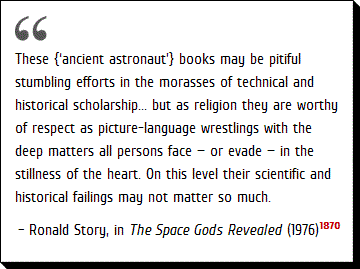 |
It has recently become fashionable to postulate that ETs landed on our planet ages ago, whether to influence our biological or social evolution, to collect zoo specimens, or to make anthropological surveys.1215,1221,1326,1327,1328 Extravagant speculations abound: One book attributes to alien benevolence the discoveries of subatomic physics, general relativity, and the double helix!1880
Xenoarchaeology — the search for evidence of ancient visitation by interstellar travelers — is at best a difficult and confused field of study. Precisely because hopes and expectations are so high, it is often harder to maintain a strong, healthy skepticism. Hence, in the words of astronomer Carl Sagan, "we must accept arguments for extraterrestrial visitations to earth only when the evidence is compelling."1870
At present, an exhaustive survey of all pertinent literature and other evidence fails to uncover a single incontrovertible case of past alien presence on our planet.
|
The Hypothesis of Mediocrity allows that,
as a general rule, when one goes exploring one finds inferior things. |
| Hypothesis of Mediocrity |
Of course there is nothing a priori absurd about the basic idea of ancient astronauts. The Hypothesis of Mediocrity allows that, as a general rule, when one goes exploring one finds inferior things.1040 For example, Columbus discovered America because European transportation technology was well advanced beyond that of the native Americans. Were this not the case, the natives would have discovered Europe! It is plausible to conclude that if the Galaxy is teeming with life, a superior intelligence from another star system could have visited Earth for any of a myriad of good reasons.
Speculation has centered on three specific areas. First, there is the possibility that aliens arrived geological timescales (millions or billions of years) ago. Biochemical and genetic evidence has been marshaled in an attempt to demonstrate that our natural biological evolution may have been adjusted, enhanced or tampered with in some manner.
| Xenoarchaeological research areas |
A second proposition is that extraterrestrial "gods" and "saviors" have materially affected the development of human society and culture. The most common evidence advanced in favor of this is the virtual ubiquity of legends describing visitors from the sky. Usually these yarns seem to suggest either that the human race was exported to Earth from other worlds, or that ETs came among men and helped launch human civilization.
Naturally, a mere account of strange beings who live in the heavens and perform miracles is not compelling proof. (Where else might gods reside but in the skies?554) And the clear correlation between the movement of stars and constellations in the celestial vault and the changing seasons has probably been recognized at least since the emergence of Cro-Magnon man. Primitive belief systems often attribute divinity and magical forces to such regular features in the environment.
Yet how easy it would be for an alien humanoid to "curse" hapless natives with a portable x-ray machine! It may be that all interstellar First Contact operations include a Thaumaturgy Division, whose duty it is to create miracles and god-myths to keep the curious at a safe distance in the unlikely event of an emergency landing. These thaumaturgists could create spectacular displays to awe primitive onlookers, such as transmutation of drinking fluids, variable-rigidity lances, and advanced force-field technology (which might perhaps be demonstrated on local bodies of water).
The third specific area of xenoarchaeological research is the quest for alien artifacts and other physical manifestations of their presence. This is of great importance, because it is often urged that in such important matters "the only acceptable evidence would be hardware."373 For instance, the discovery of a piece of advanced electronics embedded in a coal seam millions of years old, accompanied by indisputably nonhuman skeletons, might be acceptable as convincing evidence of past visitation. Another common suggestion is that the aliens might have left a durable marker of some kind, such as the black monolith depicted in the science fiction movie 2001: A Space Odessey. In fact the Moon would be an ideal location: The artifact would last millions of years without disturbance and could only be detected by a reasonably advanced spacefaring civilization.
But we must beware of technological chauvinism in assessing possible artifacts. We can interpret certain objects as airfields, nails, or evidence of the use of nuclear explosives, but this is because we have just acquired this technology ourselves. Two hundred years ago the interpretation would have been much different; two centuries hence, it will again radically change. The fact is that the technology of space visitors will most likely be highly non-contemporary with our own.
| Problems discerning ancient ET contact |
The problems involved in tracking down evidence of extraterrestrial contacts in ancient times are vastly different from those of conventional archaeology and anthropology. It would not be remarkable if a few brief visits by ETs to limited areas of this planet have left no traces. Continental drift and tectonic shuffling, ice ages, volcanic activity and sedimentation will have taken their toll.
Archaeologists generally search for human settlements. Yet the chances of, say, a spacecraft crash landing near one of these is extremely small. It is highly unlikely that we could ever detect anything less than widespread, intensive alien involvement.
Let us assume arguendo that ten aerial vehicles crashed somewhere on Earth in ancient times, spewing their debris over a swath covering 10,000 m2. If the affected stratum is one meter deep and lies under an average of 10 meters of sediment, this leaves about 1015 cubic meters of soil and rock to be examined.
If we then assume that all crashes occurred only over that 10% of the Earth’s land area which is "interesting" to the ETs, and that there are ten archaeologists with suitable engineering and technical credentials searching full time for the sites (excavating an average of 10 m3 each day per investigator), it would take roughly 15,000 years just to have a 50/50 chance of finding a crash site. Even then, and assuming favorable corrosion conditions, the chances of spotting recognizable remnants of an accident would still be miniscule.
For these reasons and others, many have renewed the hunt for reconstructable contact legends passed down from early human civilizations. There is some reason to cautiously assert the validity of this technique, because we know that historical events have occasionally been faithfully recorded in myth and folklore.
Perhaps the best-known of these was the first meeting between the Tlingit people on the northeast coast of North America and a European expedition in 1786 led by the French explorer Jean La Pérouse. The oral native account of the incident remained true to the original a century later, although some of the descriptions of advanced European technology (e.g., giant sailing ships) had acquired a distinct mythological flavor over the years.554 And many other accounts of such phenomena as supernovae1557 and great floods862 have likewise survived through centuries of verbal narration.
One useful test of the validity of legendary encounters with ETs might be whether or not information is contained in the tale which couldn’t possibly have been generated by the primitive civilization itself.15 For example, an ancient manuscript containing modern circuit diagrams or a "holy number" worshipped throughout the ages (which turned out to be the transcendental e or the nuclear fine structure constant) might be sufficient if it could be independently authenticated.
Carl Sagan has articulated three factors which maximize the probability that an historical encounter with aliens would be recorded in a reconstructable manner:
|
1. The account must be committed to writing soon after the event; 2. The contacted society undergoes a major change because of the contact; 3. The aliens make no attempt to disguise their exogenous nature.554 |
If these stringent requirements can be satisfied in even a single instance, xenoarchaeologists may be able to secure proof that Earth has been visited by intelligent ETs.
 |
| Interplanetary adultery |
The evidence that man’s biogenetic evolution has been interfered with by aliens is scanty and highly questionable. Perhaps one of the earliest mythological accounts of possible biological experimentation on apes is mentioned in the Ramayama, the second of the great Indian epic poems. Hanuman the monkey god was supposedly conceived when Shivar (a dweller in the heavens) gave Anjana (an Earth ape) a sacred cake to eat. The monkey god thus born was super-strong and highly intelligent.310 But despite the fact that Hanuman was followed by legions of other ape-heroes (Sugriva, Brahaspati, Bali, Tara and Gandha, among others), there was never any suggestion that these were the biological precursors of men.
Greek mythology is full of tales of "interplanetary adultery." Zeus, king of the gods, had scores of human concubines and was reportedly responsible for many rapes of human females. Apollo, Aphrodite, Hermes and Ares all had affairs with mere mortals. Yet most biologists today agree that a successful sexual mating between two species from different planets is improbable at best. Although lions and tigers have been crossbred in captivity (to make "ligers"), such is not the rule. Even Cro-Magnon and Neanderthal man, two species of humans, are not believed to have been interfertile.
Benevolent ETs would probably have come to Earth, not to hybridize or perpetuate their own genome, but to improve ours. This could easily be done using advanced genetic engineering to accelerate the normal evolutionary processes. The native myths of the Marquesas Islands, Hawaii, Indonesia and Tahiti all tell that the first men on Earth were given birth to by a celestial couple.310 If one wanted to do this sort of thing and a humanoid was the desired end-product, it might make sense to modify some of the local primate stock. Marmosets and many other monkeys have the same number of chromosomes as man; gorillas, chimps and orangutans have only two extra.
Erich von Daniken has suggested something along these lines, although his factual support is notoriously weak. He claims in his several books that man is an artificial mutation, separated from the ape stock long ago by alien intervention.1221 In Chariots of the Gods we find:
Dim ages ago an unknown spaceship discovered our planet. The crew of the ship soon found out that the earth had all the prerequisites for intelligent life to develop. The spacemen artificially fertilized some human female members of {an advanced primate species}
They repeated their breeding experiment several times until they produced a creature intelligent enough to have the rules of society imparted to it. The space travelers destroyed the unsuccessful specimens, {fearing that men} might retrogress and mate with animals again.1326
|
"Directed Panspermia,"
… space probes bearing … assorted microorganisms capable of infecting a sterile host planet. |
Unfortunately, no solid verifiable facts are adduced in favor of the hypothesis.
This area of xenoarchaeology has been severely handicapped by a dearth of qualified researchers and an excessive quantity of unusually poor scholarship.1948 A case in point is Mankind — Child of the Stars by Max H. Flindt and Otto O. Binder.1215 Their proposal, simply stated, is that we are the hybridized descendants of intelligent extraterrestrials. Apparently following Larry Niven's excellent science fiction novel Protector first published seven years earlier,1909 Flindt and Binder assert that the human race is merely a colony founded and maintained — and later abandoned — by beings from another world. Decades of detailed paleontological and evolutionary data are casually swept aside: We are asked to believe that man could not have evolved fast enough on Earth. Hence the "starmen" must be responsible.
Supposedly, humans are sexier than other animals because the ETs were downright lecherous. Not only did the starmen bring their own genes to Earth for our benefit, but "the primate line was imported"1215 as well. As if this were not enough, the authors of Mankind attribute the evolution of hundreds of species of food animals and other extinct creatures to the aliens’ kindly influence. Again, factual support is totally nonexistent.
But serious xenoarchaeological theories are being pursued by competent scientists in spite of the deluge of popularized pseudoscience on the subject. Ronald Bracewell, a respected Stanford University radioastronomer, has proposed that it would be a fine gesture for a passing extraterrestrial to have seeded our then-sterile planet, billions of years ago, with the first microorganisms that would later lead to the evolution of intelligent life.80
A less glamorous version of this conception of the origin of life is widely known as the Gold Garbage Theory. According to Dr. Thomas Gold of the Center for Radiophysics and Space Research at Cornell University, life here might have spread from a pile of waste products accidentally dumped on a barren Earth long ago.2,1910 A. G. Cairns-Smith, a well-known biochemist at the University of Glasgow in Great Britain, suggests that our original ancestors might have had alien biochemistries and has presented some (as yet nonconclusive) evidence to support this possibility.1460
| Crick and Orgel's directed panspermia |
But the best-known of the "earth-seeding" ideas has come from two of the world’s most eminent molecular biologists: Francis Crick at Cambridge, England and Leslie Orgel at the Salk Institute in San Diego, California. According to their theory, first presented in 1971 at the joint Soviet-American Byurakan CETI conference, organisms may have been directly transmitted to the Earth by intelligent space beings — deliberately.1283 This "directed panspermia," as they call it, could be accomplished simply by sending out unmanned space probes bearing a ton or so of assorted microorganisms capable of infecting a sterile host planet.
Crick and Orgel cite as evidence the inordinately large role of the element molybdenum in terrestrial biochemistry, peculiar because it is such a rare substance. Chromium and nickel, which are 10 and 100 times more abundant in the environment, respectively, are relatively unimportant in biochemistry. The theory has been debated extensively in the literature without conclusion.1294,1295,1296,1911,2100
Early primates may have been set on the path of sociocultural development because of alien intervention, as portrayed in the popular production 2001: A Space Odyssey.1912 But there is no need to resort to fiction. Human folklore is replete with tales of interactions with strange beings from the skies.
Among the lesser-known myths is that of the Eskimos. Eskimo legends tell of being transported to the frozen northern lands in "giant metal birds". According to Pauwels and Bergier, attention has been drawn to curious cultural parallels between various archaeological sites located in Greenland, Siberia and Ceylon.1913 But apparently the claim cannot be authenticated.1001
| The Gilgamesh Epic |
One case which most nearly meets Sagan’s three stringent criteria (see above) is the ancient Sumerian civilization.20,554 The Sumerians were profoundly affected by the Apkallu (possible representatives of an advanced, nonhuman, amphibious extraterrestrial society), who taught them laws, science and architecture. No attempt was made by the aliens to conceal their nature. However, the first requirement — that there be a contemporary written account — is partially lacking. The only description that has survived appears in the Babylonian Gilgamesh Epic (ca. 2000 B.C.), one of the oldest existing written texts in the world today. But second-hand reports are just not good enough.
The Sumer legend is interesting because the creatures are always spoken of as "beings," "endowed with reason," and "personages" — but never as "gods"! Were it not for the unusual subject matter the account would doubtless be considered an ordinary historical event, as there are no mystical or super natural overtones in the writing.
Most other legends don’t appear to represent a radical alteration of any culture. The 3,500-year-old Egyptian bible called the Book of the Dead speaks of "those who with their knowledge reach the vault of the sky" and mentions "those who live among the stars".1914 Although the work purports to describe the life of Thoth, a god from the sky alleged to have given the people of the Nile the beginnings of science, literature and medicine, the Book of the Dead is laced with mythological serpents, devils and demons.
In India, the Mahabharata is one of two beloved epic poems. The twenty-volume work, written several thousand years ago, is a history of Indian religion and mythology. The poem speaks of "vimans" that fly through the air bearing gods. In another section, two legendary characters battle each other with incredible weaponry that causes the winds to blow … meteors lashing down from the firmament … a thick gloom … the sun no longer gave any heat … clouds roared … The elephants and other creatures of the land, scorched by the energy of that weapon, ran in fright. The very waters heated, the creatures residing in that element … seemed to burn. The forms of the slain could not be distinguished.746
The Dogon of Mali in Africa worship a pyramid with a square, flat top, upon which it is said the "sky gods" landed during their visits in ancient times. Such beings supposedly taught the natives the essentials of surveying and agricultural techniques, but are always referred to as gods.310 The tale, however, appears to be purely allegorical.*
| Legend of Quetzalcoatl |
About the time the Toltec and Mayan cultures were beginning to intermingle (ca. 900 A.D.) there arose the legend of Quetzalcoatl, a bearded, light-skinned man who flew down from the sky to teach men law, astronomy, math, art, and the cultivation of corn and cotton. The feathered serpent was his symbol, and the pyramid built in his honor is the largest in the world (it has a volume nearly 30% greater than the largest Egyptian structure). When Quetzalcoatl’s mission to Earth was completed he returned to the morning star, promising to return someday.
The Mayans themselves are also fascinating because of the extreme accuracy of their calendar system. Furthermore, the units of time in the Mayan system included the alautun, a period of roughly 63,000,000 years! One inscription describes events that occurred 90 million years ago, and another makes mention of a date 400 million years in the past.1848 But without more, unfortunately, a long time-sense alone cannot be considered compelling proof.
For those who wish to find evidence for extraterrestrials, the Christian Bible is chock-full of marvelous possibilities. The prophet Elijah, for instance, was protected by a fire that came down from heaven and destroyed 100 soldiers and their captains (IV Kings 1:9-12). Soon thereafter he was abducted by a "fiery chariot," and "Elijah went up by a whirlwind into heaven." (IV Kings 2:11). Similarly, Enoch is reported shanghaied by God (Genesis 5:24), although his tour of the "seven heavens" and subsequent return to Earth is published elsewhere (in The Book of the Secrets of Enoch).
Jacob wrestles with an angel until dawn and finally overpowers it (Genesis 32:22-33). After forcing the angel to bless him, Jacob releases it, exclaiming in relief: "I have seen a heavenly being face to face, yet my life has been spared."** Daniel encountered a being on a "throne like flames of fire." (Daniel 7:9). In Revelations 4:1-6, Saint John observed "a door standing open in heaven" and then a throne "from which proceeded flashes of lightning, rumblings, and peals of thunder … and before the throne was a sea of glass like unto crystal." Seated on the throne is a humanoid, surrounded by twenty-four others (the "elders"). The list of biblical tales is virtually endless:
The God to whom Moses frequently speaks appears to lack that strength of resolve we might expect from an omniscient deity. For example, when God is about to destroy Moses’ people the prophet manages to talk the Lord out of it! (Exodus 32:7-14) Furthermore, Moses communicates with the being upon demand in a specially constructed Meeting Tent: "As Moses entered the Tent, the column of cloud would come down and stand at its entrance while the Lord spoke with Moses." (Exodus 33:9) And God seems strangely concerned with promulgating an ethical rule that prohibits maltreatment of foreign-looking humanoids: "When an alien resides with you in your land, do not molest him." (Leviticus 19:33)
Dr. Vyacheslav Zaitzev746 and Alexander Kazentsev981 have theorized that both Jesus Christ and the biblical angels might have been ETs. (It is interesting to note that the births of both John the Baptist and Jesus were announced to the respective mothers by angels long before they themselves knew they were pregnant, and that both mothers were barren or virgin at the time.)
| The Genesis Plurals |
Then we have the problem of the Genesis Plurals. There are many of them, but two are of special concern here. The first is as follows: "And God said, Let us make man in our image, after our likeness." (Genesis 1:26) The fact that the plurals "us" and "our" are used gives rise to the speculation that many gods are involved, that is, extraterrestrials. But it is generally accepted that these particular plurals are a veiled reference to the existence of more than one person in God (i.e., the Trinity).
The second Genesis Plural is rather harder to interpret: "And it came to pass … that the sons of God saw the daughters of men … and they took them wives of all which they chose. … When the sons of God came in unto the daughters of men they bore children to them." (Genesis 6:1-4) Who are these "sons of God"? More extraterrestrials?1845 One common explanation is that they are the descendants of Seth and Enos. Ronald Story has suggested that they were "divine beings who belonged to the heavenly court."1870 The issue remains unresolved.
One of the most controversial "contact events" in the Bible may be found in the Book of Ezekiel. To pick one passage of many:
Now it came to pass in the thirtieth year, in the fourth month, on the fifth day of the month, when I was in the midst of the captives by the river Chobar, the heavens were opened, and I saw visions of God. And I saw, and beheld a whirlwind come out of the north, and a great cloud, and a fire enfolding it, and brightness was about it, and out of the midst thereof … was the likeness of four living creatures; and this was their appearance; there was the likeness of a man in them. Every one had four faces, and every one four wings. Their feet were straight feet, and the sole of their foot … sparkled like the appearance of glowing brass. And they had the hands of a man under their wings on their four sides; and they had faces, and wings on the four sides, and the wings of one were joined to the wings of another.
After this "landing," Ezekiel continues:
This was the vision running to and fro in the midst of the living creatures, a bright fire and lightning going forth from the fire. And the living creatures ran and returned like flashes of lightning. Now as I beheld … there appeared upon the earth by the living creatures one wheel with four faces … a wheel within a wheel. When they went they went by their four parts, and they turned not when they went … And over the heads of the living creatures was the likeness of the firmament, as the appearance of crystal, terrible to behold, and stretched out over their heads above … And I heard the noise of their wings, like the noise of many waters … and when they stood, their wings were let down. For when a voice came from above the firmament that was over their heads, they stood and let down their wings. And above the firmament was the likeness of a throne, as the appearance of the sapphire stone, and upon the throne was the appearance of a man above upon it. (Ezekiel 1:1-26)
| Spaceships of Ezekiel |
According to the late Josef Blumrich, former chief of the systems layout branch at the Marshall Spaceflight Center of NASA, Ezekiel was confronted with an "Earth Excursion Module" (Figure 3.1) manned by an alien pilot.1058 In Spaceships of Ezekiel, Blumrich presents detailed engineering analyses of a plug-nozzle planetary landing vehicle that has been seriously considered by aeronautical designers at NASA1977 and elsewhere.1001 Its "wings" are helicopter blades affixed to four columns supporting the rocket mechanism (Figure 3.2). The aerospace engineer concludes that his design would be optimal for the required missions, which are: (1) Earth-to-orbit, and (2) short surface-to-surface hops.
As the great archaeologist Heinrich Schliemann discovered the ancient city of Troy by accepting the Homeric epics literally, Blumrich has attempted to take Ezekiel at his word and reinterpret what the Hebrew prophet saw in terms of reasonable modern technology. Certainly it is doubtful that Ezekiel — a man of the 5th century B.C. — could have recognized the form or function of a bonafide spacecraft if he had seen one.
Unfortunately, most biblical reconstructions such as the above fall short of the three stringent requirements demanded by Sagan. Although the events described in the Bible clearly had an enormous effect on many cultures, the translated and retranslated record of whatever did happen 2000 years ago is now a hopelessly confused jumble of conflicting testimony. (The two accounts of Creation in Genesis, for instance, explicitly contradict each other!)
Besides the incorrectness of the astronomy and celestial mechanics in most biblical (and other) tales, the evidence here also fails because any hypothetical extraterrestrials apparently took great pains to generate a god-myth and conceal their exogenous nature. Unlike the Sumerian legends discussed earlier, the Bible is loaded with spiritual, mystical overtones which render virtually impossible the conclusive extraction of any historical visitation events that may be hidden there.
* It is interesting that the oral tradition mentions a "dark brother" of the star, Sirius.310,2022 In modern times it has been discovered that the Dog Star does possess a dark companion star, a fact unknown until a little over a century ago. Nevertheless, this can hardly be viewed as compelling evidence of extraterrestrial visitation because it is a trivial point which could easily have been adopted at random by the Dogon.
** It is notable that until about the 6th century A.D., the Church did not accept the spiritual nature of angels but considered them to be physical beings without wings.
From time to time peculiar artifacts have turned up, often touted as remains of alien technology here on Earth. At best most of the finds are unauthenticated, unverifiable, and frequently irrelevant.
| The Salzburg Cube |
Perhaps the oldest known artifact is the so-called Salzburg Cube. This object was found in 1885 in a Tertiary Period coal seam by a Dr. Gurlt. It measured 67 × 67 × 47 millimeters (with a deep groove running around its middle), weighed about 785 grams, and was said to resemble in composition a hard nickel-carbon steel.600 However, mere steel should not have been able to survive 12-70 million years of the successive acid/alkaline reactions found in the decaying vegetation in a coal bed.1001 The Cube reposed in the Salzburg Museum in Austria until 1910, when it apparently was lost.45
Bullet holes in prehistoric bison,310 remains of screws,1327 nails,49 and sparkplugs (the "Coso Artifact")83 have been unearthed, as well as handprints310 and footprints1327 molded in solidified sandstone, instruments,1326 small gem statuettes,1269 and peculiar coins.49,1001 A diffraction grating etched on a polished copper mirror was found in an early Egyptian (3rd or 4th Dynasty) tomb.49 And about 700 strange granite disks were rumored recovered from caves in the mountains of Payenk Ara Ulaa in China, in 1938. These disks bore engraved symbols telling of creatures landing a craft and meeting the local natives.746 However, the lack of corroborating artifacts is suspicious.
The Baghdad Batteries are small ovoid jars capable of producing a weak current when filled with vinegar. About a dozen such objects turned up during heavy construction work near the capital of Iraq. Ronald Story has suggested that they might have been used for primitive electroplating of silver onto copper, certainly a far cry from advanced extraterrestrial technology.1870
| The Ark of the Covenant |
Another technological "gift from the gods" appears in the Bible. In Exodus 25:10-22 God tells Moses how to erect the Ark of the Covenant, which serves as a transceiver to heaven. The construction details of the Ark are such that when completed, Moses should have had a giant capacitor charged to a hundred volts or so.1915,778,1326 While it is true that an arch of acacia wood with gold leaf trimmings can hardly be considered advanced technology,1870 the ability of ovens, cars and other metallic objects to audibly receive modulated radio broadcasts (on rare occasions) is a documented fact. If laboratory tests with models of the Ark can demonstrate this ability, a good case could be made in favor of alien influence: The ETs would simply have been ordering the manufacture of the simplest radio device manageable with the limited tools available to humans millennia ago.
Another Biblical tale often attributed to extraterrestrial activities is the "nuclear explosion" that destroyed Sodom and Gomorrah around 2000 B.C.1915,1326 As related in Genesis 19:24-28, "the Lord poured down on Sodom and Gomorrah sulphur and fire from out of heaven." Later that morning there was "smoke rising from the earth as though from a furnace."
But there are excellent grounds for believing that the cataclysm was the result of a great earthquake1918 followed by explosions of natural gas.1870
Excavations at the site in 1928 revealed large burned out regions of oil, sulphur and asphalt overlying a subterranean salt dome 50 meters thick. There is clear geological evidence that "a great rupture in the strata took place centuries ago. "1870
| Countless other artifacts |
There are countless other artifacts which could and have been attributed to space visitors, including the following:
- The construction of the pyramids and mummification technology,1326,1915
- The Baalbek terraces as launching platforms,746,1326
- The rustproof iron pillar in India,1326
- The Nazca desert "spaceport" in Peru,1326,1915
- The subterranean tunnels and golden tablets of Juan Moricz in Ecuador,1916
- The giant cement cylinders of New Caledonia,83
- The peculiar statues on Easter Island,1326
- The "catastrophic results of a landing attempt" in Tungus, Siberia in 1908,600,2202
Unfortunately, more prosaic explanations exist in all cases.80,1758,1870,1917,2008
 |
Flying saucers and their progeny are largely a product of the Space Age. Since we now possess rudimentary spaceflight capability, people ask, could not aliens as well? This kind of reasoning has given added plausibility to the reports that Earth is now being regularly visited by ETs possessing high performance aerial vehicles with remarkable maneuverability (Mach-10 speeds with no sonic booms, right angle turns, vertical takeoff and landing, etc.)
| UFOs in antiquity |
This is not to suggest that the problem of UFOs ("Unidentified Flying Objects") is a new one. Humanity has been seeing strange lights in the sky for thousands of years. In 213 B.C. in Hadria, an "altar" was seen in the sky followed by the appearance of a humanoid in flowing white robes.1673 There were at least a dozen similar sightings during the next two hundred years. In 100 B.C., Pliny observed "a burning shield scattering sparks {as it} ran across the sky at sunset from east to west."720
The phenomena persisted into later times. In Nuremburg in 1561, for example, there reportedly was a mass sighting of flying balls and discs in the neighborhood of the rising sun.1920 The great astronomer Edmund Halley in 1716 apparently saw an object that illuminated the night sky so brightly that it could serve as a reading light for several hours.1673
It is easy to find thousands of "flying saucer" sightings, especially if we are willing to suspend our scholarly scepticism and uncritically accept all such accounts as being factual descriptions of aliens buzzing our planet. Most scientists would agree that there are many peculiar things to be seen in the heavens; it is the modern interpretation, by and large, with which they take issue.
| UFO sightings by scientists |
A recent poll of the members of the American Institute of Aeronautical and Astronautical Engineers turned up sightings from only 2% of the sample of 1,175 scientists.1919 But popular polls yield different results. In 1966 pollster Gallup found that more than five million Americans claimed to have seen what they believed was a genuine UFO.17 By November, 1973 the number had climbed to fifteen million (fully 11% of the adult population), and for the first time a majority of the American public believed that UFOs were real.1347
The literature in this field1790,1791 is extremely variable in quality, and opinions tend to be highly polarized with little rational debate.
- Typical books written by "uncritical believers" include those by Leslie and Adamski,1787 Edwards,1639 Lorenzen,1672 Sanderson,632 Keyhoe1623 and Holzer.1858
- (In 1974 one "ufologist," Ralph Blum, confidently predicted that "by 1975 the government will release definite proof that extraterrestrials are watching us."1347)
- Slightly less credulous, perhaps, are Vallee,787,1189,1673 Cohen,331 Hynek,341,597 Saunders and Harkins,1789 McCampbell,1778 and Emmeneker,1640 who present facts somewhat more cautiously while maintaining their devout belief in the mysterious.
- Finally we have the debunking books written by the "hardened skeptics," such as Menzel,1788 McCrosky and Broeschenstein,1792 Condon,17 Klass,695 and Story.1870
| UFOs — the "new mythology" |
Why is support for the Extraterrestrial Hypothesis (that UFOs are craft piloted by aliens) so widespread today? Part of the explanation must be the renewed interest in the subject of life on other planets. Ufologist B. L. Trench listed nearly 20 worldwide UFO investigative organizations;596 his favorite — Contact — had branch offices in 27 countries in 1971. And the television-viewing public eats it up. When the series "The Invaders"* was brought out about a decade ago, the American Broadcasting Company sold the show to fifteen foreign networks as well.695
But there is much more to the phenomenon than the current fascination with xenological topics. Man has always had religion, it is said, both to preserve moral values and to impart a measure of predictability and uniformity to the environment. In a world where morality seems as fluid as the winds and where total annihilation may be only 15 minutes away, traditional religions have been unable to supply the answers to many hard questions. It is this uneasiness about the future that has given rise to what Ronald Story appropriately labels the "new mythology".1870
The ancient-astronautists spawned by Erich von Daniken’s writings, and the contactee cults such as the Aetherius Society,1870 The Two,1921 and Gabriel Green’s Amalgamated Flying Saucer Clubs of America333 are extreme examples of a belief pattern suffusing our entire culture. Many people have begun to view extraterrestrial visitors not merely as friendly, but as technological angels who will guide us successfully through the uncertain years ahead.1347
Just as the biblical angels were the mythical beings proper to the age of early Christianity, UFOs and their benevolent alien occupants are the mythical beings proper to the Space Age.615 The famous psychiatrist Dr. Carl Gustav Jung did not find it at all surprising that scientific instead of religious imagery would be used by many to assimilate the accelerated pace of modern civilization.1920 Flying saucers serve as a partial substitute for God.346
| Status Inconsistency Theory |
A related idea is the Status Inconsistency Theory of UFO sightings proposed by Donald I. Warren, a University of Michigan sociologist.336 In this theory the belief in flying saucers is linked to the degree to which a person feels alienated from society. Persons who perceive their social status (as measured by, say, income) as different from their abilities or true worth (e.g., education, ethnicity) have been found to be more likely to report UFOs than those who do not have this internal conflict. Such inconsistency forces the individual to withdraw from society to a certain extent, and the resulting void is often filled by a belief in extraterrestrial benefactors. Another modern dilemma is the virtually universal distrust of governments and politicians, and a nostalgic yearning for the great leaders of the past. There is much evidence that the known propensity of the authorities to classify and conceal has done little to reassure the public that no pertinent information on flying saucers is being withheld from them.18,694,1347 For example, a poll taken in 1971 by the engineering periodical Industrial Research showed that 76% of the respondents believed the government was hiding some of the UFO facts. Since paranoia is self-reinforcing, the conviction that aliens are commuting to Earth has not been dampened by official proclamations to the contrary.
Finally there is the problem of boredom in daily life. With more leisure time on our hands than ever before, we seek amusement and fun. Certainly the discovery of beings from another world would be both an amusing and exciting distraction from routine. As Story points out tongue-in-cheek: "Who knows? They might even let us ride in one of their spaceships!"1870
Carl Sagan believes that flying saucers are a kind of psychological projective test — a "cosmic Rorschach" — by which humans project their hopes, frailties and self-perceptions onto alien beings.15 As he says, "the idea of extraterrestrial visitation resonates with the spirit of the times in which we live."18
* The theme was that aliens are infiltrating our government as a prelude to conquest of Earth.
While it is certainly true that hidden xenoarchaeological treasures may lie veiled forever in ancient legend and folklore, the observational data for flying saucers are frequently completely worthless. As British writer Maxwell Cade notes, "there is clear evidence of much fraud, more hysteria, and still more wishful thinking."45 Such bitter experience has taught us that when we have an emotional vested interest in a particular result and expectations run feverishly high, we must demand only the most scrupulous honesty from ourselves and refuse to accept any but the most rigorous, compelling evidence.20,562
Most researchers would be delighted to find extraterrestrial life be cause it would be such a momentous discovery. Perhaps the strictest rule of evidence in xenology is that all conclusions must be compelled by the facts. There must remain no rational alternative explanations.
| Authenticity of UFO Reports |
L. Sprague de Camp has set forth the following criteria by which to judge the authenticity of UFO reports:
- 1. The report must be first-hand;
- 2. The teller must show no obvious bias or prejudice;
- 3. The teller must be a trained observer;
- 4. The data must be adequate and available for checking;
- 5. The teller must be clearly identified.1922
A case which satisfies these requirements, and which can perhaps be checked independently with a large number of witnesses, would be considered reliable by the majority of the scientific community.
But in addition to being reliable, UFO reports must also be exotic. An exotic case is one which is inexplicable in terms of common phenomena; for example, a strange moving light in the sky could be an aerial refueling operation, a satellite passing overhead, a police helicopter with a searchlight, etc.15
Sagan maintains that to date there are no reliable cases which are exotic, and no exotic ones which are reliable.18
Can flying saucers exist? Sagan himself has presented an interesting paradox which apparently rules out the possibility of ufonaut exploration of Earth. If there are many advanced civilizations in our galaxy then there is probably nothing terribly unusual about what is going on here. Hence, there is no urgent reason for aliens to go to the enormous expense of visiting us. On the other hand, if there are few technical cultures around, there won't be enough of them advanced enough to send visitors!15
| UFO's size and shape is nonstandardized |
Skeptics often cite the fact that observed UFOs are totally nonstandardized in size and shape — repeat visits by the same craft are rare. In general we would expect such standardization from experienced aliens, since the retention of a single configuration over a long period of time is possible only when its design has matured. Given a specific mission and a specific level of technology, an optimal definitive form can usually be found. So how can we explain the fact that UFOs appear to be shaped not only as cigars and disks, but also cubes, spheres, doughnuts, insect shapes, etc.?
Other arguments purporting to dispute the legitimacy of UFOs have been submitted by Friedman,694 Sagan,20,1317 Abell,1908 and Chiu.1311 The logic proceeds as follows: Using the acceptable estimates that there are a million communicative extraterrestrial civilizations (in our galaxy of 200 billion stars) each having a lifetime of ten million years, then if each culture dispatches one exploratory starship per year, Earth — by random chance — should be visited only about once every 100,000 years. Of course, if the ETs discovered something interesting happening on our planet they’d come more often to keep closer tabs on us. What is not clear is whether humans are of such inordinate interest as to justify the large investment of alien time and resources that ufologists claim is being made.
| Planning a first contact |
When dealing with ufology the careful reader will always bear one additional question in mind: If we put ourselves in the aliens’ shoes, what is the most rational way to go about planning a successful first contact effort with a planet like Earth? Although this xenological problem is explored in greater depth later on, a few issues can profitably be raised now:
- Disturbance of the system — Since they are the ones with high technology, they will not fear us.1208 Thus the greatest danger to the enterprise is that of observer influence (a common problem in measurement science).77{?} If the mere act of observation will disrupt or destroy the system under observation, it behooves the observer to minimize that disruption. As Richard J. Rosa of Avco Everett Laboratories puts it: "A hundred years {may be} of little consequence to them. The fact that Columbus did not hesitate to talk to the Indians was not without consequences that were unfortunate for Europe and tragic for the Indians. Perhaps our interstellar visitors have learned to be more cautious — and considerate."344
- Minimizing the disruption — An advanced society can certainly make a planetary survey without the primitive indigenes knowing about it.377 As added security in maintaining anonymity, aliens and their artifacts could sport many clever disguises.49 Ufologist Jacques Vallee notes: "To make ultimate detection impossible, {the aliens} would have to project an image just beyond the belief structure of the target society."1189 In fact, it is rather difficult to explain why, if they wish to avoid contact, the UFOs allow themselves to be seen at all.747
- Standard first contact procedures — Spacefaring ETs will undoubtedly be experienced at the business of contacting other cultures. The following has been suggested by anthropologists familiar with the problem:
Exploration will proceed in a series of ordered steps. At each star the team will investigate the system and locate any planets. If they find a planet they will evaluate its habitability, physical resources and life forms. If any signs of intelligent life are discovered the survey team will have to decide whether to withdraw or attempt contact. This will involve careful observation from a distance to acquire information before actually making contact. At first, in order to gain language skills and social understanding, contact will be limited to individuals in small groups. In this way we can increase the chance of success at the official, formal meeting with ET leaders to arrange recognition and continued contact."615
Most rational observers would agree that the vast majority of sightings are the result of misidentification of familiar objects viewed under unusual conditions of lighting, weather, and so forth.18 There are also a multitude of outright hoaxes and exaggerations on record. For instance, in what Time magazine called the "gullibility experiment," three Cal Tech undergrads launched helium-filled polyethylene balloons from which were suspended metal rods with vanes and lighted railroad flares. Throughout the Los Angeles area reports came in of red, orange and green lights in the sky that moved at "fantastic speed."335 Similar deliberate hoaxes were arranged two years later near Castle Rock, Colorado.1312
Not all sightings of flying saucers can be summarily dismissed as hoax, weather balloon, or ball lightning.337,339,345 Dr. David Saunders at the University of Colorado has collected more than 70,000 unidentifieds and has placed them in a computer indexing and retrieval system.1789 There even seems to be enough data for meaningful statistics to begin to appear.
| Trends in UFO sightings |
According to Poher and Vallee, both computer specialists, several trends and conclusions have already emerged:
- The frequency of UFO reports increases with increased atmospheric visibility (which would not be the case if they were hoaxes);
- the number of sightings is a bell-shaped distribution as a function of the logarithm of sighting duration;
- the number of reports increases for objects farther away from the observer;
- the data show a peak a few hours before midnight, and a smaller secondary peak a few hours after midnight.787
|
Figure 3.3 UFO photographed by the author on March 30, 1976 |
 
UFO photographed by the author using Pentax Spotamatic
and Kodak ASA-125 Plus-X Panchromatic. The object appears to fly off to upper right in the frame. See text for details. |
What kind of information would be needed to really verify a UFO sighting?
- Eyewitness accounts are unreliable, heavily dependent upon the observer’s education, health, emotional state, and predisposition to falsehood.
- The kind of evidence that would be really compelling must be primarily physical.
- Photographs, for instance, are generally regarded as hard evidence by scientists.
- But pictures showing aliens, lights in the sky, or actual UFOs in flight are extremely easy to fake, as illustrated by the shots in Figure 3.3. (The author made a double exposure of a street light with a telephoto lens.)
| No photographic evidence |
After fifteen years of looking into the UFO phenomenon, NICAP (National Investigations Committee on Aerial Phenomena) director Stuart Nixon reported in November, 1972, the following conclusion regarding the literally thousands of photos he had received: "NICAP has never analyzed a structured object picture that is fully consistent with the claim that an extraordinary flying device was photographed. In every case, there has been some small detail, or group of details, that raised the suspicion of a hoax or mistake."695
As Philip Klass aptly notes, there are more than 80 million cameras in the United States alone shooting roughly 5 billion still photos every year.695 Deft cameramen have managed to capture on film such rare occurrences as meteor falls, tornadoes, and plane crashes. And yet there is not a single photograph of UFOs or their occupants which can stand the strictest scrutiny and compel our acceptance of its authenticity.*
What about astronomical photography? Each night hundreds of telescopes turn skyward to record events occurring in the heavens. Thornton Page, Chairman of the AAAS Special Committee on UFOs, states that "professional telescopes are not an efficient patrol net for extraterrestrial visitors" because they don’t see enough of the sky often enough.340 However, the Smithsonian Prairie Meteorite Network has sixteen wide-angle Schmidt telescopes covering an estimated 440,000 square miles of the Earth’s surface. Canadian and Czech meteor networks add a small additional area to the coverage.
According to Page’s calculations, assuming a 50/50 chance of a UFO being photographed by one of the networks and given that none have so far been detected, there can be no more than 690 luminous UFOs worldwide per year. If we just look at the United States, the upper limit becomes only 25 objects per year. (That is, if more than 25 UFOs were tracking across our skies each year, then the chances would be better than 50/50 that at least one of them would be spotted by a network telescope and recorded on film.) In conclusion, observational astronomy can neither convincingly rule out nor compellingly affirm the existence of UFOs.
How about radar sightings? Although it is true that many UFOs have been detected on radar screens in the last few decades, a radar return need not always correspond to a real physical object. For instance, it was discovered early in World War II that meteor trails could cause radar echoes.49 Birds and swarms of insects produced baffling returns until the true cause was ascertained.1773 Temperature inversions, so familiar to the inhabitants of the smog-filled Los Angeles basin, can cause radar beams to bend along a "duct," thus permitting the detection of objects much farther away than normal.1788 Radar signals can bounce off clear air turbulence or reflect back from patches of air whose temperature, humidity, or ionization differ from their surroundings.18
| NORAD and Early Warning System |
Naturally, the Early Warning BMEWS network would be ideal for picking up UFOs. In 1966 it was reported that more than 700 "uncorrelated targets" were being detected monthly.1189 Unfortunately for ufologists, the BMEWS, SAGE, and NORAD computers automatically discard any object that appears not to be following a ballistic trajectory or an Earth-orbital ellipse.18,597 And some really good cases of combined visual and radar tracking are probably being withheld for security reasons (e.g., "spoofing" tests, etc.). But Sagan and Page have pointed out that even a combination visual and radar sighting might not indicate a solid body — it could be an aurora, for instance, or mistaken identification.18 We see that it is only through the concatenation of many independent sources of confirmation that the authenticity of a UFO report can be compellingly demonstrated.
* The two best-known motion picture films of UFOs in flight, a total of 1425 frames shot in Utah and Montana in the early 1950s,1923 are highly questionable.695
| Fig. 3.4 UFO-Related Objects/Phenomena17,18 |
Meteorological – subsun, sundogs (parhelia), moondogs (paraselene), lenticular clouds, noctilucent clouds, mirages, "dust devils", St. Elmo’s fire, grindstone clouds, solar reflections on low-hanging clouds, lightning (ball, streak, chain, sheet), Brocken ghosts, green fireballs (around NaCl crystals or dust), swamp gas flickers (ignis fatuus, methane combustion,"will-o-the-wisp"), large flattened gliding hailstones, sun glint off shiny objects, rainbow-related phenomena, bolides, ducted ground light reflection, ice flakes, coronal effects, tornado lightning, volcano lightning, Earthquake-Associated Sky Luminescence (EASL), AgI used in cloud-seeding, pile d’assiettes clouds (stack of coins), ice halo, pilot’s halo
Astronomical – meteors, fireballs, satellite reentries, auroras, planets (Venus, Mars, Jupiter, Saturn), stars (Capella, Sirius), objects seen through haze/jet trails or magnified by temperature inversion, Moon, sunspots and solar flares, comets
Experimental and Technological – balloons sandwiched between dense air layers, test aircraft, unconventional aircraft, helicopters with bright lights, high-altitude projectiles, rocket launches, contrails, aircraft reflection or after burners, bomb tests, refueling operations, searchlight reflections, military flares, satellites, blimps, parachutes, radiosondes and pibals, landing lights
Physiological and Psychological – autokinesis (perceived motion of stationary objects), autostasis (perceived stopping of moving objects), "airship effect" (perceived connection of separate sources), "excitedness effect", hallucination and mass hysteria, afterimages, autosuggestion (seeing what one is looking for), entopic effects (retinal or vitreous humor defects within the eyeball), motes on the cornea (perceived as spots), astigmatism and myopia, failure to wear glasses, reflections from glasses, religious invention
Photographic – development defects, internal camera reflections lens flare, deliberate fakes (moon, street lamps, garbage can lids, phonograph records, hubcaps, lens cap suspended by thread, straw hat, Frisbee, models, window glass reflections)
Radar – temperature inversions and ducting effects, ionized gases in upper atmosphere, angels, bogies, phantoms, false returns (ice-laden clouds, birds, insects), "window" (long strips of chaff), ranging/calibration balls, hot-air bubble reflections
Biological – airborne debris (leaves, feathers, milkweed seeds), "angel hair" (gossamer spider parachutes), birds or flocks of birds, insect swarms, luminous fungi on birds, fireflies, glowing owl eyes, seagulls, moths, tumbleweeds
Industrial – detergent foam, soap bubbles, refuse from defective filter in chemical-industrial plant (milk, rayon), smoke plumes
Miscellaneous – kites, firefly trapped between window panes, radio astronomy dish, plastic bag with candles or flares, searchlight and headlight reflections off clouds, flashing ambulance light, tossed lighted cigarette, fireworks displays, reflection off building’s windows, airborne loose paper, beacon lights and lighthouses, water tanks, lightning rods, TV antennas, weathervanes, hoaxes
| More exotic physical evidence |
Despite prosaic explanations (Figure 3.4, Table 3.1), occasionally more exotic physical evidence will turn up. Coral Lorenzen described a detailed chemical and spectroscopic analysis of the alleged remains of a UFO which exploded off the coast of Brazil, near Ubatuba, in 1957.1672 The metal fragments were touted as magnesium metal purer than any manufacturer could have produced at the time of the catastrophe.
The case was investigated by the Air Force-sponsored Condon Committee study group in Colorado, authors of the 1000-plus page report on UFOs that came out in 1969.17 It turned out that magnesium of suitable purity had been produced, though only in relatively small batches, by one American company several years prior to the event at Ubatuba. In no case to date has any piece of an alleged alien spacecraft shown signs of other than terrestrial manufacture.1312

Other physical evidence (largely unconvincing) was also examined during the two year study at the University of Colorado, including stalled automobile engines, evidence of strong magnetic field fluences,* circular burn marks and "landing pad" depressions on the ground, broken tree limbs, and so forth — all to no avail.
| Close encounters |
A growing number of UFO reports in recent times involve observation of the alien occupants themselves. For example, the following articles appeared in the British Flying Saucer Review, perhaps the oldest and most respected ufology journal in the world:
- "Violent Humanoid Encountered in Bolivia" (1970 case — includes photograph of parked UFO and humanoid posing nearby);775
- "The Humanoid at Kinnula" (1971 case — close encounter with genuine "little green man");777
- "The Extraordinary Case of Rejuvenation" (1973 case — advanced medical knowledge imparted telepathically by humanoid aliens with "round ears and slit eyes," standing roughly 1.8 meters tall);780
- "Remarkable Encounter at Draguinan" (1974 case — a group of French UFO enthusiasts are accosted by three silvery humanoids more than two meters tall);785
- "UFO Landing and Repair by Crew" (1974 case — light-skinned, eight-foot-tall humanoids garbed in "wetsuits" are observed giving their flying saucer a tune-up in the forest, using wrenches and screwdrivers).782
| Contactees and abductees |
Perhaps the first alleged contactee in modern times was the medium Helen Smith. Her travels in space were published in 1900 along with a dictionary for translating Martian into French.1924 More recently, everything from sexual seduction of humans by aliens1623 to miraculous cures of myopia and rheumatism1347 has been attributed to direct contact with UFOs and their occupants. One of the more notorious contactees was the late George Adamski, who claimed to have shaken hands with visitors from Venus when they landed in the desert near his hamburger stand in the early 1950s.1193,1787 (Adamski has since been shown to be a fake by a member of the British UFO Society.289)
And then there are the persistent rumors that UFOs have crashed and their contents are being studied in secret by the government.814 One unconfirmed report states that the bodies of twelve tiny humanoids are being kept in cryogenic suspension in Hangar 17 at Wright Air Development Center near Dayton, Ohio. The alien corpses, and various parts of a flying saucer, are supposedly the remains of a UFO crash in the New Mexico desert in 1948.1672
Probably the most celebrated contactee case is that of Betty and Barney Hill, alleged to have been abducted aboard a spacecraft on September 19, 1961, and given a thorough medical examination by ETs.1795 (Betty was able to recall the incident via hypnotic investigation five years later, though Barney apparently could not.695) One of the few corroborative pieces of evidence is a star map which Betty had been shown by the alien pilot, and which she later reproduced from memory. Marjorie Fish, an Ohio schoolteacher, attempted to fit the map to the known positions of actual nearby suns in space. The fit she came up with contains fifteen Sol-like stars which all lie in a single geometric plane and center on what is presumably the extraterrestrials' home sun: Zeta Reticuli.351,1775
Carl Sagan and Steven Soter have disputed the authenticity of the Fish interpretation of the Hill map, but the case remains one of the most fascinating of its kind on record. Zeta Reticuli is a double star system, each sun believed to be suitable for the evolution of life as we know it and separated by a mere 0.05 light-years (only 1% of the distance to our nearest neighbor, Proxima Centauri). Unusually rapid technological advancement on the part of the sentient inhabitants of either of the Zeta Reticuli stellar systems might well result from the tantalizing closeness of the two stars. As the giant, luminous Moon beckoned to man throughout the centuries, perhaps the Zeta Reticulans too would find the challenge irresistible — only sooner.
* In case anyone is interested, I have in my files a circuit diagram for a most unusual piece of equipment — entitled "The Electronic UFO Detector".770
| Reward for proof |
The National Enquirer is offering a reward of $50,000 to the first person to submit incontrovertible proof that UFOs are of extraterrestrial origin.1347 Entries have been submitted, but the prize has yet to be awarded.
Fighting fire with fire, Philip Klass in UFOs Explained declared he was so certain that UFOs are not piloted by aliens that he would personally refund the full price of his book to any purchaser if positive proof to the contrary ever comes to light.695 As an additional expression of confidence, Klass has extended a $10,000 bet to any and all takers that UFOs are not extraterrestrial spacecraft. The jackpot pays off if any one of the following events occurs: (l) Any crashed spacecraft or piece thereof is found that clearly has extraterrestrial design or construction, in the opinion of the U.S. National Academy of Sciences; or (2) the U.S. National Academy of Sciences reaches the same conclusion based on other pertinent evidence; or (3) "The first bona fide ET visitor, who was born on a celestial body other than the Earth, appears live before the General Assembly of the United Nations or on a national television program."695
| Other explanations for UFOs |
What are UFOs? Besides alien spaceships, these possibilities have been proposed: Time travelers from our future789,1189,1845 natural or artificial biological mechanisms,632 Satanic devils,562 and remote-controlled robots and androids.1623 Vallee claims that UFOs may be a purely "psychic" event akin to mass telekinesis,659 while astronomer-ufologist J. Allen Hynek warns us that "we may have to face the fact that the scientific framework, by its very internal logic, excludes certain classes of phenomena of which UFOs may be one … It should not surprise us if a phenomenon that is inaccessible to a scientific procedure appears irrational."597 However, while few serious ufologists would categorically assert that flying saucers are manifestations of extraterrestrial life, many consider it to be the leading hypothesis.1448
| Project Starlight International |
As for future research, Hynek has quietly organized the Center for UFO Studies in Northfield, Illinois. A toll-free hotline phone number has been distributed to law enforcement and other government agencies to make UFO reporting fast and convenient.1671 An independent UFO-watch station crammed with more than $20,000 worth of sophisticated electronic gear has been set up on a 400-acre site 20 miles northwest of Austin, Texas. The equipment at Project Starlight International (as the observatory is called) includes a 30-meter-diameter circle of sequenced spotlights and a low-power helium-neon red light laser to attract the saucer’s attention — should one be spotted nearby.1925
Although it is probably the opinion of the majority of physical scientists that no compelling evidence now exists for extraterrestrial UFOs, it would be unreasonable not to continue to pursue ufology with an open mind. Judgement cannot be passed until all the evidence is in.
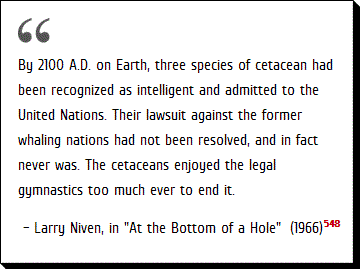 |
| Indigenous aliens |
The thrust of the chapter thus far has been the search for evidence of ETs on Earth in both ancient and contemporary mythology. But we must be careful not to overlook a possibly limitless source of alien intelligence indigenous to our own planet.
Until quite recently it was supposed that the basic mental capacities of thinking or reasoning — intelligence — served as a clear distinction between humans and other members of the animal world. Today we know we’re not so unique. It appears that virtually all living creatures possess at least the rudiments of intelligence; many elements of intellect appear in varying degrees across the phyla of the animal kingdom (especially the chordates and mollusks). Intelligence is therefore not a quality peculiar to humans or mammals alone but is developed and refined by all lifeforms.
| Defining intelligence |
The textbook definition of intelligence is: "The capacity to utilize experience in adapting to new situations." But what do we really mean by intelligent behavior? Even a virus could be said to be "learning" when its DNA changes to adapt to new environments.
There are two approaches. The first is functional, keying on the important functions of intellect such as the capacity for self-awareness.
The second approach is structural: What is the ultimate mental capacity of the neural network of a creature, viewed as a system? The structural approach allows facility of comparison between various animal species, and the results are rather interesting. The analysis focuses on a single organ possessed by virtually every animal — the brain.
| Brain size comparison |
While it is widely recognized that high intelligence is the product of an elaborate brain,439,443,1000 a few qualifications are in order. First, within the normal range of variations of a species among its members, difference in brain size is unrelated to the intelligence of the individual animal.444 As much as 800 grams has separated human brains of apparently equal intelligence. And since organ proportions change during growth, only mature average organisms can be validly compared. Brain size is a valuable criterion only when we compare differences between adult members of different species of animal (Table 3.2).
|
Brains of some social insects are relatively
larger than those of some vertebrates. |
Further, size alone is not a sufficient determinant of the depth of intellect although it does fix the perimeters of mental complexity. Other factors such as neuronal density, complexity and design of brain tissue convolutions, size and efficiency of neurons, average number of intersynaptic connections and so forth are also important. Gross bulk, while a rough correlate of intelligence, is not a precise measure of it.565,2560
| Use of language |
It is difficult to say exactly where the threshold of human intelligence lies. It is known that human infants become facile with language only after their brain mass exceeds 800-1000 grams.217 Yet this is not a reliable cutoff point because, for instance, chimpanzees (brain weight 440 grams) raised in human company have acquired vocabularies of as many as 200 different word-symbols. Dogs, with smaller brains still, utilize a larger repertoire of signals than do many primates (but this may be because primates are vegetarian browsers while dogs are pack hunters requiring reliable intragroup communications1542). Conversely, the walrus (brain weight 1130 grams) is not known to have any symbolic language at all.
| Brain size in relation to body mass |
Besides absolute brain size, the relative size of the organ with respect to the rest of the body is also important. This ratio is representative of the investment made by the organism in intelligence as a survival mechanism. (It is known, for example, that even the brains of some social insects are relatively larger than those of some vertebrates.965)
Of course, these are only rough indicia of intellective capacity, good only for comparing the order of magnitude of a creature’s mental acuity. But it is a safe bet that, in general, a 1000 gram brain will be smarter than a 100 gram brain, and a brain which represents 10% of the total body weight will be more complex than one which only embodies 1% of the total.20,965
Were we to find on this planet other conscious minds with whom we might converse, it would be an excellent opportunity to practice our communication skills — before attempting first contact with ETs with whom we share no common biological heritage. We might also discover some problems the extraterrestrials may confront in trying to deal with us, and learn to anticipate the solutions.
As can be seen in the last column of Table 3.2, the cetaceans (dolphins and whales) come closest to man in terms of both absolute and relative brain size.
- Much has been written about the intelligence of cetaceans in popular fact15,1698,1699,1929 and fiction.1931
- Their brains are highly convoluted and larger than human brains.
- They are extremely social animals (aggregations of up to 100,000 individual saddle-backed dolphins have been observed roaming the open seas565).
- Anecdotes of friendly and helpful attitudes towards men abound.
- There are reports of porpoises saving persons from drowning, guiding ships through narrow, fog bound straits.
- And even of performing psychological15 and psychophysiological217 tests on their human captors.
| Conditions necessary for the elaboration of a civilized society |
It is most difficult to measure dolphin intelligence and social abilities.1724
The famous undersea explorer Jacques Cousteau has pointed out four basic conditions necessary "for the elaboration of a civilized society."
These are:
- Brain
- Hand
- Language
- Longevity.1723
Porpoise and other cetaceans have brains nearly equal to our own, and possess lifespans of many decades. Whether or not they have a language remains to be proved. It is known that the humpback whale sings songs that often last more than 30 minutes and which are repeated with amazing accuracy.1931 Each season the songs are different.422 Dolphins, too, are capable of amazing mimicry of sounds and human speech. They could have a language of their own: One anecdote tells of a porpoise held in captivity and later released which emitted a long, involved sequence of sounds in the presence of a school of dolphins it had encountered.15
Unfortunately, cetaceans do not have hands; any intelligence they may have cannot be worked out in technology. Sagan has hinted that the dolphins’ creative energies might have been diverted to social instead of material technology. Asks he: "Are whales and dolphins like human Homers before the invention of writing, telling of great deeds done in years gone by in the depths and far reaches of the sea?"15 Apparently a single whale song contains roughly the same number of bits of information as The Odyssey does! Cetaceans may turn out to be "fluked philosophers … introverts who can think but not do."96
All this has motivated Arthur C. Clarke to proclaim: "There seems little doubt that dolphins think and speak much more rapidly than we do … And yet after decades of dedicated research into human/dolphin communication no major breakthroughs have occurred. Either the animal is not as intelligent as we had hoped, or communication with alien minds is a far more demanding task than anticipated.
Of course, the very fact that we have a vested emotional interest in finding porpoises to be intelligent should raise a flag of caution to the xenologist. The cardinal rule of evidence in xenology is that evidence must be compelling to be convincing. And most zoologists would agree that at present no such evidence exists in favor of cetacean super-intellect.565,1723
| Mimicking human behavoir |
Hence, while the dolphin possesses a huge brain and an exceptional ability to mimic, this does not necessarily imply consciousness or even high intelligence. Elephants, whose brains are more than three times larger than those of cetaceans, are known with reasonable certainty to possess an intelligence far below human level.565 Mynah birds and parrots are capable of imitating human speech rather well. The much-heralded altruistic cooperative behavior of marine mammals in rescuing injured comrades is also observed in wild dogs, African elephants and baboons,565 and may even be instinctual as a result of environmental necessities. Sociobiologist E. O. Wilson claims that delphinid communication systems are no larger nor more complex that that of other mammals or birds.565 The common consensus among zoologists appears to be that the intelligence of the bottle-nosed dolphin can be ranked somewhere between the dog and the rhesus monkey.1724,1932
This should not be taken as conclusive that cetaceans are not extraordinarily intelligent; the simple fact is that we just don’t know yet one way or the other. Certainly no evidence exists that would rule out this possibility. But because of the great potential inherent in such a discovery, we owe it to ourselves both to continue delphinology research with vigor and to demand compelling evidence before accepting specific conclusions.
| Zoo morphizing |
As John Lilly has pointed out, there are two dangerous pitfalls to be studiously avoided during first contact. First is the danger of anthropomorphizing — of assuming that the alien creature possesses the same psychological constitution as humans. The second danger is what Lilly calls zoo morphizing, the mistake of denying the existence of high intellect in complex, large-brained creatures solely by inference from data on much smaller-brained animals.217 (Brian Aldiss addresses this very question in his science fiction satire The Dark Light Years.226)
Perhaps to truly comprehend the mind of the dolphin we shall have to learn to "live wetly." We must be willing to climb down into a tank of water and live as the alien himself lives. Both Lilly201 and Brunner442 have suggested that this may be the only way for true interspecies understanding to occur. A kind of primal empathy must be established between the two communicators.
Despite the tremendous promise of cetacean intelligence research, hundreds of thousands of dolphins are ruthlessly slaughtered for food each year by the Japanese and Russians. Our own merchant fleets have been killing comparable numbers incidental to tuna fishing operations.*
During the 1800s whalers caught perhaps one animal per ship per month, but during the record catches of the last decade the average ship was hauling in a carcass every day.422,1928 The explosive harpoon used by whalers has caused intense pain and suffering:
|
All intelligent species shall have the right
not to serve as food for other races. |
A 150 lb. weapon carrying an explosive head which bursts generally in the whale’s intestines, and the sight of one of these creatures pouring blood and gasping along on the surface, towing a 400-ton catching vessel by a heavy harpoon rope, is pitiful. So often an hour or more of torture is inflicted before the agony ends in death. I have experienced a case of five hours and nine harpoons needed to kill one mother blue whale.710
Although it is true that "the exploiters of the cetaceans are spoiling our relationships to them,"201 this is almost a trivial observation. There is a much larger lesson to be learned here.2036
Speciesism is a chauvinism so fundamental that its unabated continuance could wreck our relations with alien intelligences. As Peter Singer, a philosopher currently associated with La Trobe University in Australia, defines it: "… {Speciesism is} to discriminate against beings solely on account of their species, {an unethical practice} the same way that discrimination on the basis of race is immoral and indefensible."712
| What's for dinner? |
Most of us are devout speciesists. Each year in the United States we condone the slaughter of ten million pigs, thirty million cattle, and more than three billion poultry animals to adorn our dinner plates. Sixty million rabbits, rats, and other pain-feeling creatures are tortured annually in experiments frequently unnecessary or useless.
Singer explains the moral dilemma this way: The modern philosophy of "equality," strictly speaking, is false. There are no two humans who are strictly equal physically or mentally. The scope of equality (unless tied to self-interest) must therefore be determined by some objective criterion, some common characteristic capable of distinguishing those who are equal from those who are not. The problem is that any trait possessed by all humans will also be possessed by some nonhuman animals; if the conditions are tightened so as to eliminate these animals, some humans will then be eliminated. (Check, for instance, the criteria of pain-feeling, rational thought, memory, etc.)
Most distinctions that can be drawn between humans and other animals are not sharp and unmistakable. Zoologically, most attributes smoothly blend into a continuum among the many animal species. And yet whenever there is a clash of interests, even if it is a choice between the life of a nonhuman animal and a human palate, the interests of the nonhuman are disregarded.712 No amount of pain and suffering on the part of our fellow creatures seems too high a price to pay for the slightest whims of people.
| Dangers of speciesism |
This attitude is most unhealthy from the xenological point of view. If mere membership in the Homo sapiens club is sufficient to grant us ethical license to cruelly maim laboratory animals, why cannot superior, research-minded aliens pick out "mere humans" for similar honors? If we may brutally slash and torment bulls in bullfights, why might not ETs be able to similarly justify the staging of gladiatorial mortal combats between "human dumb animals"? If we allow ourselves to eat the nonhumans who share this planet with us, what ethical barrier can stand in the way of highly-evolved, hungry aliens seeking to augment their menu with hairless primate meat?1949** Speciesism is clearly one of our most dangerous chauvinisms.2115,2118,2136
When sentient lifeforms are found elsewhere in our galaxy, we’ll need all the help we can get from terrestrial interspecies communication research. Experience must be gained in empathizing with nonhuman bodies, minds, and environments. Such experience will give us the unique opportunity to view human culture through alien eyes, a necessary preliminary to our understanding of how extraterrestrial aliens may evaluate us. And communication with resident aliens would be a major step towards the goal of eliminating our speciesist biases.
As Carl Sagan poignantly observes:
It is not a question of whether we are emotionally prepared in the long run to confront a message from the stars. It is whether we can develop a sense that beings with quite different evolutionary histories, beings who may look far different from us, even "monstrous," may, nevertheless, be worthy of friendship and reverence, brotherhood and trust. We have far to go; while there is every sign that the human community is moving in this direction, the question is, are we moving fast enough?15
* The use of any marine mammal for food in the United States was outlawed by the Marine Mammal Protection Act of 1972. A white meat preparation known as mahi mahi (or "dolphinfish") is fish and not porpoise-flesh (which is full of hemoglobin and therefore dark red in color633) as some mistakenly believe.
** More than a decade ago, science fiction author Michael Kurland (and others) drew up a list of advantages in joining the Galactic Federation, to be presented to the United Nations should the appropriate occasion ever arise. At the top of the list was the following: All intelligent species shall have the right not to serve as food for other races.78
|
* Notes:
Table 3.2 * Adapted from: Altman Dittmer,368 Spector,48 Lilly,217 Allen,309 ** Normalized to 1.00 for man. Note:
|

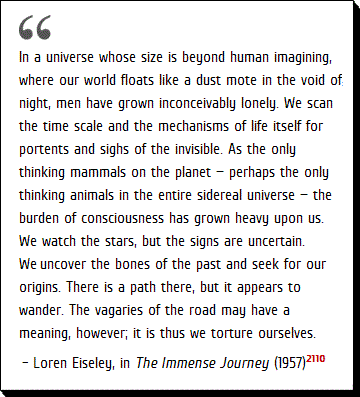 |
| The cosmic panorama |
We now cast our eyes skyward to contemplate a still grander perspective than even human literature, folklore and ethics can afford — the boundless twinkling oceans of the star-dusted firmament. The one commutual aspect of existence we can be reasonably sure of is the physical universe, that breathtaking panoply of brilliant suns, blazing galaxies and luminous nebulae which human and alien astronomers alike must share.
There are countless reasons why the cosmic panorama per se is of xenological significance.
- Ultimately, of course, the astronomical environment serves as the backdrop for all our speculations about life on other worlds.
- If we are to successfully evaluate the ubiquity of biology in the universe, we must attempt to isolate those features which all lifeforms will find in common.
- We must puzzle out whether humanity, life, and Earth are unique events or merely a footnote to a statistic in the Galactic Census.
Knowledge of the evolution and distribution of stars and galaxies will suggest the most profitable places to hunt for evidence of extraterrestrial civilizations. But our curiosity tugs at us more insistently.
- Where will life be most abundant in the Milky Way Galaxy? In the central regions, the disk of the Galaxy, the spiral arms...?
- What kinds of stars are most likely to harbor lifeforms and planetary systems?
- How many other civilizations might there be, and what stage of development have they reached?
- What are the general constraints on xenopolitical systems as regards size, complexity and distribution?
- Are there any cosmological limits to high technology and galactic engineering?
We may also gain insight into the limits of alien philosophies of nature, the universe, and the very mechanism of creation itself.
- How did the universe come to be the way it is?
- Has it always existed? Will it ever die?
- Are physical laws as we know them immutable, or do they vary in different parts of the cosmos or at different times?
- Do other universes exist?
- Is there any purpose to physical existence at all?
These fundamental questions have gnawed at the mind of man for millennia, and must also intrigue the sentients of other worlds.
The issues of xenology are intimately bound up with the features and properties of the physical universe.
 |
| Ten billion galaxies |
On a dark, clear evening the human eye can distinguish several thousand distant suns, all of which lie in the Milky Way (our home galaxy). Floating freely in Earth orbit our senses would be assaulted by the light of nearly six times as many stars. The Palomar 200" optical telescope — now the second largest in the world — has the light-gathering power of a million human eye balls and extends our vision to several billion celestial objects in this galaxy alone. And about ten billion galaxies are observable with present-day astronomical equipment, the farthest (3C 123) lying eight billion light-years distant.1952
How big is the universe? An important clue was uncovered by the American astronomer Edwin Hubble back in the early 1920s, when he was measuring the atomic spectra emitted by various galaxies.
| Hubble Effect and the expanding Universe |
The farther away the object, he found, the more its spectral lines appeared to be displaced towards the lower frequencies of light. This curious phenomenon, which became known as the "redshift," was interpreted to be a kind of Doppler effect for photons.
- Much the same as a receding siren seems to be putting out lower and lower pitched sounds as it passes by, so do galaxies seem to emit redder light as they travel away from us.
- Since the most distant objects are seen to possess the greatest redshifts, the simplest explanation is that they are receding from Earth at velocities approaching the speed of light.
- Nearby galaxies are moving at a far more leisurely pace. Conclusion: The universe is slowly expanding.
This is not to say that Earth has the extraordinary good fortune to lie at the exact geometric center of all creation, simply because most all astronomical objects appear to be heading away from us.
- More correctly, our galaxy is like a spot of India ink on the surface of a spherical balloon.
- We are surrounded by billions of similar spots. As the balloon inflates, every point on its surface moves away from all adjacent points.
- From the chauvinistic viewpoint of each galaxy, all others will look like they’re flying away at various speeds depending on distance.
- Each will view itself as the "center" of the universe! This idea that the cosmos will appear roughly the same from any position is called the Cosmological Principle.
| The Hubble Constant |
The latest measurements of galactic redshifts seem to indicate that the speed of recession increases about fifty-five kilometers per second for each megaparsec* of distance from Earth.1953 (This number is called the Hubble Constant.) Since the maximum velocity of recession which can be detected is the speed of light, then the outermost shell of the swelling universe should lie about eighteen billion light-years from Earth.
Of course, if the "balloon" deflates, points on its surface will rush together again. Using our value of the Hubble Constant, we can mathematically run time backwards and extrapolate to Time Zero — the creation event. The inverse of the Hubble Constant is in units of time and represents the age of the universe assuming a constant rate of expansion. This works out to a period of eighteen eons!**
But scientists believe that the expansion of the universe has not been constant; on the contrary, it has probably decreased with the passage of time because of gravity. Taking this into account, the true age of the universe will not be quite so large, and is now usually set at about sixteen billion years.1953,1983 Our estimate of the radius of the universe, likewise corrected, drops down, to sixteen billion light-years.
Any theory of cosmology that purports to explain the mechanics of the cosmos must, at the bare minimum, be able to account for Hubble’s redshift phenomenon. The one proposal which has been most successful in this regard is the Big Bang hypothesis.
* 1 megaparsec(Mpc) = 103 kiloparsecs(kpc) = 106 parsecs(pc) = 3.26 × 106 light-years(ly) = 3.07 × 1022 meters(m).
** An eon is one billion (109) years.
 |
According to this leading view of cosmic evolution, the universe began as a highly compact fireball of pure energy and infinite density.
- After perhaps a millionth of a second this density dropped off to nuclear values as the ylem or "cosmic egg" exploded outward.2062
- The overall temperature may then still have exceeded 1013 K.1192
- The stuff of the universe started to change from pure energy into matter, primarily neutrons.
When half an hour had passed most of the neutrons were gone, replaced by a mixture of 60% hydrogen ions and 40% helium ions (by mass), as well as a smattering of deuterium (heavy hydrogen).1813
Using this model, it can be calculated that at the one hour mark, the temperature was down to about 250 million degrees; after the passage of a quarter of a million years, it had fallen off to the present temperature at the surface of Sol. And 170 K was reached after 250 million years following the big bang.
This turned out to be a red-letter date in the evolution of the universe, because for the first time in history the density of matter became greater than the mass density of radiant energy.
- Protons and electrons must have coalesced into de-ionized H, He, and D atoms, leaving no more than 0.1% still in the plasma state.1192
- This signaled a dramatic change in the behavior of material. No longer was matter incessantly sloshed and stirred by the overpowering radiation field, which had kept it permanently osterized in a thin, gaseous form.
- Once radiation refrained from dominating the scene, matter was free to gravitationally condense into relatively huge, massive aggregates — supergalaxies, galaxies, and stars.1813
 |
There are two variations of the Big Bang scenario upon which most discussion has focused. The first of these is known as the closed, or pulsating universe model.
- According to this thesis the universe is a gravitationally "bound" system.
- That is, some thirty eons or so from now the fragments from the original ylem explosion will cease their outward rushing and commence to fall back together again like the dots on the surface of a deflating balloon.
- Cosmic evolution occurs in a series of alternate expansions and contractions.
- At the very end, the Final Moment, everything is destroyed, the slate wiped clean in preparation for the beginning of the next eighty-billion-year cycle.
Besides giving rise to philosophical nihilism, this has interesting consequences for the development of life. During an expansion phase light is redshifted to the relatively harmless lower frequencies. However, during the contraction phase the intensity of dangerous high frequency radiation might become unbearable — due to a blueshift effect. If the pulsating model is correct, then we are lucky to be alive during the half of the cycle most likely to be hospitable to life. In the second half, the development and expansion of biology would be severely restricted. Are we, asks Carl Sagan, "trapped in a vast cycle of cosmic deaths and rebirths?"20
The second variant of the Big Bang theory is the open, or expanding universe model, which suggests that the cosmos will never stop enlarging and ultimately will disperse to infinity.
- In this view, all matter reached the "escape velocity" of the universe at the time of the ylem explosion: The cosmic radius increases indefinitely.
- This is in sharp contrast to the pulsating model, in which the radius oscillates between some maximum value and zero.
There is evidence to support the Big Bang theories. For instance, it will be recalled that the fireball cooled rather rapidly as it expanded. If this rate is extrapolated from the Bang to the present, sixteen eons later, the temperature should be down around a few degrees above absolute zero. This early prediction from evolutionary cosmology was verified in 1965 with the discovery of microwave radiation which fills the entire universe perfectly isotropically. The energy corresponds to a constant, uniform temperature of 2.7 K. This actual relic of the primeval ylem superexplosion strongly affirms the Big Bang theories, and appears to verify the Cosmological Principle mentioned earlier.
 |
How can we decide whether the universe is open or closed? It turns out that if the mean density of the cosmos is less than about 5 × 10-30 gm/cm3 (only about three atoms per cubic meter — intergalactic space is very nearly empty), then there is insufficient mass to hang onto the galaxies gravitationally. The universe would be open and must disperse to infinity.
Measurements of the actual density are difficult to make. However, based on the latest data, revised Hubble Constant, and such parameters as the observed density of galaxy-clusters locally and the abundance of deuterium in space,1959 astronomers have reached a tentative conclusion: The universe is open.1953
Another class of cosmological theories which has persisted for decades in various forms is the steady-state model, which suggests that the universe is not thinning out at all despite the apparent recession of galaxies. According to a typical model of this variety, neutrons appear suddenly out of nowhere in the interstellar void, roughly one particle per cubic meter every few eons or so. The local density is thus maintained at a constant level, the outflowing mass exactly balanced by the spontaneously generation of matter within the included volume.
|
Figure 4.1 The Hoyle-Narlikar cosmology |
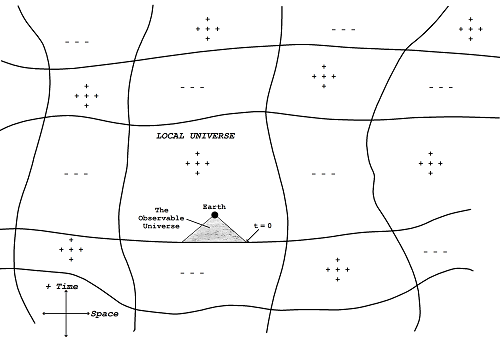 |
The most recent attempt to forge a more plausible steady-state model is the Hoyle-Narlikar cosmology (Figure 4.1).1956
This is based on the concept of a "mass field," which is such that the mass of a chunk of matter is dependent upon its spatial and temporal location in space-time.
- The universe consists of a checkerboard pattern of normal and reversed mass fields.
While mass never becomes negative, its value does vary from zero at a boundary to some maximum value defined by the field.
- Einstein’s relativistic cosmology is said to represent a special case,1955 valid near a boundary but not across it or very far away from it.
- Astronomer Hoyle infers that we are close to such a boundary.
|
Figure 4.2 The Local Universe |
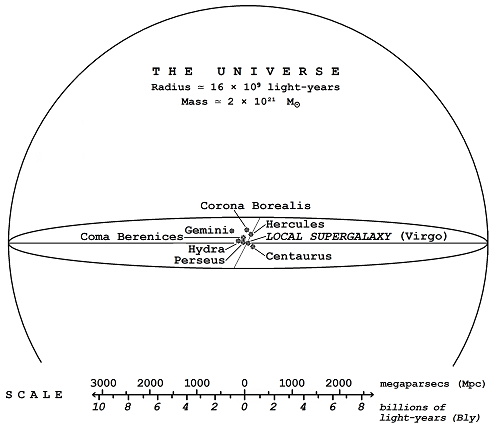 |
If mass has been steadily increasing since we crossed the border some sixteen billion years ago, then galaxies we passed along the way — which lie nearer the boundary — should have older, less massive atoms. If less massive atoms also have less massive electrons, these electrons should lie in larger atomic orbits and generally emit spectral lines of lower frequency. That is, the spectra should be redshifted. The observed redshift of galaxies is explained, not by their headlong flight, but because the electrons comprising their atoms are lighter in weight.1954
Hoyle also has an explanation for the 2.7 K background radiation. It is known that light is most efficiently scattered by particles of low mass. Hence, the boundary at Time Zero (where mass goes to zero) must completely scatter all radiation coming from previous cells. The background is just the smeared out starlight emitted by galaxies on the other side of the border. Hoyle calculates that such galaxies still exist prior to Time Zero as far back as 150 eons.1956
Many other unusual theories have been proposed from time to time, including:
- The Klein-Alfvén matter-antimatter cosmology.1192
- The universe-as-a-black-hole idea.1963 (and black holes as accretion nuclei for elliptical653 and spira1964 galaxies)
- The Everett-Wheeler "splitting universe" scheme.1982,3683
- And other multiple universe ("multiverse") theories.1512,1957,1958
The cosmological problem has not yet lent itself to a definitive solution. Perhaps it never will until we are able to ask ETs, situated elsewhere in distant space, for their observations and ideas.
|
Figure 4.3 The Local Supergalaxy |
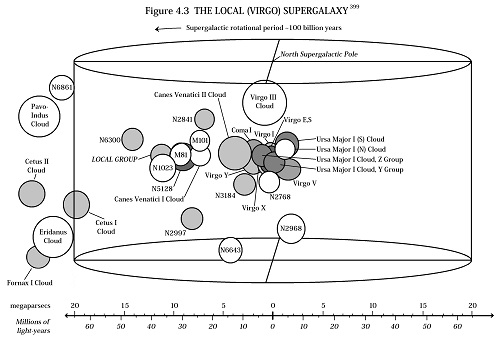 |
If the Big Bang theories of the universe are essentially correct, then it was not long after Time Zero on the cosmic time scale that matter began to condense gravitationally. Any small nonuniformities in the density of the heretofore homogeneous gas would be aggravated, and local condensations could begin to occur.
Today we bear witness to what astronomers believe is the end product of that grand condensation process: Stars. These giant plasma balls glow by the energy of intense thermonuclear fusion reactions, at temperatures reaching many hundreds of millions of degrees in their cores. These incandescent globes are collected into great structures called galaxies, which exist in many shapes and sizes. It is now known that galaxy-clusters also exist, assemblages of a few to as many as thousands of individual galaxies. More than 80% of all nearby galaxies belong to such clusters.1974,2150 The spaces between them are virtually devoid of stars, gas, and other matter.
A few astronomers today are of the opinion that order exists in the cosmos on an even larger scale. They claim to have discovered monstrous aggregates of galaxy-clusters possessing literally millions of individual galaxies, with masses ranging from 1016-1017 Msun each.20,399,1191,1271,1974,1985,3676
More than twenty nearby "supergalaxies" have been tentatively identified, having diameters from thirty to ninety megaparsecs.1974,1985 However, less than a dozen can be identified in much detail within about 160 Mpc (~500,000,000 light-years).399 (For comparison, the radius of the entire universe in the Big Bang cosmologies is roughly 4900 Mpc.) The spaces between supergalaxies is incredibly empty, even more so than between galaxies and clusters of galaxies.
We are believed to be embedded in the Virgo Supercluster, otherwise known as the Local Supergalaxy (Figure 4.3). The Local Supergalaxy is a squat, roughly cylindrical collection of nearby galaxy-clusters with a total mass of perhaps 1015 Msun.2025 It is about forty megaparsecs in diameter and twenty megaparsecs thick.399 Its radius is thus about 0.8% that of the known universe, which is about 10-7 of the total "volume" of the cosmos.
The Supergalaxy rotates counterclockwise as viewed from the North Super-galactic Pole, about once every hundred billion years. Since the origin of the universe, it has yet to make so much as a quarter-turn!
|
Figure 4.4 The Local Group1974,2025 |
 |
We are situated in a galaxy-cluster, called the Local Group (Figure 4.4), some twelve megaparsecs from the center of the Supergalaxy near Virgo I.
We are rotating with the Supergalaxy at about 2.5 million kilometers per hour, roughly 0.2% the speed of light.
The drawing depicts the approximate extent of the Local Supergalaxy as it is presently understood, along with the thirty-one largest galaxy-clusters* in this hemisphere. It should be noted that our own Local Group is the smallest of these.
* Galaxy clusters seem to form "clouds" within the main corpus of supergalaxies. The Local Group is a member of the Local Cloud of clusters. The Cloud is tilted about 140° with respect to the Supergalactic Plane.1984 The Local Cloud also possesses rather large regions of high-velocity neutral hydrogen gas clouds. These intergalactic gas clouds (IGCs) mass about 108-109 Msun, and sport about 100-1000 atoms per cubic meter.1986 In the Local Cloud of galaxy clusters, there are about twenty IGCs per cubic megaparsec.1986
|
Table 4.1 The members of the Local Group1945,1974,2025 |
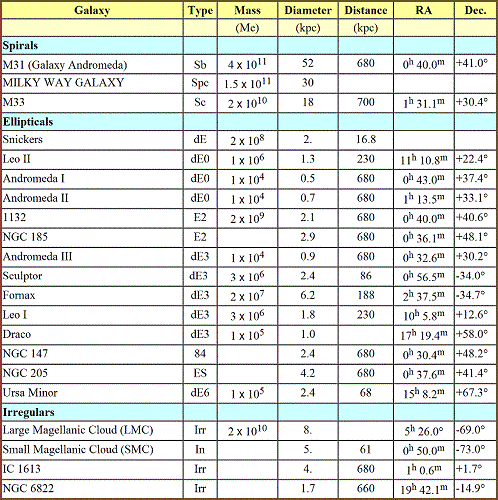 |
Galaxy-clusters range from as little as fifty kiloparsecs in diameter (Stephan’s Quintet, four member galaxies) to more than eight megaparsecs (Coma cluster, several thousand members). Ours is a modest-sized cluster, with twenty-one member galaxies and a diameter of 800-900 kpc.1974,2025 The Local Group is somewhat flattened in shape, with most components (Table 4.1) in the southern hemisphere of our Milky Way Galaxy.* Eleven intergalactic tramp globular star clusters have also been spotted, the lone gypsy wanderers of the forbidding intergalactic void.1974
* The largest Local Group member — Galaxy Andromeda — has an apparent velocity towards Sol, believed due to our rotation about the center of the Milky Way.1337 Andromeda is also tilted about 150° to our angle of view.2025
|
Table 4.2 Characteristics of galaxies1945,1974,2025 |
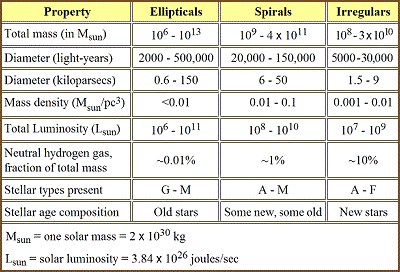 |
There are basically three kinds of galaxies: Irregulars, spirals, and ellipticals (Table 4.2). Irregulars are small, formless collections of stars, containing perhaps 109 Msun. These galaxies consist of about 10-50% neutral hydrogen gas and dust20 and have very few old reddish stars and very many young blue-white stars.1974 Much of the matter that could be utilized in the construction of stars hasn’t been used up yet.
Spiral galaxies have consumed far more of their hydrogen — only about 1% of the original amount remains, on the average. There are a fair number of both old and young stars. The typical spiral has three major components: The halo (a spheroidal volume of space with very old stars in highly elliptical orbits), the nuclear bulge or "core," and the galactic disk (which contains the spiral structure and most of the mass). Great dust lanes are usually very conspicuous throughout.20,1976
Elliptical galaxies are generally ellipsoidal in shape. Virtually all of the neutral hydrogen has been depleted, and there is little dust. Most of the building materials for stars are gone. Few suns have formed in very recent times; consequently, the stars tend to be very old.
The above taxonomy is not believed to be an evolutionary sequence, say, from youth to senility. Each of the three types of galaxy is thought to have originated in much different ways. For instance, if we start out with a very low mass protogalaxy, the hydrogen density will be low and stars cannot form very fast. An irregular galaxy is the result, such as the Large Magellanic Cloud in our own Local Group. If the mass is large but rotation is slow, then most of the hydrogen has a chance to condense into stars before the contraction causes angular momentum to rise prohibitively. The matter is consumed immediately, leaving none for later on. An elliptical galaxy is the end product of this process. Finally, if mass is high and rotation is fast, star formation will proceed with greater restraint. Stars may continue to form for many tens of billions of years. Such is the probable history of a spiral.20,1974
| Abundance of galactic types |
Current estimates of the abundance of galactic types run as follows: Spirals 60%, ellipticals 30%, irregulars 10%.1973,2150,2475 There are two subclasses of spirals, normal and barred. The arms of bar spirals attach to a thick girder of stars passing symmetrically across the center of the galaxy. (The Milky Way itself is believed by some to have a small football-shaped, bar-like structure at its center.1976) Normal spirals with spheroidal cores are twice as abundant as the barred variety. About a million large galaxies lie within a few hundred megaparsecs of Sol.20
About half of all galaxies are "dwarfs."1945 Dwarf ellipticals and irregulars exist; probably for dynamical reasons, there are no dwarf spiral galaxies.1945 Roughly 5% of all galaxies form physical pairs ("binary galaxies") or multiple systems, and at least 1% show some "marked visible peculiarity".1973
|
Figure 4.5 Great Ursa Major Spiral:M 101 / NGC5457 |
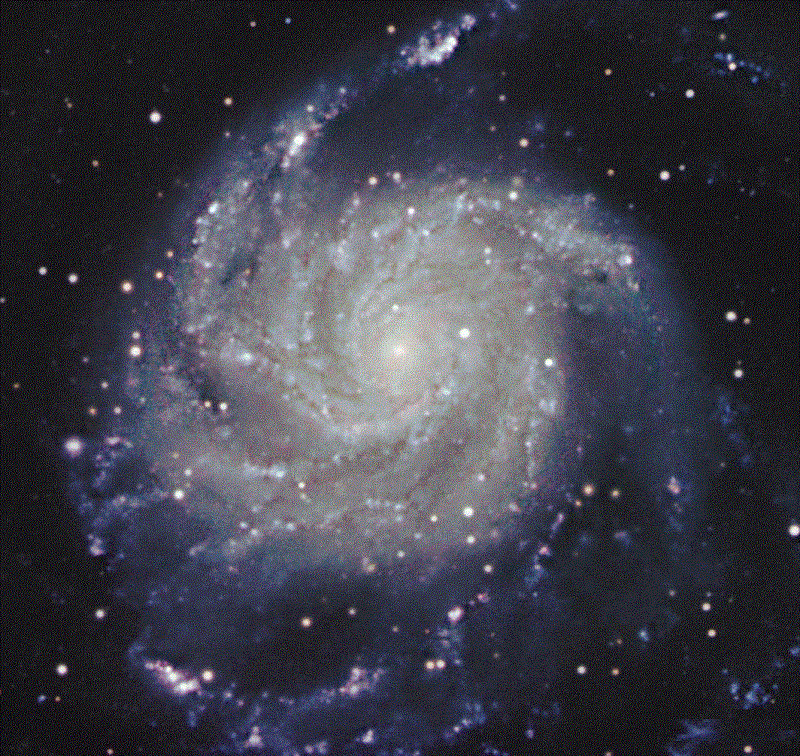
Figure 4.5 Great Ursa Major Spiral: M 101 / NGC5457.
Nearby spiral galaxy, yet outside our Local Cluster. (Mount Wilson and Palomar Observatories, Plate VIII from Broms1191) |
Which galaxies are most likely to harbor intelligent life? One of the prerequisites for life as we know it is a planetary environment in which to flourish. Perhaps an atmosphere and oceans are also required, along with an abundance of various carbonaceous chemical substances. It appears fairly safe to conclude that "heavy elements" (carbon, oxygen, silicon, etc.) must be present if life is to arise. Primordial hydrogen and helium alone won’t do.
Scientists believe that heavies are generated as a natural product of stellar evolution. Normal thermonuclear processes in stars produce elements that run the gamut from lithium to iron, and stellar supernovae generate still heavier atoms (iron through uranium). A single, good-sized supernova explosion may inject as many as 103 Earth-masses of heavies into the interstellar medium.
Over a period of billions of years, the stuff from which stars are born has become more and more enriched with heavy elements. Ultimately, this has made possible both planets and the development of life. But where are these heavy atoms most abundant?
It is generally agreed that dwarf galaxies are extremely metal poor.1816,1818 Consequently, we may immediately eliminate about half of all galaxies from contention.
We also know that virtually all stars in elliptical galaxies were formed at least ten billion years ago, soon after the Big Bang.1974 Although there is some evidence that the heavy element deficiency is small or negligible compared to our Galaxy,1816 if the theories of stellar nucleogenesis are correct then elliptical galaxy stars appeared long before the interstellar medium was impregnated with heavies. So ellipticals probably contain fewer habitable worlds.
Spectroscopic data for irregular galaxies indicate a marked deficiency in heavy elements,20 as much as 30% less than in our Galaxy generally.1816 Irregulars are slow starters — the ambient gaseous medium probably has not been sufficiently enriched to produce as many planetary systems. Furthermore, the available mass in irregular galaxies tends to run a couple orders of magnitude less than that available for star-building in ellipticals and spirals.1945 We would therefore expect somewhat fewer sites for life than in our own Galaxy.
| Biology favors spiral galaxies |
It appears that the best place to look for biology is in the spiral galaxies (Figure 4.5),2032 a conclusion tentatively affirmed by our presence in one. This is indeed fortunate, since these comprise a majority of all giant galaxies.
|
||||
|
Our Galaxy is a rather typical spiral, consisting of three distinct regions (Halo, Core, and Disk) and four distinct components (stars, gas, dust and high energy particles) (Figure 4.6).
The Halo is a rather thin distribution of very old stars, spread out roughly spherically to a radius of twenty-five kiloparsecs or more from center. Probably about 5% of the entire mass of the Milky Way lies in the Halo1781 (~17% of all stars1816). The Core is several kiloparsecs in radius, and stellar densities rise to values millions of times higher than near Sol. This closely-packed nucleus of our galaxy contains perhaps 10% of all stars.57,1976 The main disk of stars is a bit more than fifteen kiloparsecs (50,000 ly) in radius and averages about one kiloparsec thick. Sol is located only ten parsecs above the Galactic Plane,20,57 and about ten kiloparsecs from the center.20,1945,1976
The gross mass of the Milky Way is about 1.5 × 1011 Msun (3 × 1041 kg), representing a total of perhaps 250 billion stars of various types (Figure 4.7). Its aggregate energy output is roughly 5 × 1037 watts, and it rotates once every 240 million years in the clockwise direction as viewed from the North Galactic Pole. The Milky Way has made some fifty revolutions since its initial condensation twelve billion years in the past, and Sol has traveled nearly twenty full circuits since the origin of the Solar System about 4.6 eons ago.
The stars to be found in each of the three regions of the Galaxy are of distinctly different character. The Halo "Population II" suns are very old, reddish stars with heavy element abundances hundreds of times less than in the vicinity of Sol and in the Disk generally.1945,2032 These stars have highly elliptical orbits around the Core, and appear to be a relic of an earlier evolutionary stage of the Milky Way. Both individual stars and giant spherical collections (called globular clusters) inhabit the Halo. Globulars usually have 105-106 old Population II stars, and run 20-100 parsecs in diameter.1556,1973
The Disk "Population I" comprise the bulk of the stars in our Galaxy. Sol and most of our stellar neighbors are members of this population, although there are certainly a few Halo stars kicking around in the Disk (only about 3-5% of all stars near Sol1816). Disk stars have nearly circular orbits about the Core, and are pretty well confined to a layer one kiloparsec from the Galactic Plane.1780
It is believed that the Core is also comprised of Disk Population I stars, but there are some peculiar differences. The Core suns tend to be very old, reddish objects much like the Halo population, and yet the abundance of heavy elements appears to be at least six or seven times higher than in the Disk, near Sol.1818
| Interstellar gas |
Like the stars themselves, interstellar gas is composed mainly of hydrogen (about 60% by mass) and helium (about 40% by mass). These gases, whether neutral or ionized, occur in discrete patches several parsecs wide in concentrations of more than ten atoms per cubic centimeter. A few exceptionally small, concentrated clouds exist with densities well above 1000 atoms/cm3 — as in the Orion Nebula and the Horseshoe Nebula.1816 In the Milky Way there is an estimated 6 × 107 Msun of ionized hydrogen and 1.4 × 109 Msun of neutral hydrogen, for an overall density of about 0.6 atoms/cm3.1945
| Interstellar dust |
Both gas and interstellar dust (dust mass ~106 Msun or less) lie flat in the Disk, confined to within two hundred parsecs of the Galactic Plane.1816 The presence of this dust (10-3-10-4 cm particles) obscures visibility along the Plane by absorption and scattering of light — which limits our view of the Galaxy in the optical spectrum to a few thousand parsecs along the line of sight.20,1972
But it is important to keep in mind how truly thin this dust is dispersed. While we find at least one atom of hydrogen in each cm3 of interstellar space, there is only one tiny dust flyspeck in a cube of space twenty kilometers on an edge.
New stars are constantly forming in these dust clouds, as well as larger grains of "dirty ice."1972 Blast waves from novae and supernovae, galactic winds and wakes,1151,1960 and density waves that may be responsible for the spiral arms all propagate in this tenuous "galactic atmosphere."
|
Figure 4.8 The nature of the spiral arm feature of the Milky Way Galaxy |
|
|
|
We have until now neglected what is probably the most interesting feature of the Milky Way — the spiral arms. Contrary to common belief,607 they are not concentrated regions of stars. The brilliant arms of spiral galaxies have less than 5% more stars than interarm regions (which is where Sol is).57 The most visible among these few extra stars are the class O and class B suns, the gas-guzzling "cosmic Cadillacs" of the Galactic showroom. These showy white stars are very massive and very young, and they consume all their hydrogen fuel in a relatively brief time. The spiral arms are regions of much higher gas density, marking off the boundaries of the maternity wards of the Milky Way. All normal Disk stars, as well as O and B classes, are born there.
Were we to photograph the Disk so as to eliminate the 0.1% or so of ostentatious O and B suns, we would see an almost flat, featureless distribution of normal stars (Figure 4.8). It is only because of a very few bright stars that we have any visible spiral structure at all. Hence, the Galaxy really appears to be a solid dish of common yellow and red stars with a very light sprinkling of hot, white ones in a generally spiral pattern.
Since O and B stars have such short lifetimes, most of them die before their orbits can carry them very far from where they were born. A few do escape, however, and become mixed in with the rest of the stars. (Regulus, in the constellation Leo and about 26 parsecs from Sol, is one such escapee.) O and B suns are largely confined to within 70 parsecs of the Galactic Plane,1780 and have virtually perfect circular orbits around the Core in the Plane. These stars are sometimes referred to as "Extreme Population I."
There is one minor complication to the view of the Milky Way presented thus far. The concentration of hydrogen in the spiral arms is a stable feature of the Galaxy, and is thought to represent a wave of greatly increased gas density traveling across the Disk. Where density is highest, the hot O & B stars can be formed, trailing from what amounts to a galactic density-shockwave.
|
Figure 4.9 Position and orientation of Earth and Sol in the Milky Way Galaxy |
|
|
|
We recall that Sol orbits the Core (Figure 4.9) approximately once every 240 million years. The problem is that the spiral density wave circles the Galaxy at a much slower rate, about once every 400 million years. Consequently, the bright spiral arm stars trail forward,* not backward, from the leading edge of the bow shock.1976
The distribution of life in the Milky Way is intimately connected with Galactic evolutionary history.1811 The Halo population is the oldest sub system, remnant of the first stars and star clusters formed from the original virgin hydrogen cloud — the protogalaxy — 12 eons ago. As the cloud gravitationally condensed and began to rotate faster, it flattened out and became more dense.1809 It has been estimated that about a hundred million years were required for the gas to fall ten kiloparsecs to the Galactic Plane.1827 During this time the Disk population was formed (after the Halo), which soon found itself rich in heavy elements.1807 The spiral arm population is the youngest subsystem of the Milky Way (105-109 years old), is also rich in heavies, and is closely restricted to the Plane.1945
* Sol's forward motion should carry us into the Orion Arm in 107 years or so.
|
Figure 4.10 Heavy element abundance and distribution in the disk of the Milky Way Galaxy57,1972 |
|
|
|
The abundance of heavy elements increases markedly toward the center of our Galaxy (Figure 4.10). The concentration in the Core is an order of magnitude higher than near the rim of the Disk, and as much as three orders of magnitude greater than in the Halo. Based on the distribution of heavies, where might we expect to find planets and life?
It is difficult to avoid excluding the oldest Halo stars, orbiting high above the plane of the Galaxy.33 For the most part, these stars are extremely metal-poor. In addition, they are few in number, widely dispersed, and exceedingly dim because of their distance, Halo population II stars generally are not a good place to look for biology.312,1633
Globular clusters are conspicuous collections of hundreds of thousands of individual suns. There may be as many as 2000 such clusters in the Galaxy,1973 but at present only about 200 are known to exist for certain.1807,1945 Since the component stars are population II, they, like the lone Halo objects, are exceedingly poor in metals. This alone would be enough to rule out all but the slimmest chance of finding life,1633 but there are other problems. For instance, stars in these clusters are so tightly packed that encounters between them may become important inasmuch as the stability of planetary systems is concerned.352 Also, a large number of the stars have left the "main sequence" (see below) and have become red giants. This stage of their evolution is marked by large variations in luminosity and dramatic increases in stellar radius.20,1556,1973 It would appear that globular clusters are not fruitful places to search for intelligent lifeforms.
|
Table 4.3. Star Densities at the Galactic Core1821 |
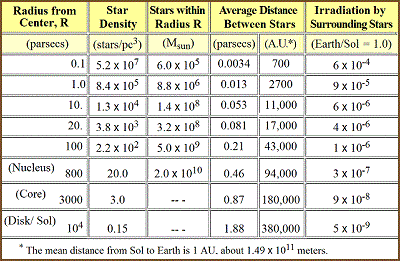 |
If not in the Halo, how about the Core? As discussed above, the central regions of the Galaxy are more metal-rich than anywhere else in the Milky Way. The potential exists, therefore, for a vast multitude of terrestrial-like planets and planetary systems. There are probably also large quantities of organic and inorganic molecules near the Core — just what’s needed to start the ball of life rolling.1816,1961
| Objections to Core life |
One quick objection to life at the Core might be that with such an immense concentration of stars in such a small volume (Table 4.3), the radiation flux might be too intense. However, simple order-of-magnitude calculations reveal that this is not a problem. Even in the innermost recesses of the nucleus, the total radiation received by a habitable planet will be no more than 0.06% in excess of that received from its primary. This should not be incompatible with an otherwise stable environment.
However, more serious objections to Core life may be raised. For example, we know that on the average about one supernova occurs every fifty years in a typical spiral galaxy.1962 In general, a hundred light-years is considered the distance of minimum biological effect for supernovae468,469,498 (Astrophysicists Krasovskii and Sagan have suggested that one nearby supernova event about 108 years ago may have contributed to the extinction of the dinosaurs.20) Since there are about 104 stars within 100 light-years of Sol, the mean time between catastrophic events is about two billion years, a comfortably lengthy period of time.20 On the other hand, there are more than two hundred million stars within 100 light-years of the center of the Galaxy. Assuming the same supernova rate, the mean time between damaging events would be reduced to 50,000 years. This may well prove intolerable to life.
Another argument against populating the Core is based on dynamical considerations. The grand game of stellar billiards, involving close encounters and collisions between stars once every million years or so,20 could make life in the central regions quite impossible. As Dr. R. H. Sanders and Dr. G. T. Wrixen of the National Radio Astronomy Observatory put it: "It is doubtful that there would be any life on planets in the galactic nucleus, since with such high stellar densities close encounters between stars would be so frequent that planets would be ripped out of their orbit every few hundred million years."1961 But this argument loses much of its appeal if we consider the outer Core regions (say, from 1-3 kiloparsecs out) where the star density is only an order of magnitude or so above Sol-normal.
Finally, there are indications that violent events are occurring at or near the Core. Astronomers Burbidge, Hoyle and Lequeux have hypothesized that the expanding 3-kpc arm observed near the Core could be the result of an explosion that savagely ripped through the central regions a mere twenty million years ago.1816 More recently, this theory has been refined to the following numbers: Titanic explosions may occur every 500 million years, releasing some 1053 joules of energy (equivalent to total conversion of half a million solar masses into pure energy), followed by an ejection of one billion solar masses of matter.1961 Needless to say, this would be an extremely disruptive event. [Note added in 2008: Many astrophysicists now believe there is a black hole at the center of the Milky Way Galaxy.]
It appears doubtful that life will have evolved in the nucleus of our Galaxy, although biology in the outer Core regions is entirely possible. Looking at it from an aesthetic point of view, the spacescape enjoyed by the in habitants must be fantastically beautiful. Hundreds of stars would appear brighter than Sirius, our brightest. Their most luminous suns would be an order of magnitude brighter than Venus is to us.1360 Starlight filtering through thick, patchy dust clouds near the nucleus would produce interesting optical effects. The evening sky at the Core would be as bright as moonlight on a clear night on Earth — total darkness might be unknown to these extra-terrestrials. But stars would still look like mere points of light. Only within one parsec of the center of the nucleus would supergiant stars appear as distinct globes to the naked human eye.
Where else can life exist in the Milky Way? Scientists believe that the most likely place for life will be in the Disk, both in the interarm and spiral arm regions. Heavy elements are plentiful there, and planets should be numerous.2032 Stars are far enough apart to preclude close encounters, and supernovae are few and far between. Finally, most of the stars in the Galaxy may be found in this region.
There is every indication that extraterrestrial life will be abundant throughout the volume of the Disk.
|
Figure 4.11 Stellar number density near Sol, and stellar contraction time, as a function of stellar mass57,1808 |
|
|
|
Stars come in many sizes, brightnesses, shapes and colors. In Orion we find the beautiful orange-red Betelgeuse keeping company with the brilliant bluish-white Rigel. In constellation Auriga lies the Sol-like familiar yellow star Capella. The brightest star in Libra, named Zubeneschamali, is naked-eye green in color and is best seen low in the midnight summer sky.1191
More than two-thirds of all stars form multiple systems — double stars, triple stars and more. With a telescope one can observe the gold and blue splendor of g Andromedae, the twin red and green suns of a Hercules, and the exquisite orange, yellow and blue of zCancri.49 The stars in eclipsing binaries are often extremely near to one another, so close that the tidal force pulls the smaller sun into an ellipsoidal shape. Gigantic beautiful whorls and ribbons of luminous matter flow from one to the other in complex patterns so faint they can only be witnessed visually by the local inhabitants of these systems. Even with our most powerful telescopes we cannot actually see these processes but must infer them from indirect evidence.20
Besides color and shape, stars differ markedly in their relative luminosity. This property varies among suns across more than eight orders of magnitude — as much as a hundred thousand times brighter, to more than a thousand times dimmer, than Sol.
| Star groups |
If the spectra of a large number of stars are compared, however, certain regularities immediately become apparent. All stars can be divided into relatively few groups whose spectra all look pretty much the same. These are the classes O, B, A, F, G, K, and M. (There are a few others — R, N, S — but these are of lesser importance.)*
We’ve already seen that the O and B stars are the hot, short-lived, young and massive suns of spiral arm fame. Classes A and F are less hot and have longer lifetimes. Sol is class G. But the majority of all stars fall into the two classes K and M. These are relatively feeble, undistinguished objects, yet they burn little fuel and live extremely long lives — more than ten thousand times longer than their O and B counterparts. Luminosity, then, is a rough index of both the rate of fuel consumption and the life span of a star.32
Numbers from zero to nine are used to further subdivide the spectral classes. For instance, a G0 sun is more luminous than a G5, which in turn is brighter than a G9 — the dimmest in the G class. The next-faintest star, of course, would be K0. M suns are the feeblest of all.
The brightest star on record is class O5, since objects from O0 to O4 have not been found. Stars with numbers between zero and four are often referred to as "early," while those with higher numbers are considered "late." Sol, technically a G2 sun, would thus be viewed as an "early spectral class G star."
Stellar mass, in contrast to luminosity, is restricted to within relatively narrow limits (Figure 4.11). Few stars have masses beyond an order of magnitude more or less than Sol’s. There is good reason for this.
* Traditional mneumonic: "Oh Be A Fine Girl, Kiss Me Right Now. Smack!" Suggested non-sexist mnemonic: "Out Beyond Andromeda, Fiery Gases Kindle Many Red New Stars."2111 The modern version doesn’t seem to be catching on.
A star in the process of formation is a battleground for two opposing forces which struggle constantly to gain the upper hand. Gravity, which tries to collapse the ball of gas into a small volume with high density, is counteracted by radiation pressure, which grows more intense as the star’s thermonuclear furnace kindles and catches. The protostar shrinks to the point where radiation and gravity exactly balance each other, and relative stability is achieved.
Below about 0.01 Msun the ball of gas just sits there, big and cold. Gravitational forces predominate. Internal pressures are just too low for nuclear fires to ignite. Dr. Hong-Yee Chiu at the NASA Institute for Space Studies calculates that stellar mass must be greater than about 0.02 Msun for fusion reactions to be initiated.1314 This prediction squares well with observations. The lightest stars known — of M9 class — are all at least 0.05 Msun or more. Jupiter, the gas giant planet and possible arrested protostar, masses only 0.001 Msun.
In the direction of higher mass, Chiu calculates that if the body exceeds about 30 Msun the radiation pressure must be so great it would literally blow the star apart. Indeed, the largest stars known mass very close to this value.1314
|
Figure 4.12 Hertzsprung-Russell Diagram |
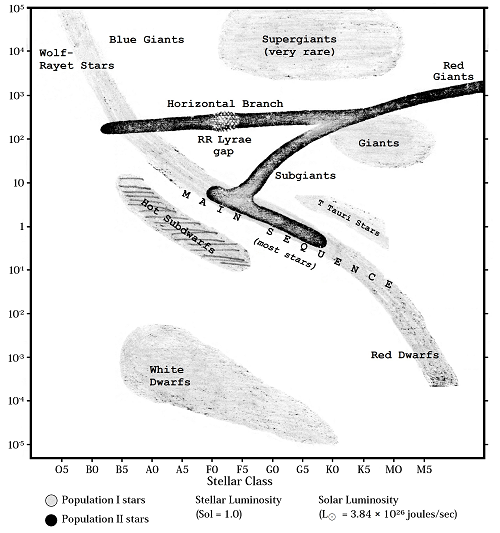 |
The Hertzsprung-Russell diagram (Figure 4.12) is a plot of luminosity as a function of stellar class. About 91% of all stars fall neatly onto a narrow strip running diagonally from top to bottom. This is known as the main sequence.
The main sequence is not an evolutionary track, and is perhaps best thought of as a "house" in which a star resides for most of its life. It is believed that the earliest stages of stellar evolution involve the condensation of a giant cloud of gas and dust many light-years in diameter and massing perhaps 1000 Msun.1945 As contraction proceeds, the material fragments into many smaller globules until only tiny pieces remain. These units contain a few Msun of matter and measure about a light-year across.
As the protostar shrinks its gravitational potential energy is converted to heat, and after millions of years the object has drawn itself together as a warm cloud about the diameter of our solar system (say, 40 AU). At this point, energy resources are shifted to ionizing instead of heating the gas. The protostar shrinks down to less than 1 AU in perhaps twenty years or so.1808
A star suddenly appears in the midst of the whirling gas. We see that the actual contraction phase is very short, lasting less than one percent of the sun’s total main sequence lifetime.57
These T Tauri stars are stellar newborns, and their luminosity fluctuates erratically with time.20 Another peculiar feature of such objects is the blowing off of prodigious quantities of matter. It has been estimated that the original protostar loses from 30-50% or more of its starting mass in this fashion.85,473,1945 Hydrogen burning begins as the T Tauri stage draws to a close, and the star enters the main sequence as a full adult.1808
|
Table 4.4 Typical Characteristics of Stars and Stellar Types |
 |
Naturally, not all stars of the same mass cease contraction at the same position on the H-R diagram. Those protostars which are deficient in heavy elements — such as might be the case in globular clusters — arrive at the main sequence at a considerably lower luminosity than most Disk stars. These are called the subdwarfs.20,1945
For most normal suns, however, the mass determines both the point of entry onto the main sequence and the length of time of residence there (Table 4.4). Large O and B stars enter high on the sequence, and remain only a few tens of millions of years; the bantamweight K and M suns enter near the bottom and stay for tens of eons. Luminosity on the main sequence increases only very slightly with the passage of time. Sol, for example, has grown only 20% hotter since it left the T Tauri stage five eons ago.20
Stars are evicted from the main sequence only when all or most of their hydrogen fuel in the car has been exhausted. With the sharp reduction in radiation pressure the core contracts. Hydrogen gas in the outermost shell begins to burn. Collapse of the core raises the temperature there, so that helium-, carbon-, and ultimately oxygen-burning become possible. The star thus separates into two rather distinct components — diffuse burning shell and dense, hot core.
In this "red giant" stage, the shell of hydrogen may be gradually driven outward leaving a brilliant white core behind. (Stars which have left the main sequence remain red giants for perhaps 1% of their total lifetimes.) This "white dwarf" soon finishes off the remainder of its fuel and all fusion reactions cease. A white dwarf slowly cools to become an invisible black dwarf. Life for Sol-sized stars ends as inauspiciously as it began — as cold, dark matter.
More massive suns have more spectacular deaths. Stars about 30% heavier than Sol go supernova, leaving behind a small, dense object called a neutron star — essentially a gigantic atomic nucleus, perhaps ten kilometers in diameter, spinning furiously in space.1214,1314 Densities run about 1014 times higher than that of lead. The pulsar in the Crab Nebula is one of many such objects observed by astronomers in the last decade or so.
Suns with initial masses of 3 Msun or more also supernova, but instead of neutron stars these titanic explosions create spherical nuggets of gravitationally collapsed matter that have come to be known as black holes.* These holes in space represent such a high local mass density that light itself moves too slowly to achieve escape velocity at the surface. Observational astronomers think they’ve detected one "BH," probably a couple kilometers in diameter, located in the constellation Cygnus.1970
When a star leaves the main sequence, so much energy is released that any life present is probably destroyed. Consequently, as far as the search for extraterrestrial life is concerned, only main sequence stars need be considered as possible candidates for habitable extrasolar systems.328 T Tauri objects, giants and supergiants, white and black dwarfs all may be eliminated from consideration. Fortunately, this still leaves us with about three-quarters of all suns in the Galaxy as putative abodes for life.
| Genesis time |
We know that life required 4.6 eons to arrive at its present stage of development here on Earth. Even if a certain margin of variation is allowed to account for differing speeds of evolution on different planets, the first fossil records of marine invertebrates don’t appear until the opening of the Cambrian Period a mere 600 million years ago. It is plausible to conclude that at least three or four eons — the so-called "genesis time" — may be required on any planet for intelligent life to gain a foothold.214
If this is indeed the case, then life will be restricted to stars of class F5 and later.57,328 Suns of earlier classes remain on the main sequence for less than the critical genesis time of several billion years, rendering improbable the emergence of intelligence.
* The properties of black holes are fascinating, and many excellent reviews have been written, including those by Thorne,1965,1966,1967 Penrose,1968 Kaufmann,1971 Ruffini and Wheeler,1969 and Hawking.2021
|
Figure 4.13 Stellar rotation vs. spectral class (Main Sequence stars only)20,328 |
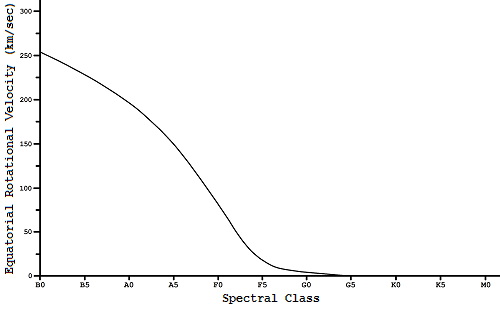 |
Another argument in favor of class F5 as the early cutoff point is based on measurements of stellar rotation among the various classes of stars. There appears to be a sharp break at F5 in the amount of angular momentum possessed by suns (Figure 4.13). This conspicuous phenomenon can reasonably be explained by invoking the presence of planets.1278
It is suspected that the birth of planetary systems is closely linked to the contraction and evolution of the primary. Approximately 98% of the angular momentum of our solar system is carried by the planets — which represent only 0.2% of the total mass!
The hotter, fast-rotating stars are thought to be devoid of planets because they still retain the high initial rotation rate caused by the condensation of the original protostar. Cooler stars, later than F5, appear to have lost this great rotation somehow. One reasonable interpretation is that, like Sol in our system, these stars invested most of their angular momentum in their planets during the process of solar system formation.328
|
Figure 4.14 Stellar ecospheres (habitable zones) |
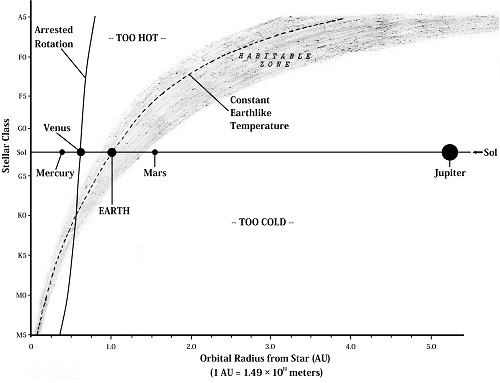 |
What is the smallest star that can harbor life? To answer this question we must briefly consider the concept of habitable zones or stellar ecospheres (Figure 4.14). An ecosphere is that region of space surrounding a sun where the radiation is neither too strong nor too feeble to support life. Too close to a star and a planet will fry; too far away, and it will freeze. The habitable zone lies between these two extremes.
Dr. Stephen H. Dole of the Rand Corporation has defined the limits of ecospheres so as to ensure that at least 10% of the surface of a world remains habitable all the time.214 Dole estimates that to accomplish this the radiation from the primary must be within 35% of Earth-normal. (This may be too pessimistic57,600 or too optimistic1907,2031 to suit some, but it’s a good first guess.) Of course, the size of the ecosphere will vary from star to star, the less massive dim suns having much smaller zones of habitability than the more massive, brighter ones (Table 4.5). And planets must huddle closer to cooler stars to keep warm; the ecospheres of F stars will lie at considerably greater distances than the zones surrounding, say, class K suns.
Another argument frequently advanced is that since K and M stars have relatively close ecospheres, planets within these habitable zones will become partially or totally tidally locked to their primary. That is, such planets would rotate extremely slowly; worse, they might become one-face worlds, always presenting only one side to the sun for heat. This could result in the atmosphere freezing out on the cold side57,214,1908 or other environmental severities.20
Stars massing less than 0.7 Msun may have ecospheres so narrow and close as to possess no havens from such rotational arrest.214 This corresponds roughly to stellar class K3. On the other hand, K2 and earlier stars should have at least a small region within their habitable zones in which tidal braking is much less severe.
|
Table 4.5 General Planetary Orbital Parameters for Habitable Zone vs. Stellar Mass |
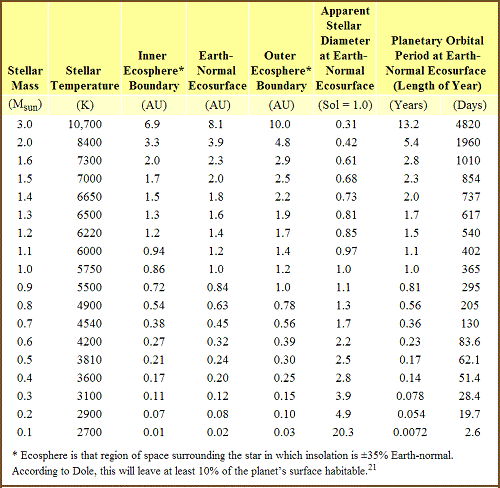 |
Dr. S.I. Rasool at NASA has also suggested that the atmospheric evolution of planets may be critically dependent on the amount of ultraviolet radiation emitted by the primary.376 A deficiency in the UV could mean that the hydrogen and helium in the primeval solar system might not have a chance to dissipate from even the innermost planets, which would remain large, gaseous, and quite jovian. (Also, it is believed by some that M suns may be "flare stars," which emit sudden blasts of deadly UV at random intervals.57,1775)
But there are more serious complications involved in the ultraviolet problem. The steady-state intensity of UV radiation at the surface of the primitive Earth was at least an order of magnitude greater than the next most abundant source of energy.1017 An ultraviolet deficit might greatly slow or even preclude the origin of life and early biochemical evolution.
It would appear that class K stars radiate at least an order of magnitude less UV than class G, although this has been disputed by some.57,1775 Class M suns are even more niggardly, emitting less than 1% as much UV as Sol at equivalent locations within their ecospheres. The evidence, while far from conclusive, seems to rule out stars later than early K as possible abodes for life.214,1018
|
Figure 4.15 Planetary surface temperature inside habitable zones |
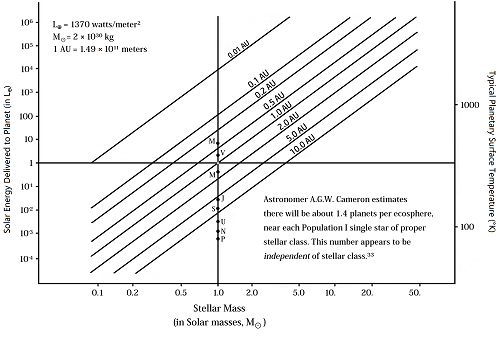 |
As a first approximation, then, we choose to limit ourselves to population I stars in classes F5 through K2 on the main sequence — perhaps 11% of all Milky Way suns (Figure 4.15).
There is one further restriction on our selection of life-supporting stellar environments.2148 About one-third of all stars occur in pairs (binary stars), and some two-thirds occur in multiples of all kinds (binaries, trinaries, hexastellar systems, etc.).20 There should be less chance of finding habitable worlds in multiple star systems because of the relatively large variations in planetary surface temperatures (due to the peculiar convoluted orbit traced by a planet circling many suns).50,1020,1053 The danger of "slingshot" ejection must also be reckoned with.
Calculations reveal that if the components of a binary star system follow relatively circular orbits and are either very close together or very far apart, stable orbits and moderate planetary temperatures are possible.214* Dr. Su-Shu Huang, formerly a physicist at NASA’s Goddard Space Flight Center in Washington, made a preliminary determination of habitable orbital configuarations near binaries whose components are roughly equivalent in mass.1020
If good planetary orbits are to exist, the two stars must lie either less than 0.4L½ AU apart or more than 13L½ AU apart, where L is solar luminosity in Solar units, Lsun.
Of course, if either component of a binary system is class F4 or earlier, then both are unlikely to have been around sufficiently long for intelligent life to have arisen (though planets and simple lifeforms are not precluded). We also must reject population II binaries, as well as those which have a red giant, white dwarf, neutron star or black hole as one member of the pair.1018
Dr. T.A. Heppenheimer at the Center for Space Science in California has completed some simple calculations on the formation of planets in binary systems.1300 His preliminary results indicate that, taking into account the typically large orbital eccentricity (e ~ 0.5) found in binary star systems, the components must actually be separated by more than 30 AU if they are to provide suitable habitats for biology. Apparently about one-third of all F5-K2 binaries within five parsecs of Earth satisfy this requirement.575,1300,2029
In conclusion, our quest for life on other worlds should be limited to perhaps 5% of all stars in the Galaxy. The basic search therefore encompasses some ten billion suns, most of which lie in the Disk and outer Core regions of the Milky Way.
* It has been suggested that the Trojan points of double stars might be a good place to look for habitable planets.607
|
|||
|
|||
|
| Catastrophic theories |
Historically, scientists have been willing to populate the Moon, Mars, and even Sol with a great multitude of living beings. But they often were loath to extend this cosmic fecundity to regions outside our own solar system.
- The main hangup was that until only a few decades ago, the very idea of an abundance of planets circling other stars was scoffed at by most professional astronomers.
- Sol’s family of worlds was believed to be an extreme rarity, if not an absolutely unique event, in the Galaxy.
The cause of this pessimism regarding possible habitats for life in the universe was due in part to the currency of the so-called “catastrophic” theories of solar system formation.
- These held that the planets were born when a vagabond star passed too close to Sol, ripping away rather sizeable hunks of solar matter.
- The filaments of star-stuff then condensed into solid worlds, which fortuitously assumed nicely circular orbits around the sun.
The problem with this model is that stars are very far apart in the Disk of the Galaxy, so collisions of this sort must be quite improbable. The catastrophic theories lead to the inevitable conclusion that there are less than perhaps twenty solar systems in the entire Galaxy.20 This, in turn, implies that few if any habitable worlds exist outside our own solar system.
| A dramatic turnabout |
In the 1930s and early 1940s a dramatic turnabout in attitude occurred.2038
- Young stars in the process of formation were observed to be embedded in dense dust clouds lacked by older stars.
- Young stars were also seen to possess large amounts of angular momentum which older stars don’t have.
- Nearby suns were observed to wobble very slightly from side to side as they traveled through space, as if thrown off balance by the presence of a heavy, unseen companion.
- These and other observations were hailed as strong evidence that many, if not all stars, are accompanied by a planetary entourage.
Today, astronomers think of solar system formation, not as an exceedingly rare event, but as a normal and common adjunct to stellar evolution.
- With two hundred billion stars in our Milky Way Galaxy, and more than a billion galaxies in the universe at large, the number of possible habitats for life becomes truly staggering.
- If there are 1020 planetary systems throughout the cosmos, then on the average more than a million of them are born every hour.20
The central objective of the science of general planetology is fairly straightforward:
- To study the physical and chemical properties of all non-self-luminous material bodies, whether they occur in our own system or in orbit around some distant star.*
A planet, consequently, is defined as any aggregate of matter possessing insufficient mass to sustain spontaneous thermonuclear reactions in its interior.214
| Xenology and planetology |
Xenology has two questions to ask of planetology.
- First, exactly how common are solar systems in the Galaxy? How many of them are there, under what conditions do they arise, and where are we most likely to find them?
- Questions of planetary evolution and distribution are of immense xenological importance, both in the practical sense of knowing where to search for extraterrestrial life and in the theoretical sense of being able to assess the uniqueness of life on Earth.
The second question posed by xenologists is whether or not our solar system (Table 5.1) and home planet (Table 5.2) are "typical" ones.
- This is basically a test of the Hypothesis of Mediocrity. Are conditions here roughly the same as on worlds circling other suns, or are things vastly different?
- What is the allowable range of planetary characteristics such as surface temperature, pressure, gravity, atmospheric composition, lithospheric structure, meteorology, seismology, and so forth (Figure 5.1)?
- Virtually anything we can learn about a planet enhances our understanding of the lifeforms indigenous thereto. It has been said that there is no property of a planet that is not of some xenological significance.630
* The reader is strongly advised to peruse a copy of Stephen Dole’s Habitable Planets for Man,214 which is an excellent introduction to general planetology with an eye to the specific problem of finding human-habitable worlds.
To decide just how abundant planets are in the Galaxy, the most logical place to start is with planetary evolution theory. If we can specify conditions conducive to the birth and development of solar systems, we may then compare these requirements to the observed Galactic environment and form a reasonable opinion as to the likelihood and frequency of planet formation.
Unfortunately, the array of historical planetary evolution schemes20,2033,2109 and the ongoing proliferation of both mundane1278 and unusual816,1264 models in modern times are beyond the scope of this book. We will not deal with them at length here, especially since excellent and comprehensive reviews are readily available elsewhere.20,600,816,1278,2025,2033
While all conclusions regarding planetary formation even today must be viewed as tentative, it appears that accretion models suffice to account for most of the observed properties of bodies in our solar system. In one theory which is gaining wider acceptance, a large, slowly rotating cloud of interstellar gas and dust about a light-year in diameter begins to slowly shrink. As it draws itself together gravitationally over a period of perhaps ten million years,1945 it becomes denser. Were it merely a glob of ordinary neutral gas, it would end up as a small, rapidly rotating ball of hydrogen. Most of its mass would be flung away unceremoniously — and there would be no planets.1549
But radiation generated during the contraction of the hydrogen ionizes the gas, converting it into a plasma — an electrically-charged, highly conductive but tenuous fluid. The Swedish physicist Hannes Alfvén, of the Royal Institute of Technology in Stockholm, was the first to demonstrate a viable mechanism by which angular momentum could be readily transferred from the protostar (the contracting solar nebula) to the surrounding plasma medium. This was fortunate indeed, because until that time a major problem had been to figure out why the planets (with 0.2% of the solar system’s mass) should carry roughly 98% of the total angular momentum.
The magnetic coupling concept announced by Alfvén, and later wielded into a classical theory by world-famous astronomer Fred Hoyle, goes something like this: As the protostar collapses, its magnetic field lines of force are dragged closer together but are held firmly in place. Since the infalling clouds are ionized, the field lines are “glued” to the incoming particles. Thus the protostar’s magnetism is coupled directly to the solar nebula; when the protostar tries to speed up as it contracts, the external medium resists the attempt and absorbs the angular momentum itself. The final result is a small, still slowly turning protostar, surrounded by a rapidly rotating disk of matter.
(This theory helps to explain the observed sudden drop-off in stellar rotation later than spectral class F5 (see Chapter 4). Massive, hot stars earlier than F5 apparently are unable to “glue” the magnetic field lines as tightly as cooler suns can. As a result, the field lines wrap themselves uselessly around these bright stars and fail to effect a momentum transfer to the solar nebula. There is no accretion, no planets form, and the protostar retains much of its original rotation. Stars earlier than F5 are thus less likely to spawn worlds than later-class suns.)
The planets themselves form in the disk of matter surrounding the protostar. This tenuous material probably consists of 98% hydrogen and helium, 2% heavier elements — much like the composition of Sol today. As the cloud becomes denser, gases and dust particles begin to adhere and condense to form tiny grains. Clumping of the grains in not unlikely, because such grains are believed to have a fluffy snowflake-like structure.2038 By the time the development of the protostar gets into full swing, these particles have become millimeter- or centimeter-sized — small cosmic pebbles which naturally tend to gravitate toward the midplane of the nebula. The time required for this downfall is no longer than 10-100 years, and the nebular disk thus created probably measures on the order of 1 AU thick and 100 AU in diameter at this point.2051
| Goldreich-Ward instability mechanism |
The disk material must accrete quickly into bodies large enough to avoid the pressure of the inrushing gases in the plane. Were the grains unable to pull themselves into boulder-sized chunks, most of the matter would be swept remorselessly into the yawning solar “vacuum cleaner” at the rotational center of the accretion disk.33 A means has been proposed to solve this problem, called the “Goldreich-Ward instability mechanism.” According to this theory, a powerful gravitational instability can appear in the plane of the disk provided the cosmic pebbles are not moving too fast with respect to one another.2038
Calculations show that this instability should be sufficient to cause aggregation within the thin sheet of pebbles into hundred-ton bodies with the diameters of asteroids — say, one to ten kilometers. Higher-order clustering might then ensue as these bodies begin collecting each other up by collision. This epoch of titanic surface impacts must be reflected in the cratering record we see on the Moon, Mercury, and elsewhere. In our solar system, such impacts were intense during the first 100-500 million years but rapidly tapered off to their present low level about four eons ago.225,2063
Two general classes of planets are found forming in the accretion disk. These are jovians (Jupiter-like, gas giants, mostly hydrogen and helium) and terrestrials (Earth-like, rocky crust, dense metal core). The terrestrials tend to appear nearest to the protostar, in the hottest regions of the solar nebula. They are the result of simple mass accretion to build up small, rocky, dense bodies.
| Jovians |
The jovians are formed far from the central regions. A small, heavy core serves as a seedling for the accumulation of vast quantities of material. The true jovians — such as Saturn and Jupiter — develop such massive central bodies that they cause the nebular gas to destabilize and condense into a thick, dense shell. This represents most of the final planetary mass. Jovians act much like miniature protostars, voraciously sweeping the nearby space clean of gas and dust.2051 The subjovians — represented by Uranus and Neptune in our system — don’t have nearly so massive a core as the jovians. Thus, they can retain only those gases normally gravitationally concentrated near the planetary centrum. Subjovians do not grow as large as jovians.
This behavior can be explained in part by the process of differentiation of chemical elements in the condensing solar nebula. According to the detailed hydrodynamic model created by A. G. W. Cameron and his colleagues at the Harvard College Observatory, subjovians tend to form in the outermost regions of the nebula where the pressures are only about 10-7 atm* and the temperatures under 100 K. Matter there consists largely of interstellar grains, mostly water-ice condensed upon a small rocky substrate.
Uranus and Neptune, then, consist mostly of ice with a little bit of rock. When sufficient mass has accreted, these bodies can gravitationally draw in some of the solar nebula for atmosphere. Hydrogen and helium will thus comprise perhaps 20% of the total mass of subjovian bodies.2051 Comets are believed to have originated under similar conditions.2038
Jovians are found closer to the swollen protostar. Most likely they occur in a region where the pressure is about 10-6 atm and temperatures are 100-200 K or more. At such high temperatures the ice evaporates, leaving only rocky materials to condense. However, due to the higher pressures there is more material around, and it turns out that accretion proceeds faster. This leads to the aforementioned instability and sudden, massive gas collection from the nebula.2051
The amounts of gas gobbled by a jovian during this period is astounding. In fact, it appears that even now, 4.6 eons later, Jupiter and Saturn are still in the process of “swallowing” their great feast of hydrogen and helium. Both worlds emit roughly three times more energy than they receive from Sol.2096,210 This heat is due to the slow collapse of the planets gravitationally.598,2032,2048,2057 (The shrinkage amounts to about 1 millimeter per year.2032)
* one atmosphere (1 atm) = sea level air pressure at Earth’s surface.
|
Figure 5.2 Condensation in the Primitive Solar Nebula2049,2050,2051 |
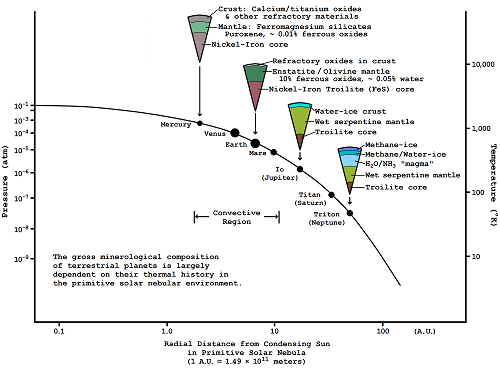 |
The terrestrials form closest to the protosun, where pressures range from 10-5 to 10-4 atm and the temperature climbs from 200 K to well over 1400 K.1564 It is a region of very high convection, so the matter is kept well-stirred. Only small cores with miniscule amounts of nebular gas can accrete. (The extent of this growth restriction is made more clear if we consider stripping the jovians down to their heavy elements. If we did this, we’d find both Jupiter and Saturn with 15-20 Mearth (Earth-masses) of heavies.2091,2096,2098 This is far more than Earth, the most massive terrestrial world in our system.) Total accretion time for terrestrials probably runs on the order of a thousand to a million years.2043,2044
We see that the bulk composition of planets in any single-sun system should follow a quite regular, orderly progression (Figure 5.2). The innermost worlds will consist of the most refractory matter, with the planets at progressively greater distances from the primary consisting of the less refractory materials.22
To sum up:
- We expect that planets lying within or close to the habitable zones of stars will be generally terrestrial in character.
- Far outside the habitable zone at great distance from the sun, jovians and subjovians put in an appearance.
- And no planets will be found closer to a star than perhaps one-quarter of the distance to the center of the habitable zone.
- No substance found in the solar nebula could condense in the extreme heat encountered there.
|
Figure 5.3 Results of Computer Simulations of Planetary Formation1258 |
|
|
Planetary Systems Synthesized by Computer Model 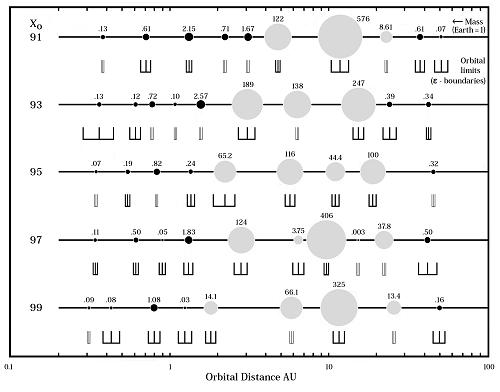
Above are a few examples (among hundreds) of planetary systems synthesized by Stephen Dole’s computer model.
þ Solid, filled-in circles represent terrestrial worlds; |
The fundamental correctness of the accretion model has been tentatively verified by Stephen H. Dole of the Rand Corporation.1258 Dole set up a computer program to simulate the primitive solar system in the process of formation.
Accretion nuclei with random orbits are shot into a nebula surrounding a theoretical protostar of 1 Msun Nuclei aggregate dust in the nebula, assumed to be 2% of the total by mass, until a specified critical mass is reached beyond which gas can be accumulated as well.
The growing planetesimals coalesce if their orbits cross or if they come too close. Nuclei continue to be injected until all dust has been swept from the system. The model is simplistic, to be sure,2037 and yet the results are most intriguing.
Despite the fact that Dole varied the initial conditions considerably, the final products always seemed remarkably similar (Figure 5.3). After each run, the end result was a solar system which looked much like our own.
The total number of worlds formed varied from seven to thirteen, and the Titus-Bode “law”1254,1304 of planetary orbital spacing (so well-known to beginning astronomy students) seemed to hold up approximately in all cases.2054 While every such system is quite unique, the surprising thing is that each shares many features of Sol’s system and yields results consonant with accretive evolutionary theories.
|
Figure 5.4 Computer Synthesis of Multiple-Star Systems1258 |
|
|
Examples of binary and multiple star systems generated by computer model 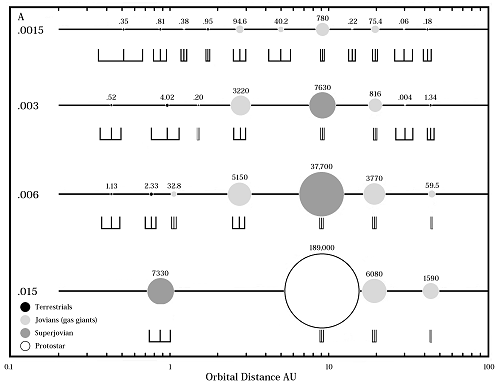
Examples of binary and multiple star systems generated by Stephen Dole's computer model are shown above.
þ Terrestrials are represented as solid circles. |
Dole’s program generated another unexpected result. It has long been suspected that the processes which give rise to binary and multiple star systems may actually preclude the formation of planets.20,1300 In our Galaxy, the average separation of binary components is about 20 AU, corresponding roughly to the orbital distances of the jovian gas giants in our solar system. (Jupiter and Saturn have often been called “failed stars.”2048 In this view, we narrowly missed out on finding ourselves in the middle of a triple star system.)
By increasing the density of the initial protocloud an order of magnitude higher than before, Dole’s program generated larger and larger jovians (Figure 5.4). Eventually the threshold between planetology and astrophysics was crossed. In one high-density run, a class K6 orange dwarf star appears near Saturn’s present orbit, along with two superjovians and a faint red dwarf further sunward. No terrestrials are formed.
As Dole says, the general trend is clear. Jovians multiply at the expense of terrestrials. An increase of one critical parameter — the nebular density — may well result in the generation of binary and multiple star systems to the eventual exclusion of terrestrial worlds.1258
Both theoretical and numerical accretion models of solar system formation suggest that planets are probably the rule rather than the exception, and that terrestrials should form near most single stars in the inner regions of the solar nebula. This augurs well for the abundance of habitable worlds and extraterrestrial life in the Galaxy.
|
Table 5.3 Cosmic Abundance of the Elements (number of atoms)6 |
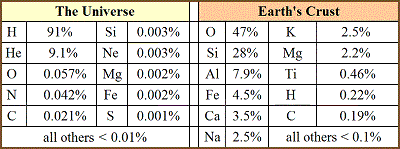 |
| Water - catalyst of life |
Life on Earth is dependent upon the oceans for both its origin and its evolutionary development. The early organic compounds which ultimately gave rise to living organisms were stirred and stewed in the primitive seas — our entire biological character is molded by the properties of water. Indeed, it is difficult for biochemists to imagine that life could have had its origin in any other medium. Complex chemical reactions must have a reasonable chance of occurring. A liquid medium of some kind is required, capable of dissolving salts and other compounds and then commingling them in the degree of intimacy required for the origin of life. While it is certainly more, water in this sense may be viewed as a “catalyst” of life.
But must conditions on other worlds exactly parallel those found on Earth? Is water the only possible fluid in which life may originate? We don’t really know the answer to this question (see Chapter 8). Of interest to us here, however, is whatever light can be shed on the problem by the science of planetology.
| Thalassogen - coined by Asimov |
Isaac Asimov has coined the term “thalassogen,” by which he refers to any substance capable of forming a planetary ocean.1399 Looking for possible thalassogens is somewhat broader than the search for liquids that can sustain life, because some of them may turn out to be anathemic to all conceivable biochemistries. But the planetologists’ quest for thalassogens is certainly an excellent starting point for our inquiry.
What substances are available for ocean-building? There are two characteristics which must be possessed by seas on any planet in our Galaxy. First of all, the very elements comprising the thalassogen molecules must be relatively abundant in the universe (Table 5.3). For instance, the element mercury is a liquid at normal temperatures and so might be considered as a thalassogen. However, its abundance cosmically is only about 0.000000001% of all atoms, which is hardly enough to cover a world the size of Earth to a depth of a millimeter or so.39,1413
|
Thalassogen: Any substance capable of forming a planetary ocean. Molecule/element must be both abundant and Must have a prominent liquid phase under |
How about oceans of dimethyl butanol? The atoms which make up this substance — carbon, hydrogen, and oxygen — are certainly among the most plentiful in the universe. Unfortunately, the compound is subject to numerous degradations by heat and chemical interactions, and is chemically unlikely to be synthesized in oceanic quantities. So dimethyl butanol must remain relatively scarce on planetary surfaces, despite the ubiquity of its constituent elements.
| Two requirements of a Thalassogen |
A molecule must therefore be both abundant and simple to qualify as a thalassogen. Rare elements, and molecules which are horribly complex, have a very low likelihood of being found in the oceanic state.
Apart from availability, there is one further basic requirement: The putative thalassogen must have a prominent liquid phase under the conditions typically encountered on planets. If the environment is such that the molecule has a hard time liquefying at all, clearly it will not be present in pelagic quantities on the surfaces of worlds.
Consider Mars, for example. At the surface of the red planet the atmospheric pressure is only 1% that on Earth.2044 Under such conditions, any carbon dioxide frozen at the poles cannot melt to liquid CO2 upon heating. Quite the contrary, the “dry ice” there sublimes — that is, it passes directly from the solid to the gaseous state. This occurs even at more Earthlike pressures. Above 5.2 atm, though, CO2 is able to melt and form liquid carbon dioxide. Venus, whose atmosphere is mostly CO2 at nearly 100 atm, might have liquid carbon dioxide at its surface were it moved out to a cooler orbit and if the pressure could be maintained above 5.2 atm.
Consider the elemental abundances as noted in Table 5.3 above. Taking the cosmic values first, we see that two of the elements — the noble gases helium (He) and neon (Ne) — can be present in elemental form only. The most abundant atom, hydrogen (H), exists either in chemical combination (terrestrial worlds) or in large quantities in elemental form (as on the jovians). Oxygen (O), nitrogen (N), and sulfur each can achieve liquidity at temperatures that might be expected on planetary surfaces.
The elements silicon (Si), magnesium (Mg), and iron (Fe) unite with others on the list to form sulfides, oxides, nitrides and hydrides. The metal sulfides and oxides are extremely refractory, having melting/decomposing points above 1000 °C. They probably will not exist in liquid form on any normal planet for very long. Nitrides and hydrides of the aforementioned elements all tend to decompose either with elevated temperatures (i.e. before they have a chance to liquefy) or in the presence of water (which is likely to be ubiquitous anywhere in the universe). So none of these substances would make very good thalassogens.
| Chemically hydrogenated |
Compounds comprised of hydrogen, oxygen, nitrogen, carbon and sulfur must also be considered. It has been argued that in a primarily hydrogenous environment, everything will tend to become as chemically hydrogenated as possible.1399 Hence,
- oxygen will become water (H2O)
- nitrogen will go to ammonia (NH3)
- carbon will become methane (CH4)
- sulfur will react to form hydrogen sulfide (H2S)
Many other simple compounds have been discovered, floating naturally in interstellar space, by radio astronomers in the last decade.1002 These substances are observed in vast clouds, and include carbon monoxide (CO), sulfur dioxide (SO2), cyanogen (CN), hydrogen cyanide (HCN) and so forth.521 A full consideration of all interstellar molecules discovered to date, and many other possibilities not yet detected, is unfortunately beyond the scope of this book.
Of course, oceans are not found in space but on planetary surfaces. Therefore, it is also relevant to consider the elemental abundances in the crusts of planets. We look for clues to additional compounds which might be generated by chemical reactions incident to planetary heating and volcanism, and which might be able to serve as thalassogens. From Table 5-1 we find only three elements — oxygen, hydrogen, and carbon — which are useful in this regard. Carbon dioxide (CO2) and water are the most common substances formed from these elements to be found on terrestrial worlds. Other molecules which might arguably arise under various planetary conditions include nitrogen dioxide (NO2) and carbon disulfide (CS2), although there are serious objections to both of these on reaction equilibrium grounds.
|
Table 5.4 Melting/Boiling Points and Liquidity Ranges for Possible Thalassogens at 1 atm Pressure* |
|
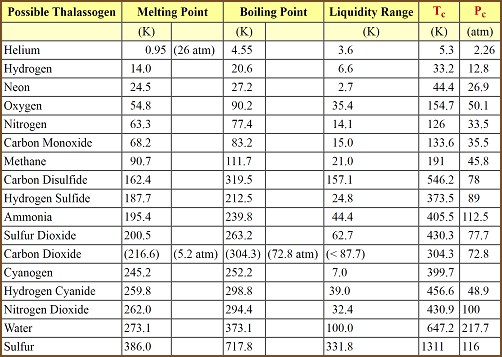
|
| Liquidity |
So much for availability. What about liquidity? Even the coldest planet in our system (Pluto) has a surface temperature of at least 43 K.2037 So the first three possibilities listed in Table 5.4 — helium, hydrogen, and neon — can be ruled out because no reasonable world could be cold enough. But most of the remaining molecules could well be available as oceans on the surfaces of planets at the proper solar distances. (This is a gross oversimplification, of course, because relative abundances should also be taken into account.)
The lower the liquidity range, the faster the world must be spinning to maintain even temperatures. Cyanogen is particularly suspect on these grounds. As a general rule, the larger the range of liquidity the higher the probability of finding a planet whose temperatures fortuitously remain within the appropriate limits.
Xenologists are primarily interested in those thalassogens which might allow life to arise naturally on a planetary surface. We know that water, with its liquidity range of 100 K, has been capable of supporting and sustaining biology. The Hypothesis of Mediocrity allows us to take this as a minimum (or reasonable) value.
Using this standard, we see that water, carbon disulfide and sulfur all have liquidity ranges equal to or greater than 100 K. Another marginal possibility is carbon dioxide, and perhaps sulfur dioxide as well.352 Ammonia is a very long shot.
For a million years, humanity has become accustomed to the shimmering blueness of the open seas. On a world with oceans of CO2, we would feel right at home. Carbon dioxide is a sparkling clear liquid slightly less dense than water. Oceans of it would possess the same evocative rich blueness as the seas of Earth. (Marine sulfur dioxide and ammonia should look similar.)
Carbon disulfide oceans would demand peculiar chemical conditions in the planetary crust to sustain them. CS2 is not believed to have existed in the primary atmospheres of any of the terrestrial worlds in our solar system. Nevertheless, as someone clever has remarked, absence of evidence is not evidence of absence. We’ve seen that the carbon disulfide molecule satisfies the most fundamental requirements of all thalassogens.
Oceans of this foul-smelling, poisonous substance would appear light-yellow in color in the shallower regions near coasts, due to the presence of colloidal sulfur particles. In deeper waters sunlight would begin to add a scattering component, causing a change of color to a peculiar shade of light-green. If there is any ammonia or hydrogen chloride around (even in trace amounts), simple chemical reactions would turn the sea a brilliant crimson.
Oceans of molten sulfur are the most fascinating of all, for they would change both color and viscosity regularly with oscillations in the planetary surface temperature. Between 386 K and about 430 K liquid sulfur is a thin, transparent, pale-yellow fluid. As the temperature increases from 430 K to 470 K, the substance becomes dark red in color and extremely thick and viscous. From 470 K to 500 °K the viscosity falls off but the color darkens from red to black. Above 500 K the sooty color remains, but the sea becomes thin and fast-flowing once again. Pelagic sulfur would make for a most interesting planetary environment indeed!
 |
In the absence of an atmosphere, it is difficult to imagine an ocean of water or any other thalassogen being present on a world. It appears that both liquids and gases are required in the chemical interactions which lead to the origin of life. Discounting the occasional origin of life in the subsurface regime of its crust, a world probably cannot be suitable for living organisms unless it possesses some kind of atmosphere.20
While atmospheres may exist without oceans, oceans may not exist without atmospheres. More factors must be taken into account in assessing a molecule as a possible atmospheric constituent.
- First, it must be reasonably abundant.
- Second, it must be present in either gaseous or vapor form at reasonable planetary temperatures.
- Third, the molecule must be neither so lightweight nor so hot as to have escaped from the world over a period of eons.
- Fourth, effects of planetary surface chemistry become extremely important in the evolution of atmospheres — the presence of large oceans is especially significant.
- Fifth, natural biological modification of the atmosphere must be considered.
As far as abundance is concerned, there are fewer restrictions on composition than when we were talking about thalassogens. While oceans may represent 0.01-0.1% of the total mass of a terrestrial planetary body, an atmosphere will run two or three orders of magnitude less. Consequently, Tables 5.3 and 5.4 are far from complete. Far less abundant molecules, rejected as thalassogens on grounds of scarcity, are welcome as constituents of the air.
Looking at the boiling points (and vapor pressures) of the molecules in Table 5.4, we note that virtually all have a gaseous phase at reasonable temperatures for some planets. (E.g., Pluto may have a neon atmosphere!2064) In view of the liberal temperature and abundance requirements, literally hundreds of molecules may comprise planetary atmospheres in various concentrations and pressures. An exhaustive treatment is clearly beyond the scope of this book.
The third consideration is the escape of molecules from a world by a process known as thermal evaporation. Just as rockets must achieve escape velocity to overcome Earth’s insistent gravitational tug, so must atoms. Gas molecules which are traveling fast enough and are light enough can stream off into space, leaving the planet high and dry. Higher temperature means higher energy which means higher velocity. Also, the lighter a molecule is at any given temperature, the more likely it is to escape because it needs less energy to get away. Light molecules thus leak off faster than heavy ones.
Close to the surface of a world, molecules cannot travel very far before they bump into one another. Even a particle moving at ten times the escape velocity would strike several others before it had traveled one centimeter. It would distribute its energy, slow down, and not escape.
But in the exosphere (as it is called) of a planet, molecules can fly literally kilometers before a collision occurs. Only in the upper atmosphere can gas which is hot enough to escape have a reasonable chance of making it. So it is this exosphere temperature, and not the planetary surface temperature, which is relevant to the escape of atmospheric components. Earth’s exosphere, to use an example, lies at roughly 600 kilometers and varies from about 1500-2000 K.20,214,521
|
||
|
From the abundances listed in Table 5.3 we might expect planets to start out with mostly hydrogen and helium, with less than 2% other elements as impurities. Jovians are massive enough (high escape velocity) and cold enough (low velocity molecules) to hold the concentrations of these two elements to within spitting distance of their primitive solar nebula abundances. On worlds as small and hot as Earth, though, hydrogen escapes in a characteristic time of perhaps 1000 years.20 On still smaller and hotter worlds, like Mercury, the gas is retainable only for a matter of hours. (The characteristic time for hydrogen on Jupiter is estimated to be something like 10200 years.57)
On the other hand, most average-sized terrestrial planets are quite capable of hanging on to carbon dioxide, water, nitrogen and oxygen. (These are also retained by the jovians, but the proportion is vastly smaller because of all the hydrogen and helium around.) Following Dole,214 we may classify all planets into three general categories: Airless, light atmosphere, and heavy atmosphere.
| Atmospheric Constituents |
Airless worlds are those which lie above the molecular weight MW = 100 line on the planetary atmosphere retention graph on Figure 5.5. Mercury,1566 Luna and the asteroids in our solar system have virtually negligible gaseous envelopes. Planets which lie between this line and the MW = 5 line will have atmospheres of small mass relative to the main rocky body. Gases, if present in the first place, will be retained according to their molecular weight and the specific surface conditions they encounter. Finally, planets lying below the MW = 5 line will possess atmospheres which represent a sizeable fraction of the total mass. Such will consist primarily of hydrogen and helium, with trace impurities of methane, ammonia, and so forth (depending on temperature).
Still, we are not yet in a position to predict the atmospheric composition of terrestrial worlds. Venus and Earth, for instance, have roughly the same mass but their atmospheres are vastly different. According to the discussion above, one might have expected the Cytherian air to be less dense than our own because it’s hotter closer to Sol (and so gas should be lost more quickly). Yet the surface pressure on Venus is ~100 atm. Clearly, other forces are at work besides simple selective leakage of gases.
|
Table 5.6. Element Abundances on Earth as Compared to the Primitive Solar Nebula315,521 |
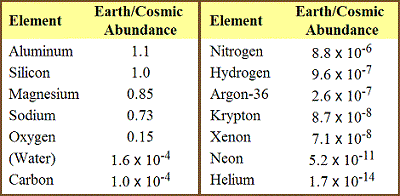 |
Part of the mystery may be cleared up by considering the information contained in Table 5.6. As we expect, there is a large depletion of the lighter elements — hydrogen and helium. But why are other elements so severely dissipated as well? Most peculiarly, why are argon, krypton, and xenon pretty well gone from Earth, despite the fact that the characteristic leakage times for these components should be 1070 years or more?
If we look at what the composition of Earth should be (based on thermal evaporation considerations alone) and then compare it to the actual makeup of our planet, several very striking facts emerge. Most of the solid elements that go into rocks — silicon, aluminum, magnesium, sodium — are present in just the right amounts. Most of the oxygen around was similarly tied up. However, all the gaseous components are depleted by an average of six orders of magnitude! What’s going on?
Planetologists today believe that in primitive times Earth (and the other terrestrials in this system) lost not only H and He due to thermal evaporation but most of the rest of its atmosphere as well.2031 The exact mechanism by which this cosmic dust broom operated is not clear, but it may be connected with the T Tauri gales associated with the early stages of evolution of Sol-like stars. The lack of noble gases is significant because they are the heaviest molecules present in any planetary atmosphere. If even they are gone, it’s virtually certain that all lighter components have also been scoured away.
But then — how do we account for our present atmosphere? If Venus started out as an almost airless globe, where did it manage to find 100 atm worth of carbon dioxide?
The four elements common to all terrestrial environments, C, H, O, and N, are the four least depleted of all the gaseous components. Why is this so? It appears evident that compounds containing these elements were actually incorporated into the early Earth in both solid and gaseous form.33 Later, they were released from their rocky vault to take up new careers as atmosphere and ocean.
When the primitive Earth contracted and began to melt, trapped gases slowly bubbled to the surface.2042 Volcanoes today emit as much as 60% water and 20% CO2 in their eruption products,2031 and molten rock can dissolve perhaps 5% of its weight in water. Scientists suspect that by similar processes, our air and water gradually emerged from the interior of the planet.2031
The early hot crustal material may have had large amounts of free iron, which would have reduced much of the water and carbon dioxide to methane and hydrogen.57 Our secondary atmosphere thus probably began as a chemically reducing environment, rich in effluent H2, CH4, H2O, NH3, and increasing amounts of CO2 and N2.20,57,521,1293,1645
|
Table 5.7. Summary of Terrestrial Planetary Atmospheric Evolution2041,2044 |
 |
We arrive at the fourth important factor relating to planetary atmospheres: Surface chemistry effects. The evolution of the air of a world is closely linked to its mass, temperature, geological activity, and oceans. Most terrestrial planets destined to have light atmospheres (Table 5.7) are expected to have gone through the same processes of outgassing as described above for the Earth — though perhaps at slightly different rates.
|
Figure 5.6 Rasool's Model of Planetary Atmospheric Evolution |
|
|
CO2/H2O Phase Diagram for Terrestrial Planets2065 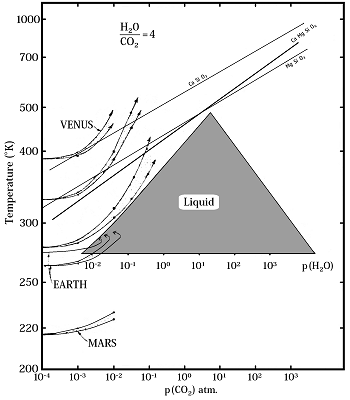
Atmospheric physicist S. I. Rasool assumes that atmospheres of terrestrials are the product of early “degassing” from the molten interiors of the primitive planets. Shown in the diagram at left is the triangular region of pressure and temperature in which water remains a liquid thalassogen (cross-hatched area). Also depicted are the evolutionary tracks of three typical terrestrials in our own solar system. The theoretical development of Venus is illustrated by two curves — one for a non-rotating world (upper curve, marked “VENUS”) and one for a fast-rotating planet (curve starts at 330 K). Tracks for Mars and Earth are also shown, and still another curve depicts the startling conclusion that Earth would have missed the water-liquidity triangle altogether had it started out a mere 5°C hotter, Apparently our lush, verdant planet would have become a close duplicate of hellish Venus were it a mere 6-10 million kilometers closer to Sol.1907 Thermal Evaporation of Planetary Atmospheres2031 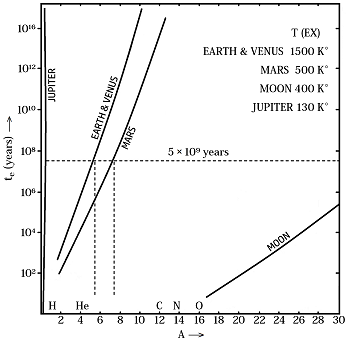
The drawing at right presents the effective escape time for various gaseous components of planetary atmospheres, as a function of atomic (molecular) weight A. Various exosphere temperatures are assumed for each of the planets shown. For a planet to be a terrestrial world capable of evolving advanced lifeforms, its retention curve must lie to the right of helium on the diagram, so that both this gas and hydrogen are lost in one “genesis time” (~5 x 109 years). At the opposite extreme, a planet must be able to retain all other gases for at least one genesis time. The Moon fails to fulfill this requirement by several orders of magnitude. |
Dr. S. Ichtiaque Rasool, Chief Scientist at the Planetary Programs Office of NASA and a specialist in planetary aeronomy, has formulated a fascinating theoretical model (Figure 5.6) for atmospheric evolutionary processes.2065 The model predicts that terrestrial worlds relatively close to their primary (like Venus) will always be too hot for water vapor to condense at the surface into oceans. With no water in pelagic quantities to dissolve it, the CO2 disgorged into the air by volcanoes must remain aloft. A dense atmosphere soon builds up. Temperatures are further elevated by the greenhouse effect*: The carbon dioxide forms a warm blanket over the entire planet, absorbing and reemitting the infrared heat radiated by the illuminated planetary surface. This effect adds only 30 K to the temperature of Earth’s atmosphere, but amounts to a whopping 500 K on Venus!
On such a hot terrestrial world, the water vapor could be split into its component atoms by the ultraviolet rays from Sol. The hydrogen would then be lost to space by thermal evaporation, and the oxygen could combine with the surface rocks and disappear from the air. The carbon dioxide level is partially buffered by chemical reactions with silicate rocks in the crust. These reactions tend to eat up CO2 and produce carbonate rocks, or limestone. Unfortunately, buffer reactions proceed at a reasonable rate only if there is plenty of water around. But as we’ve seen, there won’t be much on a hot terrestrial. The volcanoes can go on dumping carbon dioxide into the atmosphere and the crust can do little to prevent it. This process is commonly known as a “runaway greenhouse.”2037,2065,2066
On a world closer to the center of the habitable zone (like Earth), the chain of events is much different because things are cooler. The atmosphere begins to emerge at the time when the nearly airless surface has a temperature at or near the freezing point of water. As the CO2 comes out and the planet starts to greenhouse, the temperature rises slightly. Water sloshes together in liquid form and becomes ocean. The carbonate-producing buffer reactions begin in earnest, laying down gargantuan deposits of limestone and chalk as the carbon dioxide is removed from the air. The greenhouse does not run away.
We see that the surface temperature of the planet is of critical importance in determining the fate of its atmosphere. Rasool calculates that a change of perhaps 10 K (hotter) would be enough to have caused Earth to miss the liquid phase of water altogether and become a close replica of Venus.2065
The model also predicts what happens to terrestrial worlds in the outlying regions of the habitable zone (like Mars). Here again we have no oceans forming, because any water emitted by volcanoes is frozen out. Carbon dioxide may build up, free from the moderating influence of silicate buffering reactions. (But Mars is a small, cold planet, so degassing from the interior proceeds much slower than for a larger body. A 1 Mearth world at Mars’ orbit should eventually become quite Earthlike, though it will naturally take much more time.)
* Technically this is a misnomer because it’s not the way horticultural greenhouses keep warm. Rather than selective passage of visible (but not infrared) wavelengths, they work simply because a body of air is physically confined and heat cannot escape by convection. In 1908, Dr. Robert W. Wood constructed two greenhouses — one of glass and one with rock salt panes (NaCl passes infrared, unlike glass) — and both worked equally well.
As regards Mars: After perhaps ten eons or so of slow planetary evolution, enough carbon dioxide may accumulate to produce a respectable greenhouse effect. Since the water has not been lost but is merely stored away at the poles, oceans could develop when the temperature manages to rise above 273 K — the freezing point of H2O. In this view, Mars has never had oceans and is in an earlier stage of evolution than Earth. (There are some who would disagree with this conclusion, arguing from the riverbed-like structures observed on the Martian surface by Mariner 9 and Viking.15,2044,2074)
So the story of the gross atmospheric conditions is largely the story of water and carbon dioxide. But what about the other components of the air? Well, much of the hydrogen is lost to space by thermal evaporation from the exosphere. Nitrogen is released by volcanism and is relatively inert — it remains in the air relatively unchanged. The ammonia dissolves in the water, if there is any, or dissociates into hydrogen and nitrogen. Methane undergoes organic reactions, again, if there is an ocean. And oxygen is produced when water is split apart in the exosphere by ultraviolet radiation. O2 can reach natural concentrations of perhaps 0.1% of the air. For example, Ganymede and Callisto are believed to have thin oxygen atmospheres (~10-3 atm), which could have arisen as fast as ten thousand years in this fashion.2095
|
Figure 5.7 Biological Modulation of Planetary Atmospheres1293 |
|
|
Figure 5.7a Atmosphere of a Lifeless Earth 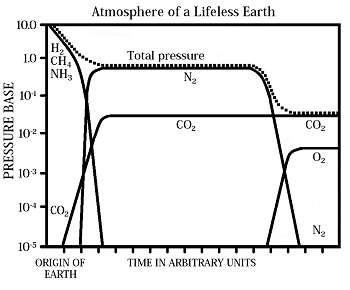
This model of the Earth with no life from the start is not unlike what would be expected from interpolation to conditions lying midway between Venus and Mars.
The surface pressure is still about 1 atm, but the air is perhaps 97% nitrogen and a few percent carbon dioxide.
Figure 5.7b Atmosphere with Life Present 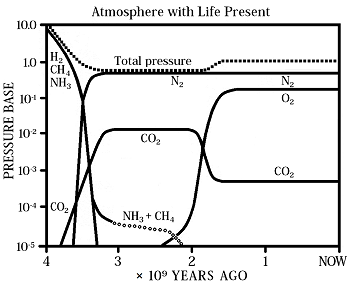
The effects of adding life to a planet’s geophysical history are striking when biological modulation of the atmosphere takes place.
While the air is still mostly nitrogen, autotrophic living organisms convert perhaps 95% of the available carbon dioxide into biomass-carbon and free oxygen — which is then utilized by animal life.
|
Production of oxygen is a good example of what is called a “self-limiting” process. As the concentration of O2 rises, a thin ozone (O3) shield begins to form which screens out the UV rays from the water vapor below. As ozone increases, less H2 is dissociated and less free oxygen is produced.
It seems that natural mechanisms may be able to change a reducing (hydrogenating) atmosphere into a more neutral one, but apparently simple chemistry alone is incapable of creating an oxidizing atmosphere.96 Earth is the only planet in the solar system that is oxidizing. Why?
| Biological modification of the atmosphere |
The answer is found in the biological modification of the air — our fifth important factor It appears that until perhaps two eons ago, the carbon dioxide in Earth’s air (say, 1%) kept the surface temperature well greenhoused to warmer levels. As the blue-green algae began to work their photosynthetic magic in our oceans, they took over from the silicate rock and carbonate buffer chemistry in the removal of CO2. After only about 500 million years, Earth’s atmosphere changed from 0.1% O2 to about 20% O2. This effectively removed about an order of magnitude of carbon dioxide from the air, reducing its concentration down to about 0.1% of the total. Instead of limestone formations, carbon began to be incorporated as biomass (Figure 5.7).
The presence of an oxidizing atmosphere is probably a good test for biology.* We know that Earth’s crust is rather underoxidized and would eat up most of the abundant O2 in our air in a relatively short time. As Carl Sagan has pointed out, “a high level of oxygen such as we have in the Earth’s atmosphere can only be accounted for by vigorous biological activity.”445 (The photosynthetic recycling time for the O2 in our atmosphere is roughly 2000 years.1945)
But scientists today argue that more than just oxygen levels are controlled by terrestrial biota. Dr. Lynn Margulis of the Boston University Department of Biology and Dr. J. E. Lovelock, an applied physicist at the University of Reading in England, believe the Earth is a complex “entity” which could almost be described as living. They present evidence that biology not only modifies our environment but modulates it as well.1293
That is, the conditions in Earth’s oceans, atmosphere, lithosphere and biosphere are all regulated by life on the surface in such a way as to maximize the growth of the biosphere. It gives one pause to consider that those same forces of natural selection responsible for the diversity, abundance, and efficacy of lifeforms on this world are also operative on the biospheric, global scale. As species evolve over time, so do complex feedback mechanisms seek and preserve planetary homeostasis — the optimum physical and chemical environment for life on Earth.
* Life is quite possible (and in fact originated) in fully reducing atmospheres. However, advanced forms of life need far more energy. Hence, they appear less likely to arise in hydrogenous environments because their metabolisms would seem to be less energy-efficient.
|
Table 5.8 Exotic Biological Modulation Schemes: Theoretical Atmosphere/ Thalassogen Biochemical Energy Systems, Neglecting Abundance Problems (after Asimov1358) |
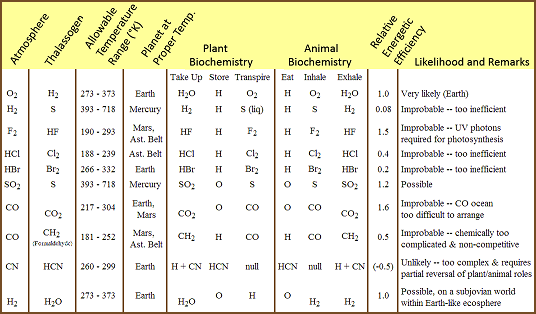 |
Let us now attempt a brief summary of our conclusions regarding terrestrial planet atmospheres generally. First, abundance and gaseous state requirements are so loose that it is difficult to exclude virtually any reasonable candidate molecule on these grounds alone. As far as thermal evaporation is concerned, a planet in the habitable zone with a mass greater than perhaps 0.1 Mearth should be able to hang onto any gas already present (other than hydrogen or helium) for geological time periods.
It appears that the typical terrestrial without oceans is most likely to carry an atmosphere consisting of more than 95% carbon dioxide through out much of its evolutionary history. Planets with oceans of liquid water should develop an equivalent predominance of nitrogen in the air, because the CO2 is returned to the crust via silicate buffer reactions. (There are no precedents in our system for nonaqueous terrestrial oceans, and unfortunately the chemical surface processes have not yet been worked out in detail for alternative thalassogens.)
We see that the total surface pressures may range from less than 0.01 atm to more than 100 atm, depending primarily upon the rate of outgassing of the secondary atmosphere from the interior of the planet. Larger, more massive worlds should tend to outgas faster and build up thicker air, as a general rule.
Finally, if life is present, thermodynamically unstable components may appear in the atmosphere — such as oxygen on Earth. Of course, any other chemically active gaseous oxidant may equally well be found, depending on the particular modulating biochemistry of the life on the planet’s surface (Table 5.8).
 So far we have confined ourselves to an examination of the gross, bulk properties of planets, oceans and atmospheres. But xenologists are also very much interested in somewhat “smaller scale” phenomena. What kinds of climate and weather will the aliens have? Will their world know lazy clouds, blue skies and shimmering auroras? Are their mountains tall or short (e.g., "astrogeology"2144), and how fierce are their storms and quakes? What color is their sun?
So far we have confined ourselves to an examination of the gross, bulk properties of planets, oceans and atmospheres. But xenologists are also very much interested in somewhat “smaller scale” phenomena. What kinds of climate and weather will the aliens have? Will their world know lazy clouds, blue skies and shimmering auroras? Are their mountains tall or short (e.g., "astrogeology"2144), and how fierce are their storms and quakes? What color is their sun?
The answers to such questions, and many others like them, are extremely hard to come by in a definitive way because the causative dements are so complex and variable. Yet they are of vital importance if we hope to comprehend alien art and culture, languages, architectural forms and lifestyles, and even ET social patterns and individual psychologies.
|
Table 5.9 Wind Speed and Planetary Surface Conditions for Terrestrial Planets1566,2066,2087 |
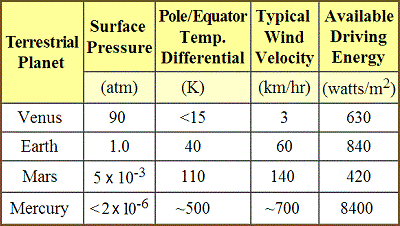 |
We’ve already hinted at the effects of evolutionary history on a planet’s surface temperature. What else can be said about the overall climate? First of all, the thinner the atmosphere the greater will be the diurnal variations in temperature. This is because a dense, massive atmosphere has more ”thermal inertia.” Since huge amounts of heat are stored, a brief nighttime cooling-off period has very little effect. But if the air is thin and lightweight (as on Mars), very little heat is reposited. Thus, on the night side the surface and the air above it cool rapidly, leading to large swings in temperature between the two sides of the planet. This results in faster-moving winds (Table 5.9), but because the air is less dense the energy available is actually less.
Perhaps one of the most decisive factors in planetary meteorology is the rotation rate of the planet. On a planet such as Venus, where a single “day” lasts months, surface winds are believed to be no more than a few kilometers per hour, maximum.1257,2041 On worlds with intermediate rotation rates like Earth and Mars, typical wind speeds range around 50-70 km/hour.1257,2067 Fast-spinning bodies like Jupiter are known to have winds averaging 140-290 km/hour and higher near the equator.1141,1257,2045 Naturally, faster rotation and stronger winds means larger Coriolis forces, along with more violent cyclonic disturbances such as tornadoes, hurricanes, typhoons and water-spouts. Also, slow worlds tend to have greater day/night thermal differentials than faster ones because the air is not as well stirred, Surface temperatures are less uniform as a result.214
The heat capacity of the molecules in the atmosphere is also important. This may be thought of as the amount of energy which must be added to a unit of air to raise its temperature a fixed amount. It can also be conceptualized in terms of energy loss: How much heat must be lost to drop the atmospheric temperature one degree?
An atmosphere like Earth’s in every respect but comprised of hydrogen would have nearly fifteen times the heat capacity of normal air. It would thus take fifteen tithes longer to heat up or cool down, so surface temperatures on a hydrogen-atmosphere planet should be pretty much the same every where.1257 There would be little if any “climate” as we know it on such a terrestrial.1257
The presence of oceans affects the climate in many ways. Largely pelagic worlds should experience smaller variations in surface temperature because the water acts as a giant thermal buffer.286 On dry worlds, the climate is likely to be more “continental,” or desert-like.214 With no seas, meteorology becomes more volatile — weather changes more rapidly.
Many other factors are important too. The winds are driven by the energy supplied fun a planet’s star. Worlds near the inside edge of the habitable zone should therefore have more violent weather, because more energy is available. Unfortunately, life is more complicated than this because of the vagaries of atmospheric evolution, albedo differences, and the problem of self-heating planets (like Jupiter and Saturn).
Another factor which is extremely complicated is the effect of planetary mass and surface gravity on wind and air pressure patterns. If Dole’s empirical relation between mass and angular momentum holds up,* then it is a fair guess that worlds with high mass will have higher velocity winds, in general. And there are other, more subtle problems. For instance, the winds on Mars often blow at more than half the local speed of sound. One wonders what a “transsonic meteorology” might be like.2037
* Using our own solar system as his source of data, Dole finds that angular velocity is directly proportional to the square root of planetary mass for planets which are not tidally braked or locked.214
|
Figure 5.8 Different Patterns of Cyclonic Meteorology |
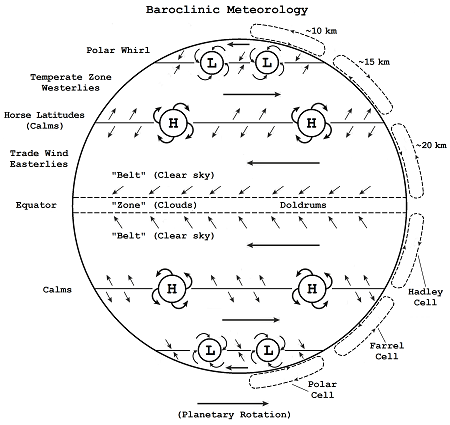 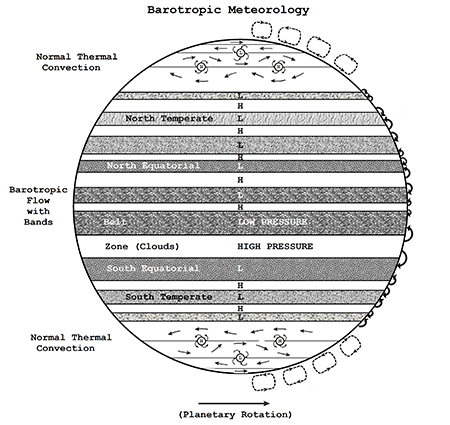 |
Some insight into comparative meteorology can perhaps be gained by looking at the peculiar manifestations of weather on other planets in the solar system. Mars has global-scale storms the likes of which have never been seen on Earth. Most every Martian year, dust storms enshroud the entire world in a dull-ochre blanket for months on end. Winds exceed 320 km/hr during this time — far in excess of most Earthly hurricanes. Yet Mars has roughly the same rotation rate as our planet, is colder and farther from Sol, and has a thinner and less massive atmosphere. How can such a magnificent storm develop?
A small, natural cyclonic disturbance is where it all begins (Figure 5.8). Airborne particles absorb more sunlight and heat up the surrounding gas; outside of this local turbulence the air is cooler. The temperature differential causes major winds to begin to circulate. While hurricanes on Earth are caused by water vapor condensation near the eye, Martian hurricanes get their energy directly from the sun.2044
Earth has a relatively massive atmosphere with large thermal inertia, so temperature changes occur only very slowly. Our planet thus has a long “response time” to change. Not so on Mars. The Martian air responds to changes in temperature in a matter of hours, because its thermal inertia is low. Winds can build up much faster.
The cyclonic disturbance grows larger and the winds go higher still. One planetologist has estimated that once the turbulence extends about ten kilometers vertically and perhaps 50-90 kilometers horizontally, the storm cannot be stopped,1313A kind of “runaway weather,” the Martian hurricane continues to grow until it virtually covers the globe. At this point, the thermal gradient which drives the winds lessens and finally disappears, and the storm soon begins to taper off.*
Science fiction writer Arthur C. Clarke has considered an unusual form of weather that might exist on cold terrestrials (like Titan), which are thought to possess large amounts of solid ammonia and gaseous methane. We know that the smaller the liquidity range of a thalassogen, the more volatile will be the meteorology. Sudden weather changes should be commonplace. As an example, liquid methane may be present in small pools on Titan in local cold spots on the surface. Because it has such a narrow liquidity range, the methane could abruptly flash into steam at the first gust of warmer air or if there is a momentary break in the clouds. The high winds thus generated, Clarke suggests, might be called “methane monsoons.”1947
Another hard science fictioneer, Hal Clement, has written of the peculiar behavior of weather on planets with very high surface pressures. Gases — and air — are generally at least a thousand times less dense than liquids. But what if we have an atmosphere with a base pressure from 100-1000 times Earth-normal? The air will take on liquid-like densities, becoming thick and viscous.1936
What can we say about the presence of frozen thalassogen on the planetary surface? It is well-known that for the greater part of its history, Earth was without polar icecaps. We have them now only because we are in the middle of an Ice Age. Ice Ages are believed by some to occur cyclically every 200 million years or so, triggered by small changes in Sol’s output or by orbital and rotational resonances.2068,3678
(Of course, icecaps need not form only at the poles. A tidally-locked, one-face planet might have a single icecap on the night side only. Or, peculiar resonances between planetary rotation rate and orbital eccentricity could give rise to icecaps located on either side of the equator — although this remains a strictly speculative possibility.2070)
Will all planets with open oceans have icebergs? The answer to this deceptively simple question actually has deep climatic significance. We know that the present climate of our world is in a state of very delicate balance. Surface conditions are largely dictated by the overall energy balance. The greenhouse effect acts to hold heat in and trap energy; Earth’s shiny polar caps tend toward the opposite extreme, reflecting energy back into space and cooling the planet.
* Because the Martian atmosphere is only 1% as dense as that of Earth, the wind packs only about 10% as much punch, An astronaut standing in a 320 km/hour gale on the surface of the red planet would feel the equivalent of a 32 km/hour wind on Earth.1313
Baroclinic flow:
- Climate powered by large temperature differential between equator and poles (ΔT > 10-100°C).
- Vertical pressure gradient minimal.
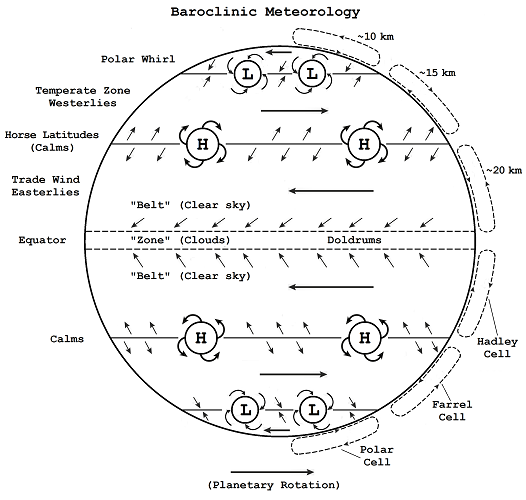 |
Characteristic of:
- Planets with low pressures.
- Planets with slower rotation.
- Planets with negligible internal heating, or which are heated from above (e.g. an optically thick atmosphere).
- Planets whose atmospheric constituents have relatively low heat capacity (e.g. O2, N2).
- Planets having a solid surface.
CALMS are regions of “Coriolis pileup.” unstable with little wind, source of cyclonic disturbances (hurricanes). Cold, dry air falls, removes low altitude moisture, creating most of world’s deserts.
DOLDRUMS — moist, warm, rising air causes cloud cover “zone” at Equator ± 10° latitude.
PRESSURE REGIONS (low and high) form into localized eddies and whorls.
FEATURES persist for weeks (Earth) or for months (Mars).
Typical examples in our solar system:
- EARTH, MARS (especially in Martian autumn and spring)
- VENUS (single Hadley cell, “symmetric” regime circulation)
Barotropic Flow:
- Climate powered by vertical pressure gradient forces.
- Temperature differential between equator and pole minimal (ΔT < 5°C).
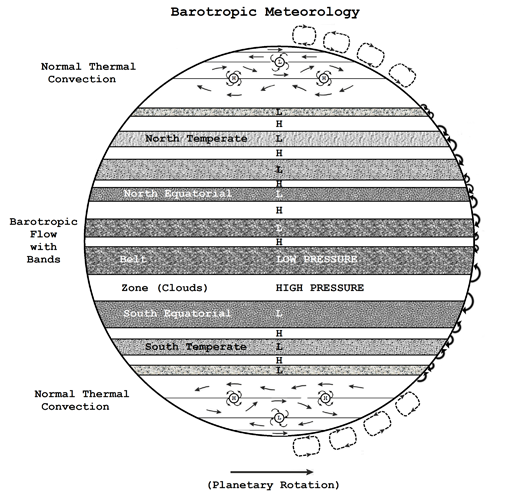 |
Characteristic of:
- Planets with high pressures.
- Planets with fast rotation.
- Planets with significant internal heating.
- Planets whose atmospheric constituents have relatively large heat capacity (e.g. H2, He).
- Planets with no solid surface.
ZONES contain moist, warm, rising air.
BELTS contain dry, cool, falling air.
WINDS flow around planet at zone/belt boundaries.
Low and high PRESSURE REGIONS girdle planet in a series of concentric zonal systems.
Atmospheric FEATURES can persist for centuries because there is no solid surface below the weather, and therefore any real frictional drag.
Typical example in our solar system:
- JUPITER
- SATURN
Icebergs are floating chunks of frozen thalassogen. This proves to be a destabilizing factor in Earth’s climate, because ice reflects energy away far better than the liquid water of the oceans. If there is a prolonged, unusually cold spell planetwide and abnormally great: amounts of ice are produced, more of Sol’s life-giving warmth is cast away by the highly reflective ice floating on the surface. Our planet cools because less heat is available. The icecaps spread, and Earth cools still further. The effect is the exact opposite of the runaway greenhouse discussed earlier, and might properly be termed “runaway icecaps” — an Ice Age.
On the other hand, if the solid form of the thalassogen is less reflective (i.e. darker) than the liquid, the climate should be relatively stable. Any ice formed during a sudden cold snap must subsequently absorb more energy than the surrounding liquid — and soon melt. Icecaps would be unlikely, Ice Ages practically impossible.
Similarly, if a thalassogen cannot form floating icebergs, then even if the ice is highly reflective it still will submerge below the surface of the liquid before it can give rise to thermal instability and runaway icecaps. That is, it moves itself out of the way before it can do much damage. Of course, one man’s bread is another’s poison. The lack of icebergs may promote a more stable climate, but it will also make biology much less likely.
If there are no icebergs, and frozen thalassogen sinks to the ocean bottom because it’s denser, then the sea may freeze from the bottom up and thaw only from the top down. Over the normal range of temperature variations, it is entirely possible that the whole body of liquid could freeze solid for various lengths of time. This is xenologically significant, as the viability of life in such an inimical environment must necessarily be greatly decreased.47,1551
| Water is virtually unique |
Water is virtually unique in this respect: The frozen form, water-ice, floats atop the liquid form. Water expands slightly when it freezes, so the ice is less dense than the fluid. (Only elemental bismuth metal and a very few other rare substances display this behavior.) Hence, where water is the thalassogen, bergs will float and life is not precluded by the threat of a planetwide oceanic freezeup during cold spells.974 (The price paid for this advantage is climatic instability — it would appear that Ice Ages are possible only if water is the thalassogen.)
|
Table 5.10 Densities of Some Thalassogens of Interest2062,2063,2069 |
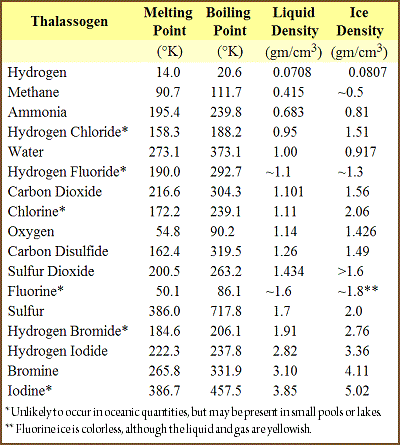 |
Not so with all other thalassogens of interest. As we see from Table 5.10, no other single thalassogen has the unique property of floating iceberg production. Even if we allow for a dual thalassogen system, say of ammonia and methane,1947 it is rather difficult to arrange for icebergs or floes of solid ice. Ammonia-ice not only sinks in liquid ammonia, but in liquid methane as well.*
But there are a few possibilities. Water icebergs should float on oceans of liquid oxygen, as should methane and ammonia bergs. Water-ice will also float on carbon dioxide seas at the right pressures. But sulfur, hydrogen, carbon dioxide and oxygen floes are probably out of the question on any kind of reasonable plet.
Many other specific meteorological phenomena are also of major interest to xenologists. For instance, clouds and fogs should be common in any atmosphere with reasonable pressures. Condensation nuclei will always be plentiful, and most thalassogens can condense to tiny droplets around them at moderate temperatures. Rain should likewise be a regular occurrence at the surface of worlds possessing large open bodies of liquid thalassogen. (Of course, other things may rain down — such as the periodic volcanic ash “rains” in Iceland.)
The height at which clouds form is a function of humidity, thalassogen vapor pressure, atmospheric thermal lapse rate, and a score of other interrelated factors. The suggestion that more massive worlds with higher gravity must have lower-hanging clouds2075 is simply too facile to be of much use to us.
Any planet which has clouds, rain, and sunlight reaching the surface will also have rainbows from time to time. These beautiful spectral arcs are the result of thalassogen droplets suspended in the air, acting as tiny prisms in concert to separate the incoming light into its constituent colors. The larger the droplets, the more intensely vivid the bow will appear.2149
Ignoring for the moment many other important factors, a larger planet with higher surface gravity will pull raindrops down before they have a chance to grow very large. Rainbows on larger worlds should tend to be rather dim, unimpressive affairs. On smaller worlds, where droplets can grow to larger sizes because they fall more slowly, rainbows should be impressive riots of color.2059 Furthermore, if there happens to be a very bright moon overhead or more than one sun; bows might appear in several parts of the sky at the same time.2059
* It should be noted that there are some six different allotropic forms of water-ice which form at various temperatures and pressures. Only one of these — ”natural ice” or ice I as the chemists call it — is lighter than water. Ice II through ice VII all sink if placed on the liquid.
 |
How about lightning discharges? Electrical storms occur because molecules are split apart in the upper atmosphere to ions, which are then carried to the ground by dust and rain. This charges up the planet to at least half a million volts from ground to top of atmosphere — a process likely on any world, save for the exact details of scale height and voltage. Planets with regular and intense sand or dust storms may generate intense electrical fields that could lead to more severe or more frequent discharges.1232
Another important factor is the breakdown voltage of the air — the voltage at which a spark will jump a gap of unit distance. A charged cloud may be 100 million volts higher than the surface below, which is high enough for the “spark” to leap to earth. The spark gap voltage for dry air (at 1 atm) is usually listed as 11,000 volts/cm, and can be corrected for variations in temperature, pressure, and humidity. Now, if the atmosphere was comprised of a more conductive gas, such as neon, the spark gap voltage would only be 800 volts/cm (at 1 atm). This means that lightning should occur more frequently in neon (hydrogen, helium, etc.) than in oxygen (nitrogen, halogens, etc.).
This prediction may perhaps claim some support from the radio observations of Jupiter in the last decade or so. Decameter radio wave outbursts lasting from seconds to hours have been detected, with an equivalent energy of trillions of terrestrial lightning strokes per event.609 Similar outbursts have been observed on Saturn.2097
| Auroral displays |
Will alien worlds have auroras too? Probably. These displays appear at the north and south planetary magnetic poles, and are caused by the funneling of solar wind ions in the converging magnetic field of the planet. Rapidly rotating, massive worlds should tend to have stronger magnetic fields. Also, hotter stars most likely have more vigorous solar winds. We would guess that a 4 Mearth planet with a ten-hour day circling an F5 sun will probably have far more striking auroral displays than a tidally-locked 0.4 Mearth planet orbiting a K2 star.
Mirage physics is also rather interesting. On Earth, mirages often result when there is a layer of warm air lying close to the ground. This air, being hotter, is less dense. It acts as a giant lens. Light coming from the sky near the horizon swoops down close to the ground and is refracted back up.2073 The mirage of water on an open highway is just a smeared-out image of blue sky.
Mirages on Earth generally appear about 100 meters away from the observer at ground level. On Mars, where the atmosphere is so thin the air is hardly heated by the ground at all, the refraction layer is thinner.950 The mirage backs away, out to about one kilometer. (To date, no Martian mirages have been photographed by the Viking landers, possibly due to the extreme roughness of the terrain and because the camera horizon is too close.2094)
On planets with very high density air, as on Venus, the mirage concept literally takes on new meaning. The transfer of heat from ground to near-surface air is complete, and it is believed by many that the extreme refraction near the ground will cause a kind of “fishbowl effect.”15,2060 The horizon would appear above the observer at all times,* appearing to bend upward at the sides.2034 (The idea has already been used in science fiction.2071)
Dr. Conway Snyder at the Jet Propulsion Laboratory in Pasadena, California has performed a numerical simulation of the light-bending phenomenon at the Cytherian surface.2066 Let us imagine with him, for a moment, that we are aliens on the surface of Venus. Our eyeballs can see into the microwave region of the spectrum as well as the visible. What do we see?
The horizon appears to be elevated upward, all around us, at 9.4° from the horizontal. (Only 5°, if visibility drops to 200 kilometers.) Since Venus rotates backwards, the sun rises in the west and sets in the east, creeping across the sky at an imperceptible eight minutes of arc per hour. We are standing at the equator at the time of the equinox, so Sol lies directly over head at noon, Cytherian daylight time.
As the sun slowly falls toward the horizon, its shape begins to change. Its vertical dimension commences to shrink, while the horizontal component remains unchanged. At 6 PM Cytherian time, Sol should just be setting — but it isn’t. Instead, it lies 10.4° up, but is squashed down to a quarter of its normal size. By 7 PM the squashing has become 250:1 compared with the horizontal dimension, and by 8 PM, 30,000:1.
Sometime close to 12 PM, the tiny solar sliver suddenly increases in length dramatically, and at the stroke of midnight wraps itself around the horizon in a pencil-thin ring of light. The line then breaks in the east, the sun begins to reassemble itself in the west, and sunrise begins.
If we are more than 3/8° away from the solar latitude, however, the ring of light will not appear. Instead, we see the compressed sun-image “crawl like a worm across the horizon during the night, from the point where it has set to the place where it is planning to rise.”2086
* Calculations indicate the effect would be rather small, though, perhaps a few degrees inclination at most.2068 The first pictures back from the two Russian Venera spacecraft that landed on Venus in 1975 showed no evidence of the fish bowl,2034,2079 but since the maximum range in the photos was only a few hundred meters the issue remains unresolved.
|
What about the color of alien skies? Must they always be blue?2059 Of course, ETs will probably have different physiological seeing equipment than ours, but we shall permit ourselves the minor anthropocentric convenience of viewing their world through human eyes.
Light that reaches our eyes from the sky is merely sunlight scattered by the atmosphere. Had the Earth no air, our sky would appear quite black. This explains where the light comes from, but not why it is blue.
In 1899, a famous Englishman by the name of Lord Rayleigh devised an explanation for the color of the sky (Figure 5.9). According to his mathematical theory, scattering from very small particles (such as air molecules) increases as the fourth power of wavelength.1995 This means that blue light, which has a very small wavelength, is highly scattered, while red light, with a relatively long wavelength, is scattered much less — sixteen times less, in fact.1990,1991 So the blue light is preferentially removed from sunbeams and spread out uniformly from horizon to horizon. A little red is also present, and some yellow and green too, but blue is clearly predominant.
| Scattering theory |
We can correct the Rayleigh theory for differences in planetary surface pressure and temperature. It turns out that the amount of light scattered is directly proportional to the atmospheric pressure, and inversely proportional to the temperature.1994 So if we double the pressure we double the amount of light scattered in all colors — and the sky gets brighter generally. Doubling the temperature has the opposite effect: the intensity of scattering is cut in half. On the surface of a high pressure planet like Venus, the effect would be rather extreme. All colors would be so strongly scattered that the sky be comes a dim, featureless white.2059
In a perfectly clear, Earthlike atmosphere, the sky would be a rich blue hue. But we observe it to be a hazy, lighter blue. Why?
The Rayleigh theory applies only to particles which are much smaller than the wavelength of light, say, less than 10-100 Angstroms.1994 If the scatterers in the air are much larger than this (as with dust in the atmosphere), Rayleigh’s formulation breaks down and the vastly more complicated Mie theory must be used1995 — the details of which are beyond the scope of this book.
Rayleigh’s theory tells us that particles smaller than about 0.1 micron will preferentially scatter blue light. The Mie theory explains the behavior of atmospheres containing particles larger than about 4 microns. Above this critical size all frequencies of light are equally scattered, and the result is a gray or white sky. (Since there is always plenty of particulate matter, water haze and industrial pollutants floating around in the air — perhaps 100-1000 kg over each square kilometer — the sky’s sharp natural blueness is washed out unless we move to higher altitudes.)
Between 0.1 and 4 microns, the Mie theory becomes especially complex.1995 The selection by color oscillates, sometimes preferring to scatter more blue and sometimes more red.1993,1995 This effect is extremely sensitive to particle size. A uniform haze of 0.4 micron particles would scatter more blue (blue sky), but a similar cloud of 0.6 micron particles would produce more red (red sky).1993,1994
If this is true, why don’t we commonly see such vivid colors in natural Earthly hazes and fogs? The reason is the natural fogs and mists contain a mixture of all sizes of particles, from one to ten microns or larger.1995 As a result, these interesting color effects are added together randomly and average themselves out to a bland whiteness — which we do observe. If some reasonable mechanism could be proposed to get particles of a single, specific size into the atmosphere (i.e., a “monodispersion”); quite beautiful red and blue sky colors would be possible.
Barring this fascinating alternative, as particles of increasing size are added to a “Rayleigh atmosphere” the sky color will appear to change from dark blue to powdered blue, to whitish blue, and finally to grayish white.
A third factor affects sky color besides Rayleigh and Mie scattering. The color of the particles themselves is very important. A red particle, for instance, absorbs all light but red — which it reflects. Thus, it appears red in color. A green particle tend: to absorb blue and red but reflect green. (Under red or blue light such a particle would look black, but in green light it looks green.) So an atmosphere heavily laden with, say, green dust particles should also take on a distinct greenish hue.
We are now in a position to understand why the sky of Mars is red.1989,2035 We add up the contributions from three effects: (1) Rayleigh scattering should give blue sky light, but will only be about 1% of its intensity on Earth because the Martian air pressure is only 0.01 atm;2035 (2) Dust motes an estimated two microns in diameter1989 should produce a bright haze without color by Mie scattering; and (3) Particles in the Martian atmosphere are reddish surface dust, which reflect red light while preferentially absorbing blue and green. Hence, the sky of Mars is unusually bright, and appears a hazy “salmon pink” or “orange cream”1989 (“embarrassed brick”?2035). It is clear that many other sky colors are similarly possible, provided a planet can be found with fine surface dust of the desired color.
| Examples of non-blue skies |
There are other ways to get non-blue skies. For instance, we have discussed the process of frequency-selective light absorption by dust particles. Molecules of gas exhibit this property too.619,620 The sky would no longer be blue under a fluorine atmosphere, to take one example. This gas absorbs blue strongly, and appears pale yellow in color. The sky would take on this color.
Chlorine air should appear green, because it absorbs light preferentially at the blue and orange-red ends of the spectrum. Similarly, an atmosphere of nitrogen dioxide would provide an orange-brown sky. If sulfur vapor is available, the air would alter color dramatically with large temperature changes. Near the boiling point at 720 K the sulfur sky would be dark yellow; as the temperature climbed to 770 K the atmosphere would turn a deep red, returning to straw yellow at about 1120 K.
The problem with using gases such as these is that they absorb light too darned well! At one atm pressure, a few meters of pure chlorine gas would transmit no visible light.2059 This is because even though blue and red are removed preferentially, some green is also eliminated. The sulfur vapor fares no better, sadly. At 1 atm pressure, blue light is cut to below human eye visibility in less than half a meter, and the red is gone in fifty meters.
So if the partial pressures of any of the aforementioned gaseous absorbers exceeds perhaps 0.001-0.01 atm, no light of any color will be able to reach the surface of the planet from the outside. Any inhabitants there must find their way around without the assistance of eyeballs.
If we want to use gaseous absorbers, it is better to choose weak absorbers instead of strong ones. For instance, under a deep ozone atmosphere the sky would probably appear reddish, because the gas is known to slightly absorb blue, yellow, and green sunlight rather well. Methane and ammonia, weak absorbers as they are, would provide a lovely blue-green sky (because absorption is mainly in the red) assuming the atmosphere was thick enough.2059
| Blackbody radiation |
If the temperature at the surface is sufficiently high, another factor must be taken into account: blackbody radiation. Just as a stove’s heating element glows red when it is hot, so will the surface of a fried world like Venus. On Venus, red light emitted by the hot rocks could be orders of magnitude brighter than terrestrial moonlight — about like Earth on a dark, rainy day. In the blue the intensity would be about 100,000 times less than in the red, roughly 10% as bright as moonlight. Since red clearly predominates, reflections off the cloud base will give the appearance of a red sky, assuming fair or good visibility.
Still another trick to get colorful skies is to arrange for permanent colored cloud covers. Arthur Clarke suggests in Imperial Earth that the skies of Titan may be white with beautiful orange and red streaks and whorls, because of the presence of hydrocarbons and other organics in the atmosphere.1947 This is similar to what is believed to impart coloration both to the orange bands and the Red Spot of Jupiter. Unfortunately, 20th-century humans are unlikely to find photochemical smog a very attractive method of obtaining unusual sky colors.
| Other aesthetic possibilities |
More aesthetically appealing are the possibilities of continuous luminescence, phosphorescence, and fluorescence as an adjunct to sky color phenomena.1991 But perhaps the most intriguing of all is the striking sunset effect called the “green flash,” which occurs just after the sun has dropped below the horizon.1992 The red and yellow light is not refracted enough to reach the observer at this point, and the blue has all been scattered away. This leaves only green, which is experienced as a brilliant flash during optimal viewing conditions.2059
But flashes on other planets could appear vastly different. Even on Earth, blue and violet flashes have been seen at higher altitudes.1992 On low-pressure worlds, where blue is scattered less (as on Mars), blue flashes may be the rule. the planet's rotation is slow enough, the “flash” could become a “glow,” lasting for seconds or even minutes.
|
Table 5.11 Rayleigh Molecular Scattering in Planetary Atmospheres as a Function of Stellar Class |
 |
It might be supposed that by changing stars one might be able to affect the color of the sky. After all, sky light is just scattered sunlight, and a class K sun puts out a lot more red than a class F star. However, as we see in Table 5.11, the consequences of illuminating an Earthlike atmosphere under the light of different stars are not great. Blue will predominate in the Rayleigh sky color, even if light from the coolest, reddest class M sun is used. On the other hand, we note that a terrestrial planet circling an F5 star will have skies of much deeper blue than a world associated with, say, a K2 sun. Stellar class is at best a very fine adjustment to sky color, in capable of countermanding the dictates of the atmosphere.
What about the appearance of the primary itself, as viewed from the planet’s surface? If the planet is in orbit around an orange or red star, the sun would seem bigger and redder than Sol does in our sky. Colors at the surface, illuminated by sunlight, would appear slightly different — the blues darker and the reds brighter. Shadows would have blurrier outlines than those on Earth. But an F5 star might cast sharper shadows, with a slight bluish tinge.877
As far as color is concerned, if the observers are beneath an atmosphere which either scatters the blue (blue sky) or absorbs blue preferentially (red sky), then light from the star will lose blueness and appear redder.1991 This effect is most striking at sunset on Earth, when the blue in Sol's rays is so completely attenuated that fiery red alone remains.1990 Were the surface pressure perhaps five or ten times greater, Sol would appear similarly reddish at high noon and deep crimson at sunset (but much dimmer). Wispy puffs of clouds would catch the ruddy solar rays throughout the day, streaking and mottling the luminous azure sky with magnificent ever-changing patterns of coralline and cerise.
If the observers are at the bottom of an atmosphere which absorbs the red (blue sky) or scatters the red preferentially (red sky), the sun will appear bluer than normal.1993 This effect has been seen, albeit rather infrequently, on Earth from time to time. Owing to the presence of particles at high altitudes following the great volcanic eruption at Krakatoa in August, 1883, the Moon took on a distinct blue-green color. This phenomenon of “blue moon” was observed in Great Britain on September 26, 1950, due to widespread fires covering a quarter-million acres of forestland in northern British Columbia, and on other occasions elsewhere.360 Blue suns and green suns are also possible in the same manner,1993 and have been observed infrequently.2077
 |
While the skies and seas of alien worlds are fascinating subjects for discussion, it is mainly upon the surface of a planet (its crust, or lithosphere) that life evolves and flourishes. Scientists who study mountain-building (orogeny), tectonic and seismic activity, and the construction of worlds generally, call themselves “astrogeologists” or “astrogeophysicists.”598,2144
As Dole has pointed out, our knowledge of the forces responsible for earthquakes, volcanoes, and mountain-building is still incomplete.214 One suggestion is that quakes and volcanoes are more likely on planets with higher gravitational compression and more internal heat generation due to radioactive decay. Planets smaller than Earth would tend to have less gravitational contractive force, relatively larger surface areas (compared to total mass) across which to radiate heat off to space,1237 and relatively smaller volumes of heat-producing radioactive substances. Small worlds will thus tend to have lower internal temperatures,1237 thicker and more solid crusts, and therefore much less volcanism and seismic activity.
Larger planets have relatively great volumes of radioactive material, higher gravitational compressive energy, and comparatively smaller surface-to-volume ratios (so it’s harder to get rid of heat).1237 They should have larger molten cores, mantles that rise closer to the surface, and thinner crusts that can buckle and slip around more easily. If these suppositions are true in general for high-mass terrestrial worlds, more frequent and more severe quakes might be predicted, as well as higher levels of volcanic activity.
This theory squares with the reported characteristics of planets in our own solar system. The lightest world that has been intensively investigated is the Moon, within which only the faintest tremors have been detected deep below the surface.2056 The lunar lithosphere has solidified down to a depth of roughly 1000 kilometers.1291,2043 When the core loses heat and contracts, the mantle is so thick and rigid it cannot buckle. Consequently, there is no real geologic surface activity on the Moon.1291,2043
Mercury, the next most massive world examined by astrogeologists, is believed to have no surface tectonic activity at this time — although various surface migrations and volcanism a few eons ago are evident.1565,2040 Mars apparently has seismic activity. The red planet also seems to have some lithospheric collapse due to mantle contraction, but there is no clear and convincing evidence for horizontal plate movements across the surface. It has been suggested that on Mars we may be seeing “incipient plate tectonics . . . where one plate is beginning to break away . . . like the Earth, about two hundred million years ago.”598 The towering Olympus Mons (formerly “Nix Olympica”1323), at 26 kilometers high the largest mountain in the solar system, bears mute testimony to the presence of extensive and fairly recent volcanism on Mars.2072
Earth has well-developed tectonic activity, plenty of active volcanoes, and a crust only about 30 kilometers thick.367 Radar probes of Venus, our sister world, have found low mountain chains suggestive of at least a moderately active lithospheric environment.1214,2041
Presumably, the core of a still larger terrestrial planet would be more massive and hotter, pushing the mantle closer to the surface. The thinner crustal sheet would buckle, slip and shake far more readily than does Earth’s rocky skin. Quakes would probably be more violent and more numerous, and breakthroughs in the crust by hot magma (volcanoes) should be widespread and commonplace.
| Factors and forces of mountain building |
What kinds of mountains are alien worlds likely to possess? The building of mountains is an extremely complex process, depending on planetary mass, gravity, composition, heat flow rate through minerals, air pressure and wind velocity, and a host of other factors. For instance, on larger worlds rivers may flow downhill faster because of the higher gravity, which may cut deeper valleys and canyons.
Perhaps one of the most significant astrogeological advances in this century has been the development and elaboration of the theory of continental drift. Continents are now known to be small plateaus of granite embedded in much larger “tectonic plates.” The entire Earth’s crust is believed to be fragmented into a mosaic of perhaps eight of these plates, rigid shifting masses of solidified lithosphere which have been described as great tabular “icebergs” of rock floating on the surface of a “sea” of denser subjacent mantle material.2140,2141
| Plate tectonics |
Plates are believed to be about 100 kilometers thick,2140 and may move literally thousands of kilometers across the surface of the planet in only 100 million years or so.2142 Convection currents in the deep mantle have been proposed as the prime mover of the plates, circulating the viscous magma in localized “cells” much like the currents of water in a flat pan which is heated from below.2141
Because the continents are always on the move (though they change shape very little as they travel piggyback around the world2142), each has a trailing edge and a leading edge. The trailing edge is tectonically stable, so mountain-building is minimal. But the leading edge is forced downward with the descending mantle currents; the lighter, more siliceous materials that comprise the continents pile up at the site of subduction.2141 Great mountains are born. (One of the clearest examples of this process occurred during the Cenozoic Period, when the Indian Plate smashed into and dove under the Eurasian Plate, throwing up the mammoth Himalayan ranges.2140)
From the arguments presented earlier, it is at least plausible to advance the hypothesis that more massive planets will have more internal energy available to drive the thermal convection currents in the mantle, and should therefore produce greater tectonic thrusting and more extensive mountain chains.
|
Figure 5.10 Maximum Size for a Planet's Mountains1279 |
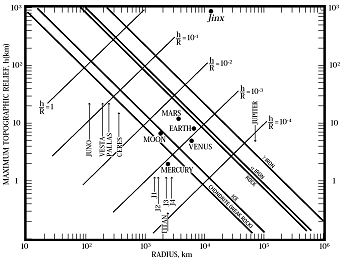
The graph at right gives the “maximum statically loaded topography” supportable by a range of different materials.
Maximum mountain heights in our solar system are roughly as follows:
|
Like all material bodies, mountains are subject to the Square-Cube Law. This principle is, quite simply, that volume increases faster than area as size increases. For a mountain to remain standing and not collapse, it must be strong enough to support its own weight. This weight is distributed over an area. The weight that must be supported, however, increases with the volume. (For example, mountains with eight times more mass have only about four times more base area to support that mass.) Consequently, a mountain should be less capable of sustaining its own bulk as it increases in size.
The maximum height of rocky ranges is therefore proportional to their weight, the product of the mass and the force of gravity (Figure 5.10). Higher gravity planets will have smaller, squatter mountains, because the limits of compressive strength of rock are reached much sooner. At least down to about 0.1 Mearth or so, smaller worlds should tend to have taller formations.
As has been discovered with craters on the bodies in our solar system,1277the height of mountains should statistically vary inversely as the force of surface gravity.*
* Astrogeologists will recognize that I have made a gross oversimplification here. The mountains of large differentiated planets are actually supported by isostatic forces. Only small bodies can accurately be considered to have statically loaded topography.1279
|
Table 5.12 Densities and Compression Strengths 1279,1569,1851,
1853,1854,1855 |
 |
Mountain size will also be related to the compressive and shear strength of the building materials used.1233,1279 The maximum height of ranges will vary approximately linearly with the compression strength (Table 5.12). For Earth mountains, rock is the usual orogen* with a maximum sustainable load of about 107 kilograms/meter2. However, were we to find mountains of carbon dioxide on another planet, the greatest height would be far lower. This is because the compressive strength of “dry ice” is less than 10-30% that of rock.1569
Volcanism could be a peculiar affair on other worlds. On a planet as cold as Titan, for instance, water could be an orogen instead of a thalassogen. If sufficient crustal radioactivity exists, and if the planet is roughly terrestrial-sized, we might observe cold volcanoes spewing forth molten water instead of lava.1947 Dr. Donald M. Hunten, a physicist at the Kitt Peak National Observatory, believes that Titan may possess just such a subsurface magma of liquid water.2046 The magma would lie atop a rocky mantle and would contain large amounts of dissolved ammonia. The relatively thin crust should then be a mixture of methane and water-ice, frozen solid.
A curious phenomenon is the flowing of glaciers (mountains of water-ice). There is some evidence that this may be virtually a unique property of H2O “mountains,” One of the more unusual characteristics of water is its ability to drop its melting point when subjected to pressure. Underneath a glacier pressures rise to hundreds of atmospheres. A lubricating layer of melted ice can form at the base, and the object proceeds to slide downhill on this thin, slippery film of water.
While ice exhibits the freezing point depression effect up to pressures of more than 2500 atm, solid carbon dioxide and other ices cannot duplicate this behavior. Only water-ice will flow rapidly down valleys like rivers. One Alpine formation, the Quarayaq Glacier, is known to flow between 20 and 24 meters per day.1850 (Of course, CO2 glaciers are still subject to slow creep,1569 but this is far less dramatic.)
If mountains are subject to the Square-Cube Law, are not worlds as well? Small, mountain-sized hunks of matter may be very irregular in shape, because the internal stresses are relatively low. But as mass increases, pressures build: Inside any terrestrial planet rock begins to flow and seek a spherical shape — energetically the most stable configuration.
* Derived from the Greek roots, meaning, literally, “something that produces mountains.” I use the word to signify “any substance capable of forming planetary mountains.”
|
Table 5.13 Maximum Size of Oblong (e = ½) Bodies, for Various Orogens1279 |
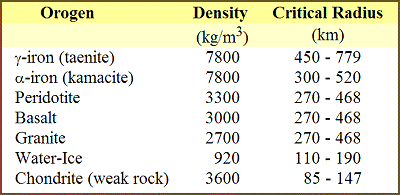 |
Stephen Dole has estimated that the largest mass of a body that can maintain a highly irregular shape is on the order of 10-5 to 10-4 Mearth.214 To get some idea of the degree to which an object may deviate from sphericity, Table 5.13 gives the largest size of a body whose mountains are as tall as the planetary radius itself (the long axis is twice the short). These worlds must be very small to retain their egg-shape.
Finally, returning once again to peculiar surface effects, the astrogeologists may have some real surprises in store for us on other worlds. For example, we know that Venus’ air is deficient in oxygen, and one explanation is that the surface rocks have all been well-oxidized. But at temperatures beyond 620 K and pressures above 50 atm, superheated steam dissolves alumino-silicate rocks. If the oxygen depletion theory is correct, Venus might once have been molten to considerable depths and served as a factory for huge, exquisite gemstones.1293 The surface of the Morning Star may well be studded with garnets, sapphires, rubies and topaz!
|
Figure 5.11 Planetary Mass and Pelagic Worlds367,2044,2046 |
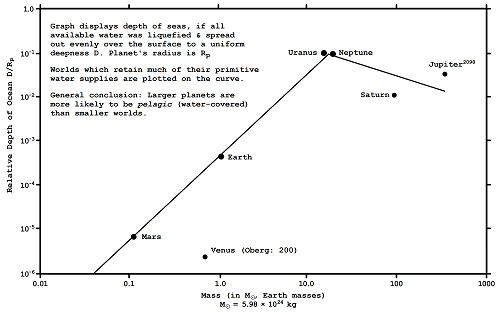 |
We have barely scratched the surface of the total field of general planetology in this brief survey, and most if not all of the discussions have been simplifications of vastly more complicated processes. The concept of habitable zones, for instance, is a very old and respected idea but one which should not be engraved in stone and rendered sacred. Countless ways can be imagined to “beat the heat.” Some of the more obvious of these are surface effects on the planet itself and have nothing to do with the stellar class of the primary.
For example, the greenhouse effect adds about 30 K to Earth’s temperature, and about 500 K to that of Venus. In Titan’s air, methane and hydrogen might trap solar energy and heat the planet significantly. Calculations indicate that if the surface pressure is on the order of 0.1-0.4 atm, the greenhouse effect could easily add 60-110 K. This would raise the temperature at the surface of Titan to 150-200 K.1280,1281 Were Titan at the distance of Jupiter instead of Saturn, another 30 K or so increase could probably be arranged — putting it very close to Mars, temperature-wise. There are indications that even chilly Neptune may have a greenhouse amounting to some 80-90 K.2046
A second warming factor is the presence of small-particle smog suspended in the air of Titan. These darkened organic dust motes can absorb sunlight and transfer still more heat to the surrounding atmosphere.2046 So we see that perfectly valid arguments may be made to extend the outer reach of the habitable zone of Sol as far Jupiter and possibly even Saturn!
What are the limits of mass for habitable planets? Again, the answers don’t come easily. In selecting worlds that might be habitable for human life, Dole set forth the following values: Mass should be greater than 0.4 Mearth, to ensure that a heavy enough atmosphere can evolve and remain trapped, and should be less than 2.35 Mearth, to keep the force of gravity below 1.5 Earth-gees.214 Planetary mass will also affect the likelihood of finding planetwide oceans (Figure 5.11).
While these are useful estimates, they are clearly rather conservative when applied to all ET lifeforms instead of just to humans. Rasool expects that in a few eons, Mars’ atmosphere will thicken sufficiently for it to begin evolving towards a more Earth-like clime.2065 The mass of Mars, however, is only 0.11 Mearth. And while human life may be uncomfortable at more than 1.5 gees, there is absolutely no rationale for using this as the cutoff for all carbon-based intelligent life. Accretion models suggest that terrestrial worlds may form with masses as high as 5-10 Mearth,1258 with surface gravity reaching at least 2.2 gees.
|
Figure 5.12 Tides Raised on an Earthlike Planet by Satellites of Various Masses and Distances |
|||||||
|
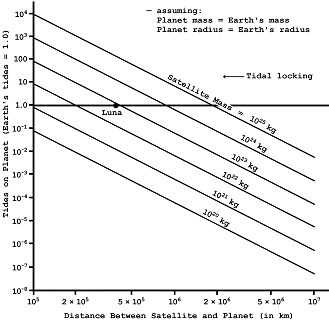 |
Assuming a very homogenous pair of fluid bodies, the tidal height H may be expressed mathematically as:
■ where Mp and Msat are planetary & satellite mass, ■ Rp and Rsat are planetary and satellite radius, ■ rp and rsat are the respective densities, ■ r is the average distance between the two bodies.1980 (Those equations are based on a highly oversimplified model — for fuller treatmentsee Alfvén and Arrhenius1980 or Goldreich and Soter.1243) |
||||||
Another factor we have not really considered is the tides caused by satellites (or by the primary). Tides may occur in the lithosphere and atmosphere, but are most effective when they arise in the hydrosphere — the ocean. A moon which is very massive, or quite close, will tug at its primary much more insistently and raise higher tides (Figure 5.12).
The tides are important because they will alter the erosion of continents, wave motions in the sea, the weather, and so forth. Larger tides will slow the rotation of the planet, depending on the distribution of land masses, and may have enormous implications in the emergence of life from the sea.
There are additional complicating factors. Peculiar tidal resonances are known to occur. For instance, we now know that Mercury is not a one-face planet as was once thought. Instead, it turns on its axis exactly three times for every two trips around the sun. (A case of “spin-orbit coupling.”2048) Venus also appears to be “tidally locked” — but to Earth.2041 The sun must similarly be taken into account. Sol is responsible for only about one-third of Earth’s oceanic tides, but a planet in the habitable zone of a K2 star would experience far greater tides even if it had no moon.
The tilt of the planet’s axis is likewise significant with respect to habitability.* All of the ecospheres computed in this and the previous chapter were based on the assumption of a relatively low inclination to the orbital plane. (Earth is about 23°, which is fairly typical.) A planet with high inclination will have more extreme seasonal temperature variations across its surface. Large tracts of land may become totally uninhabitable, although marginal livability apparently can be retained for tilts as high as 81°.214
The tilt of a world is responsible for its seasons. Planets with 0° inclination should have relatively humdrum, monotonous climates all year long (although an especially eccentric orbit might produce season like effects). With no seasons, there would be no regularly changing weather patterns, no cycles of autumnal death and vernal rebirth in the plant kingdom, no migrations of fish and fowl. The entire rhythm of existence would be lacking, and the influence on culture, religion, philosophy, and the agricultural sciences must necessarily be enormous.
Many rare and exotic environments for life may exist in our Galaxy.214 A “superjovian orbiter” might derive life-giving heat from the gas giant it circled. Inhabitants of this terrestrial world on the side that permanently faced away from the superjovian would scoff at tales of a giant Thing in the sky and reports of strange native religions brought back by intrepid explorers who had visited the other side. (The auroras there should be fantastic, if Io turns out to have beautiful yellow displays as many believe.2047,2090)
| Earth-Moon system, a double planet |
The Earth-Moon system is for all practical purposes a double planet, and it is not unreasonable to suppose that in many stellar systems across the Galaxy two Earths orbit one another. A world with two habitable belts, which might be found nearer the inside edge of the stellar ecosphere, is also a distinct possibility. Only the polar regions could be livable — the tropics would be unbearably hot.
There may be starless worlds, as the late astronomer Harlow Shapley suggested, bodies which lie alone out in the cold of interstellar space.816 Life is possible only if these planets are self-heating.18,2061 (Hal Clement used this idea in his science fiction story entitled “The Logical Life.”)
Perhaps we will find pelagic worlds, or terrestrials with Saturn-like (or Uranus-like) rings, or planets with large liquid bodies at the surface maintained near the triple point of the thalassogen. The ocean would boil furiously while gleaming icebergs floated and tossed on the frothy sea. The possibilities are as limitless as the imagination.
* Orbital eccentricity is also important — e must be less than 0.2 if at least 10% of the surface is to remain human-habitable.214+


